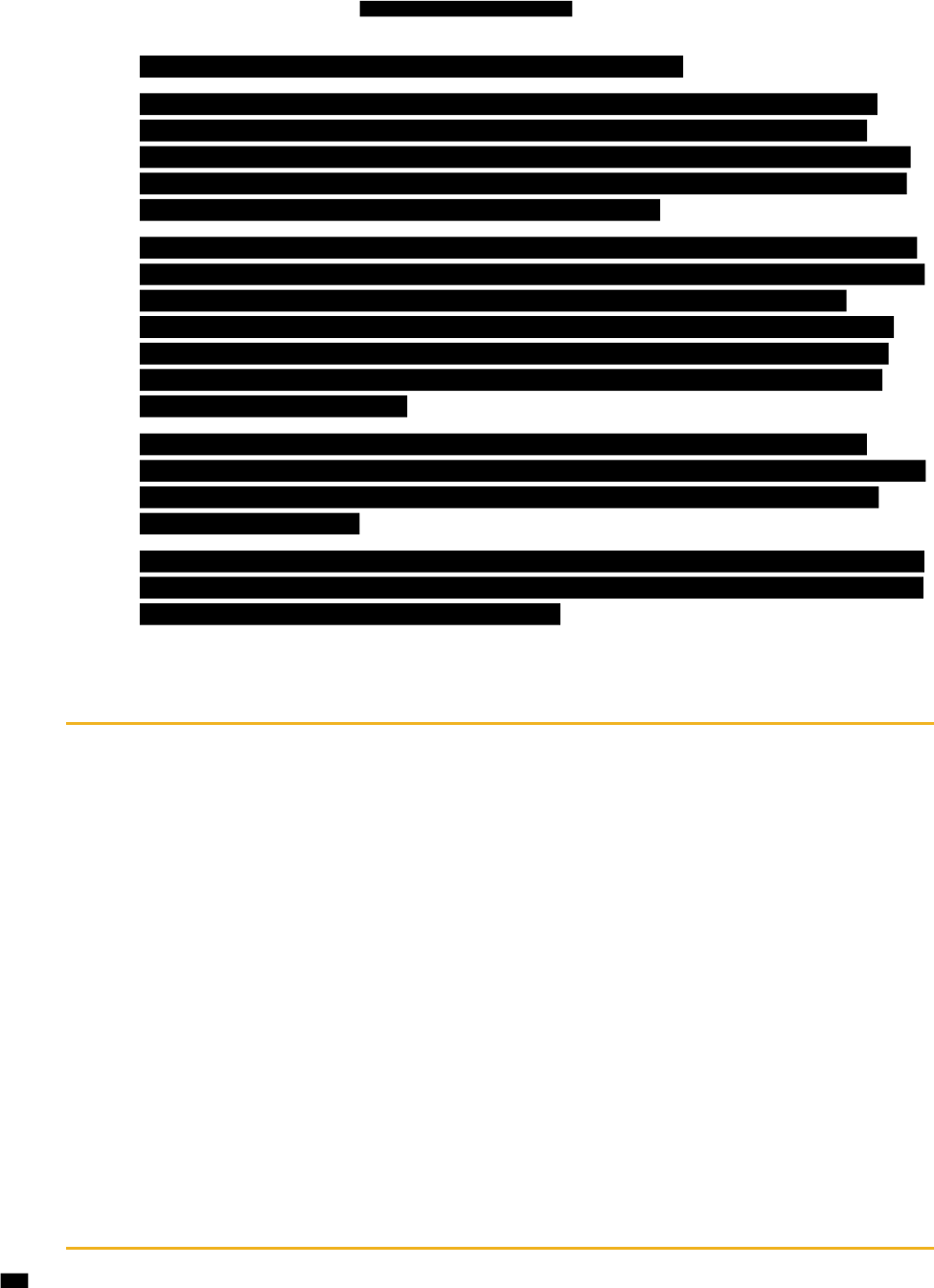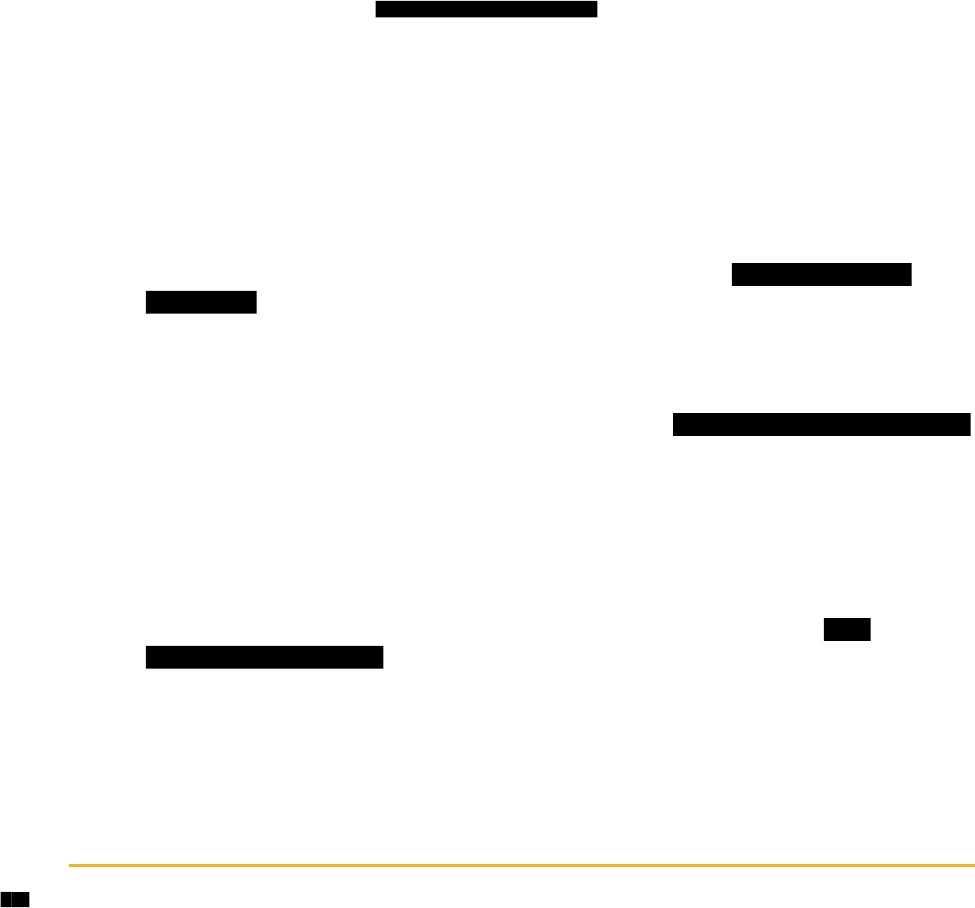
Complaint
Investigation name
Investigation subtitle
Gaia Pope-Sutherland
Investigation into a missing person enquiry by
Dorset Police
>
Independent investigation report

> Investigation information
Investigation name: Gaia Pope-Sutherland
IOPC reference: 2018/100098
Investigation type: Complaint subject to special
requirements
IOPC office: Cardiff
Lead investigator: Martyn Coombe
Case supervisor: Sarah Patten
Director General delegate
(Decision maker):
Mel Palmer
Status of report: Final
Date finalised: 11 November 2019

> Contents
>
Introduction ......................................................................................................... 4
>
The investigation ................................................................................................. 9
>
Subjects of the investigation ............................................................................. 10
>
Policies, procedures and legislation considered ............................................... 11
>
Summary and analysis of the evidence ............................................................. 21
>
The first calls to police ....................................................................................... 22
>
The initial risk assessment ................................................................................ 31
>
Searches by the National Police Air Service (NPAS) ........................................ 39
>
Searches on the ground during the first twenty-four hours ................................ 47
>
Searches on the ground after the first twenty-four hours .................................. 77
>
Liaison between the police and civilian volunteers ............................................ 98
>
The search for Gaia’s phone ........................................................................... 107
>
The arrests and subsequent murder investigation .......................................... 110
>
The discovery of Gaia’s clothing ..................................................................... 118
>
Liaison between the police and the family ....................................................... 128
>
Learning identified during the IOPC investigation ........................................... 145
>
Next steps ....................................................................................................... 148
>
Summary for publication ................................................................................. 148
>
Appendix 1: The role of the IOPC ................................................................... 151
>
Appendix 3: Glossary ...................................................................................... 162

> Introduction
> The purpose of this report
1. I was appointed by the IOPC to carry out an independent investigation into
the Dorset Police response to reports Miss Gaia Pope-Sutherland (referred to
as Gaia in this report) was missing.
2. At approximately 3.40pm
1
on 7 November 2017, Gaia was recorded on CCTV
running south along Morrison Road in Swanage.
3. At 3.42pm, Gaia’s aunt called Dorset Police for assistance. She explained
that Gaia was due to see her GP regarding a referral to the Mental Health
Team, but had run out of the house in search of a childhood friend (referred
to in this report as Male A).
4. A relative of Male A (Female A), later told officers that Gaia arrived at her
house between 3.30pm and 4pm. Female A stated that Gaia was behaving
irrationally and eventually left, saying she was going to see her friend, Female
B. When spoken to, Female B and her family stated that they had not seen
Gaia that day.
5. At approximately 3.59pm
2
, Gaia was recorded on CCTV on Priests Road in
Swanage, walking west towards the outskirts of town.
6. At 4.52pm, Gaia’s mother called Surrey Police
3
to report Gaia missing. During
the call, she stated that Gaia suffered from epilepsy and mental health issues,
and had been sectioned in the past.
7. At 4.57pm, Surrey Police emailed a missing person report to Dorset Police.
8. At 6.15pm, Gaia’s aunt called Dorset Police again to report Gaia missing.
9. At 6.18pm, Dorset Police completed a missing person report based on
information provided by Gaia’s aunt. The report was initially assessed as
medium risk, but was upgraded to high risk at 1.24am on 8 November 2017.
10. In the days that followed, Dorset Police explored a number of different lines of
enquiry in the search for Gaia. Devon and Cornwall Police, Dorset Search
and Rescue (DorSAR), Hampshire and Berkshire Search and Rescue, HM
1
The footage was time-stamped 3.39.57pm, but was later found to be 30 seconds slow, so the
correct time would have been 3.40.27pm.
2
The footage was time stamped 4.54pm, but was later found to be 55 minutes fast, so the correct
time would have been 3.59pm. This footage was discovered after Gaia was found deceased.
3
Gaia’s mother lives in Dorset, but was in the London area when Gaia went missing, so her call was
put through to Surrey Police.

5
Coastguard, Dorset and Wiltshire Fire and Rescue Service (DWRFS) and
members of the public also assisted with the search.
11. On 13 November 2017, officers arrested Male A and Female A on suspicion
of murder. They were released under investigation the following day.
12. On the morning of 16 November 2017, members of the public found Gaia’s
clothing in a field near the cliffs south of Swanage. Later that day, officers
arrested a relative of Male A and Female A (Male B), on suspicion of murder.
He was released under investigation the following day.
13. On 18 November 2017, Gaia was found deceased in dense undergrowth
approximately 300 metres from her discarded clothing, near a coastal path
known as the Zig Zag. She had no injuries to suggest third-party involvement,
and a post-mortem examination concluded that she had died from
hypothermia.
14. On 20 November 2017, Dorset Police confirmed that they would not be taking
any further action against Female A, Male A or Male B.
15. This matter came to the attention of the IOPC on 23 February 2018 as a
Death or Serious Injury (DSI)
4
referral, and the IOPC decided to carry out an
independent investigation.
16. On 2 May 2018, Gaia’s family complained to the IOPC that Dorset Police had
failed to carry out an appropriately prompt and thorough search. The IOPC
investigation was subsequently reclassified as a complaint investigation.
17. Between November 2018 and October 2019, IOPC investigators obtained
accounts from over a hundred witnesses. One of those interviewed was
Constable A, who was an Acting Sergeant when Gaia went missing. Certain
aspects of Constable A’s account were found to be inconsistent with the other
evidence, and on that basis, the IOPC investigation was declared subject to
special requirements
5
on 6 August 2019.
18. In an IOPC investigation, the powers and obligations of the Director General
(DG) are usually delegated to a senior member of IOPC staff, henceforth
referred to as the decision maker. The decision maker for this investigation is
Operations Manager Mel Palmer.
19. In this report, I will provide an accurate summary of the evidence, and attach
or refer to any relevant documents. I will also provide sufficient information to
enable the decision maker to determine:
4
Paragraph 12 of the Police Reform Act 2002 defines a DSI matter as any incident in which a
member of the public has died or sustained a serious injury in police custody, or following police
contact, and where there is an indication that the police contact may have caused or contributed to
the death or serious injury. Schedule 3, paragraph 14C of the Police Reform Act 2002 states that
police forces must refer all DSI matters to the IOPC.
5
Paragraph 19(B), Schedule 3 of the Police Reform Act 2002 states that an investigation will be
declared subject to special requirements if there is an indication that a person serving with the police
may have committed a criminal offence, or behaved in a manner that would justify disciplinary
proceedings.

6
whether the family’s complaints are upheld, where appropriate (i.e.
where this would not intrude on any associated criminal or misconduct
proceedings);
whether any person serving with the police has a case to answer for
misconduct or gross misconduct, or no case to answer, or whether any
such person’s performance was unsatisfactory;
whether disciplinary proceedings should be brought against any person
to whose conduct the investigation related, and the form of any such
proceedings;
whether to refer any matter to the Crown Prosecution Service (CPS)
6
;
whether to make a recommendation to any organisation about any
lessons that may need to be learned.
On receipt of this report, the decision maker will record her opinion on the20.
above matters.
The IOPC will then send a copy of this report and the decision maker’s21.
opinion to Dorset Police, who must advise the decision maker what action, if
any, they will take in response to the investigation findings. If the decision
maker does not agree, she may make recommendations and ultimately
directions for further actions or determinations.
> Background information about Gaia
22.
23.
24.
25.
26.
6
Paragraph 23(2)(b) and (c) of the Police Reform Act 2002 set out the criteria for referral to the CPS.
7
The IOPC has also investigated how Dorset Police dealt with the rape allegation. The findings from
that investigation are outlined in a separate report.
charges. He was
sentenced to two years in prison.
Gaia normally lived with her mother and two sisters in Langton Matravers.
However, in the weeks before she went missing, she stayed with her aunt in
Gaia Pope-Sutherland was born on 22 July 1998. She suffered from severe
epilepsy, exacerbated by stress, for which she was prescribed medication.
She could have up to twenty or thirty seizures a day, and would often
experience periods of confusion and disorientation following major seizures.
In December 2015, Gaia’s sister contacted Dorset Police to report that Gaia
had been raped approximately twelve months ago, at the age of sixteen. At
that time, the suspect was already under investigation by Dorset Police for
offences.
In June 2016, Dorset Police decided to take no further action in relation to
Gaia’s case
7
on the grounds that there was insufficient evidence to support a
prosecution.
Gaia’s alleged rapist pleaded guilty to three unrelated

7
Swanage, and occasionally with her uncle in Bournemouth. She had been
staying with her uncle in the days before she went missing.
27. On 7 November 2017, Gaia was due to meet with the police to discuss an
incident five days before in which a man had sent her sexually explicit images
via Facebook messenger.
28. Gaia’s aunt stated that Gaia began acting strangely at around 3.30pm that
day, and left the house in search of Male A. She stated that she tried to follow
Gaia in her car, but lost sight of her on Morrison Road.
29. Gaia’s family reported that her mental health had deteriorated significantly in
the days leading up to her disappearance. They believe this deterioration was
caused by her anxiety over her alleged rapist’s imminent release from prison,
and was further exacerbated by the incident involving the explicit images.
30. Gaia’s cousin read out a statement on behalf of the family at the opening of
the inquest. She described Gaia as “loving, joyful and brave… a bright and
powerful young woman who wanted to devote her life to others.”
> Complaints made by Gaia’s family
31. Gaia’s family complained that Dorset Police initially failed to recognise that
Gaia was high risk, even though they knew she was vulnerable. They
expressed their belief that Gaia might have been found alive if the police had
treated her as high risk from the outset. They stated that, days into the
search, officers still seemed unaware of the seriousness of her epilepsy.
32. They alleged that the initial risk assessment was influenced by assumptions
about Gaia, stemming from the rape investigation.
33. They further alleged that the police failed to act on critical information
provided by family members, and failed to carry out diligent and thorough
searches of the areas identified. In particular, they stated that Gaia’s mother
and sister told the police at a very early stage that Gaia would be likely to go
to Priests Way and Dancing Ledge. They stated that the police assured them
this area had been searched thoroughly in the first 48-72 hours, using search
dogs and thermal imaging cameras, and that one officer told Gaia’s cousin, “If
Gaia had been there, we would have found her.”
34. The family expressed their distress and concern over how long it took to find
Gaia’s clothes and her body. They stated that Gaia’s clothes were found on a
direct route from where she was last seen, and should have been visible from
the upper coastal path.
35. They further stated that the police initially refused to allow Gaia’s aunt to view
and positively identify the clothes as belonging to Gaia.
36. They alleged that the police failed to organise the searches so that they were
effective, and failed to utilise resources properly. In particular, they alleged
that the police did not liaise properly with the teams of civilians who
volunteered to help. They stated that this was an exceptional and critical
resource which, had it been utilised properly, would have contributed
significantly to the search effort.

8
37. They stated that a Facebook page was set up on 8 November 2017, with a
log of locations that had been searched by civilian volunteers. They stated
that the police refused to look at the Facebook page, and that one officer told
Gaia’s cousin they were “not allowed to use Facebook.”
38. They stated that the police did not contact the civilian volunteers directly until
11 November 2017, and did not give them any clear or concrete instructions
on how best to search. They stated that the police failed throughout to
communicate properly with the civilian search teams, resulting in a chaotic
and disorganised approach to the search.
39. They stated that the police forbade the civilian volunteers from searching rural
areas due to safety concerns, but assured the family these areas had already
been thoroughly searched. The family stated that, given where Gaia was
found, they had no confidence that these areas had been searched properly.
40.
They
alleged that, when questioning Gaia’s sister about Gaia’s whereabouts, an
officer asked her whether she knew “how much money [the search] was
costing”.
41. The family complained that their Family Liaison Officer (FLO) (referred to in
this report as FLO A) did not assist with arranging mental health support for
them, and was often unreachable by phone. They further alleged that he
inappropriately attended Gaia’s aunt’s home on the evening of 17 November
2017, questioned her about footage that had been released to the media,
encouraged her to write and sign a statement about her movements on the
day Gaia went missing, and discouraged her from obtaining legal advice.
42. The family queried whether the arrests on 13 and 16 November 2017 were
lawful. They stated that they were told the police arrested Male A and Female
A because their stories “did not add up”; which turned out to be because the
clock on a CCTV camera was faulty. They stated that the police told them
that, due to a recent change in policy, arresting someone on suspicion of
murder was the only way they could search their address and interview them
over a sufficient period. The family stated that this explanation was confusing,
and suggested that the police did not have reasonable grounds to suspect an
offence. The family expressed the view that the arrests discouraged the
civilian volunteers, and may have had an impact on the police search,
specifically on the deployment of helicopters.
43. Finally, the family alleged that Dorset Police failed to provide accurate
information to them, particularly in relation to Gaia’s final resting place, which
caused them significant distress.
> Appendices to this report
44. Appendix 1 outlines the role of the IOPC.
45.

9
46. Appendix 3 features a glossary of police terms and acronyms that may not be
familiar to the reader.
47.
> The investigation
> Terms of reference
48. Operations Manager Mel Palmer approved the terms of reference for this
investigation on 15 June 2018.
49. On 30 August 2019, the terms of reference were amended to reflect the fact
that the investigation had become a conduct investigation.
50. The terms of reference are as follows:
1. To investigate the Dorset Police response to the missing person report
made in respect of Miss Gaia Pope-Sutherland on 7 November 2017,
specifically:
a) To address the complaints made by Gaia’s family;
b) To examine the actions and decisions of the officers dealing with
the missing person report, up to the discovery of Gaia’s body;
c) To consider whether the missing person report was appropriately
risk assessed, reviewed and resourced; and
d) To consider whether police action was in accordance with
applicable legislation and local and national guidance, policies and
procedures regarding missing persons.
2. To assist in fulfilling the state’s investigative obligation arising under the
European Convention on Human Rights (ECHR) by ensuring as far as
possible that the investigation is independent, effective, open and
prompt, and that the full facts are brought to light and any lessons are
learned.
3. To identify whether any subject of the investigation may have committed
a criminal offence and, if appropriate, make early contact with the
Director of Public Prosecutions (DPP). On receipt of the final report, the
decision maker shall determine whether the report should be sent to the
DPP.
4. To enable an assessment as to whether any subject of the investigation
has a case to answer for misconduct or gross misconduct or no case to
answer.

10
5. To consider and report on whether there may be organisational learning,
including:
whether any change in policy or practice would help to prevent a
recurrence of the event, incident or conduct investigated;
whether the incident highlights any good practice that should be
shared.
> Subjects of the investigation
51. Any police officer, police staff member or relevant contractor whose conduct
is under investigation will be classed as a subject of the investigation.
52. All subjects must be served with a notice of investigation informing them of
the allegations against them, and stating whether the allegations would
amount to misconduct or gross misconduct if proven.
53. Constable A was served with a notice of investigation on 14 August 2019,
worded as follows:
“On the afternoon of 7 November 2017, you were the acting sergeant at
Wareham police station with responsibility for policing of the Wareham and
Swanage areas. During the course of the afternoon you became aware that
Miss Pope-Sutherland was missing, and that [Constable B] was making
enquires in an attempt to locate her.
You have provided two witness statements at the request of the IOPC Lead
Investigator, in which you have detailed your actions on the afternoon and
evening of 7 November 2017.
Following a review of those statements, other documentation and statements
from other officers obtained, it is alleged that:
1. You failed to satisfactorily handover the missing person investigation
into Ms Pope Sutherland to ensure appropriate progress, in that:
2. You failed to inform the covering night shift sergeants in Poole, who
were responsible for policing Wareham and Swanage overnight 7-8
November 2017, that Miss Pope-Sutherland was missing. Neither did
you inform any other supervisory officer, who could have taken the
investigation forward.
3. You failed to appropriately task the Wareham night shift officers with
carrying out any enquires in an attempt to locate Miss Pope-Sutherland.
4. You failed to document and record any enquires you instructed to be
carried out, if indeed you did request any such actions.
If proven, this may amount to a breach of the standards of professional
behaviour in relation to duties and responsibilities.”

11
54. These allegations were assessed as amounting to misconduct if proven or
admitted. IOPC investigators interviewed Constable A under misconduct
caution on 22 August 2019.
> Policies, procedures and legislation
considered
55. During the investigation, I have examined relevant national and local policies
and legislation, as set out below. This information will enable the decision
maker and the appropriate authority to consider whether the officers and staff
named in this report complied with the applicable guidance and legislation,
and whether the existing policies were sufficient in the circumstances.
> The National Decision Model (NDM)
56. The College of Policing is the professional body for people who work in
policing. The College of Policing Authorised Professional Practice (APP) is a
comprehensive body of online guidance on policing. Police officers and staff
are expected to consider the APP when discharging their responsibilities.
57. The APP states that police officers should adopt the following process when
making a decision:
Consider what information and intelligence is available and/or required;
Assess the threat and risk, and develop a working strategy;
Consider what powers and policies apply;
Consider what options are available to resolve the situation with the
least risk of harm, and develop a contingency plan;
Consider whether the decision is consistent with the police Code of
Ethics
8
; and
Take action, review the outcome, and repeat the above stages if
necessary.
58. This process is known as the National Decision Model (NDM).
> The College of Policing Authorised Professional Practice
(APP) on Missing Persons
8
The Code of Ethics was produced by the College of Policing as a code of practice under section 39A
of the Police Act 1996 (as amended by section 124 of the Anti-Social Behaviour, Crime and Policing
Act 2014). It sets and defines the standards of behaviour for everyone who works in policing.

12
59. The College of Policing APP on Missing Persons
9
states that anyone whose
whereabouts cannot be established will be considered missing until they are
located, and their well-being or otherwise confirmed.
60. The APP states that a missing person should be graded as medium risk if the
risk of harm to the subject or public is deemed likely but not serious. It states
that this category requires an active and measured response by the police
and other agencies, in order to trace the missing person and support their
family.
61. The APP states that a missing person should be graded as high risk if the risk
of serious harm to the subject or public is deemed very likely. Risk of serious
harm is defined as “A risk which is life threatening and/or traumatic, and from
which recovery, whether physical or psychological, can be expected to be
difficult or impossible.”
62. The APP states that a high risk case requires the immediate deployment of
police resources, although action may be delayed in exceptional
circumstances, such as when searching water or forested areas in darkness.
63. The APP states that, in high risk cases, a member of the senior management
team must be involved in setting initial lines of enquiry and approving staffing
levels. It further states that an Investigating Officer (IO), a Police Search
Adviser (PolSA), and possibly a Senior Investigating Officer (SIO) should be
appointed, family support should be put in place where appropriate, and the
NCA Missing Persons Bureau (MPB) should be notified “without undue
delay”. A missing person process chart outlines the appropriate police
response to the different risk categories .
64. The APP states that certain minimum actions should be undertaken in all
cases, including completing a risk assessment, and creating and recording a
plan of immediate actions.
65. It states that police forces must submit case details to the MPB in all cases
where the person is still missing after 72 hours. If a case is of particular
concern (for example, if a serious crime is suspected or if there is significant
public or media interest), the MPB should be notified immediately.
66. The APP states that, in such cases, police forces should also consider
contacting the National Crime Agency (NCA) Specialist Operations Centre
(SOC), for support and expert advice.
67. The APP lists charities that can provide families with advice and support,
including Missing People, the Lucie Blackman Trust, the Samaritans and
Mind.
68. The APP on Risk Assessment
10
states that risk assessments should be
based on current risk levels, and should not be driven by previous
assumptions or experiences.
9
College of Policing APP, Missing Persons, www.app.college.police.uk/app-content/major-
investigation-and-public-protection/missing-persons/, accessed on 2 April 2019.
10
College of Policing APP, Risk Assessment, www.app.college.police.uk/app-content/major-
investigation-and-public-protection/missing-persons/risk-assessment/, accessed on 3 April 2019.

13
69. The APP on Missing Person Investigations
11
states that the first officer
deployed to a report of a missing person should (among other things):
Gather sufficient information about the missing person to enable an
effective and thorough investigation to be conducted;
Consider taking a full statement from the person making the report
and/or the last person to see the missing person;
Conduct initial searches of relevant premises, and record the extent
and nature of any searches;
Obtain details of the individual’s mobile phone and, if they have the
phone with them, arrange for a TextSafe
©
message to be sent;
Consider the need for specialist officers or resources; and
Circulate details of the missing person to officers and relevant local
partners, such as hospitals, the ambulance service, taxi firms and bus
firms.
70. The APP states that first-line supervisors should (among other things):
Review the risk assessment;
Allocate sufficient resources to pursue an effective investigation, and
ensure that appropriate actions are taken to locate the missing person
without delay;
Consider the need for an early media release where appropriate;
Consider involving a detective, a PolSA, a senior management team
and child-specific services; and
Consider the need for a multi-agency response.
71. The APP states that a supervisor should ensure the case is reviewed and the
risk reassessed at regular intervals, taking account of any new information.
The frequency of reviews will depend on the circumstances of the case.
72. The APP further states that the Investigating Officer should seek advice from
a PolSA as necessary when developing the search strategy.
>
11
College of Policing APP, Missing Person Investigations, www.app.college.police.uk/app-
content/major-investigation-and-public-protection/missing-persons/missing-person-investigations/,
accessed on 3 April 2019.

14
> The College of Policing APP Risk Principles

15
80. The Risk Principles
12
are a set of ten principles that are intended to support
decision makers and help them to make decisions about risks with greater
confidence. They are as follows:
1. The willingness to make decisions in conditions of uncertainty (i.e., risk
taking) is a core professional requirement of all members of the police
service.
2. Maintaining or achieving the safety, security and wellbeing of
individuals and communities is a primary consideration in risk decision
making.
3. Risk taking involves judgement and balance. Decision makers
are required to consider the value and likelihood of the possible
benefits of a particular decision against the seriousness and likelihood
of possible harm.
4. Harm can never be totally prevented. Risk decisions should, therefore,
be judged by the quality of the decision making, not by the outcome.
5. Making risk decisions, and reviewing others’ decisions, is difficult and
should take into account whether the decisions involved dilemmas or
emergencies, or were part of a sequence of decisions, or might
appropriately be taken by other agencies.
6. The standard expected and required of members of the police service
is that their risk decisions should be consistent with those that a body
of officers of similar rank, specialism or experience would have taken
in the same circumstances.
7. Whether to record a decision is a risk decision in itself, which should
be left to professional judgement. The decision on whether to make a
record, and on the extent of that record, should be made after
considering the likelihood of harm occurring and its seriousness.
8. To reduce risk aversion and improve decision making, policing must
learn from successes as well as failures. Good risk taking should be
identified, recognised and shared.
9. Since good risk taking depends on quality information, the police
service will work with partner agencies and others to share relevant
information about those who pose risk or those who are vulnerable to
the risk of harm.
10. Members of the police service who make decisions consistent with
these principles should receive the encouragement, approval and
support of their organisation.
> Dorset Police Missing Persons Policy and Procedure
12
College of Policing APP, Risk Principles, www.app.college.police.uk/app-content/risk-2/risk/,
accessed on 2 April 2019.

16
81. Section 3.1 of this policy (Definitions) states that anyone whose whereabouts
cannot be established will be considered missing until they are located, and
their well-being or otherwise is confirmed.
82. Section 3.2.1 (Categories of Missing Person) states that missing persons can
generally be categorised as follows:
1) Any child under the age of 18 whose whereabouts cannot be
established, or who is not at a place where they are expected;
2) A lost person who is temporarily disorientated and would wish to be
found;
3) A person who has voluntarily gone missing who has control over their
actions, and who has decided upon a course of action; or
4) A person under the influence of a third party who has gone missing
against their will, such as an abduction or murder victim.
83. Section 3.3 (Roles, Responsibilities and Assessment of Risk) states:
“All staff taking or reviewing a report of a missing person must start with the
viewpoint that it is a potential serious crime enquiry. All aspects of a missing
person enquiry must be dealt with expeditiously, particularly the interviewing
of witnesses and the searching of relevant addresses and place last seen or
last known place. It is essential that such enquiries focus on identifying
factors which may give cause for concern, e.g.:
behaviour out of character
no property/cash missing
signs of violence
previous history of domestic abuse
indicators of honour based violence/forced marriage
demeanour around time of disappearance
recent Internet activity prior to disappearance
Deteriorating mental health”
84. Section 3.3.1 (Role of Call Taker) states that when someone is reported
missing, the Call Taker will create a missing person report and alert the Force
Command Centre (FCC) supervisors, who will then conduct an initial risk
assessment in line with the NDM (see above) and determine whether the
person is high, medium or low risk.
85. Section 3.3.3 (Assessment of Risk) states that the Critical Incident Inspector
must conduct a further risk assessment within the next six hours.
86. Section 3.3.4 (The Risk Assessment Table) states that risk assessments
should be guided by the College of Policing risk principles, the NDM and the
Police Code of Ethics
13
.
87. The policy definitions and recommended responses for high and medium risk
missing persons mirror those in the College of Policing APP (see above).
88. Section 3.4.1 (Role of Force Incident Commander (FIC)) states:
13
The Code of Ethics sets and defines the standards of behaviour that are expected of everyone who
works in policing.

17
“The FIC, or delegated officer, based within the Force Command Centre, will
be responsible for detailing the initial pro-active enquiries in relation to all
missing person reports. The FIC will initially act as 'silver commander'. While
they will retain the initial accountability for progressing the enquiry it may be
appropriate for them to appoint 'bronze' leads for different elements of the
investigation such as a bronze search, bronze financial or bronze media. The
FIC must ensure that progress is being made with the established lines of
enquiry, maintaining regular contact with the Critical Incident Inspector.”
89. Section 3.4.2 (Role of Critical Incident Inspector (C2/D2)) states:
“The Critical Incident Inspector (C2/D2) covering the area the person is
reported missing from will play a pivotal role overseeing the investigation.
This will include taking responsibility for ensuring clear delegation of tasks,
investigative supervision, recording conventions, effective handover and
oversight at the Daily Management Meeting process. It must be clearly
recorded at all times who is controlling a missing person enquiry. The original
reviewing Critical Incident Inspector should, where possible, complete all
subsequent reviews to provide continuity and consistency.”
90. Section 3.5.1 (Homicide) states:
“One of the fundamental facts to be determined in a missing person
investigation is the reason why the subject has disappeared. In cases where
the circumstances are suspicious or are unexplained, use the maxim:-
IF IN DOUBT, THINK 'MURDER, CHILD AND ADULT SAFEGUARDING
AND INVESTIGATION'.
Failure to apply such thinking in past cases has led to the loss of valuable
investigative opportunities. This can ultimately result in failure to trace the
missing person or to establish sufficient evidence to convict a perpetrator.”
91. Section 3.6.2 (Use of Police Search Advisors (PolSAs)) states:
“PolSAs should be consulted in all high risk cases unless it is immediately
apparent that a search is not relevant at that point, e.g. the missing person
was seen to leave in a vehicle and it has not yet been located. PolSA should
be liaised with when the vehicle is located, as there is strong evidence that
the missing person will be located with the vehicle.
There has been considerable research into the behaviour of missing persons
that have produced some compelling statistics about the distance different
people are likely to have travelled and areas that they may gravitate towards.
Through this knowledge, training and experience PolSAs are able to provide
informed advice and where appropriate will plan and direct searches.
A PolSA may deem the incident suitable for the involvement of Dorset Search
and Rescue (DorSAR) who are a team of highly-trained volunteers who can
provide additional personnel and resources to a Police-led search and can
deploy to anywhere in the County within 2 hours.
Use will be made of dogs, helicopter and the marine section if deemed
necessary.
PolSAs have overall direction of the search and will compile the search plan.
They are responsible for directing all search assets and those persons
deployed.”

18
92. Section 3.6.3 (Lost Person Search Manager (LPSM)) states that the LPSM’s
duties and responsibilities include the following:
Review the log/occurrence and produce a search strategy identifying
areas for IVCs and searches;
Task police or volunteer search assets with specific search areas;
Attend the scene and liaise directly with search assets on the ground
(although IVCs should not be delayed pending arrival of the LPSM);
Record the results of these searches and keep the Critical Incident
Inspector updated;
Provide a full hand on to a PolSA if needed, or to another LPSM if
approaching the end of a shift; and
Review any outstanding high risk missing person within 24 hours, or at
the request of the Critical Incident Inspector/FIC/SIO.
93. Section 3.7 (Media) states:
“Involving the public can have positive results in locating missing people and
should be considered at an early stage. However, every case should be
judged on its own merits as there is a delicate balance to be struck in
appealing through various channels including the media for help in tracing
missing people. It should be considered that public appeals can have lasting
repercussions for victims and their families if they are prepared too hastily.”
>

19
98.
> The police power of arrest
99. Section 24(2) of the Police and Criminal Evidence Act (PACE) 1984 states
that a constable may arrest anyone whom he has reasonable grounds to
suspect of having committed an offence.
100. Section 24(4) states that the power of arrest is exercisable only if the
constable has reasonable grounds for believing that an arrest is necessary,
for any of the reasons listed under Section 24(5). These reasons include:
To allow the prompt and effective investigation of the offence or of the
conduct of the person in question;
To prevent the person in question causing physical injury to himself or
any other person;
To prevent the person in question causing loss or damage to property;
or
To prevent any prosecution for the offence from being hindered by the
disappearance of the person in question.
> HM Coastguard search procedures
101. HM Coastguard guidance on Land Search Planning states:
“Hasty Search
A hasty search is a swift, non detailed pass through an area or segment. The
searchers will be looking for a fairly obvious target or clues rather than

20
detailed investigation. This is a balance between early target detection and
life saving with lower POD
14
against higher a [sic] POD associated with a
more detailed search which will clearly take more time to plan and execute.
It is the usual initial response search type and is an acceptance of a
decreased POD against early detection and could equate to a search of the
'spokes' of the bike wheel.
Purposeful Wandering
This involves a closer examination of all the most likely areas and spots,
looking for the target and clues.
More thorough than a hasty search, it can still cover a relatively large area
and allows searchers to 'wander' within their search pattern and investigate
likely spots. The search is normally conducted in a line abreast format. The
maintenance of search discipline is important, with particular attention being
paid to spatial awareness between searchers i.e. how far is it estimated that a
searcher could actually see the target.”
> Family Liaison Officer (FLO) Guidance
102. This national guidance document was produced
by the National Policing
Improvement Agency (NPIA)
15
in 2008, on behalf of the Association of Chief
Police Officers (ACPO)
16
.
103. It states that an FLO’s role is to manage interaction with the family in an
investigation, and to liaise with the Senior Investigating Officer (SIO) to
ensure that families are treated appropriately, professionally and with respect
for their needs. However, as family members often hold vital information
about a victim’s lifestyle and associates, an FLO is also responsible for
gathering material and information that may assist the investigation.
104. The guidance states that FLOs will routinely take identification and
antecedent statements, but should only be tasked to conduct an interview
with a family member who is a significant witness after careful consideration
of the following:
Whether the FLO has the skills to conduct such an interview;
The extent to which the FLO’s position with the family is likely to be
compromised by the need to challenge the witness’s account;
Whether the FLO’s knowledge of the case might inadvertently
contaminate the interview process; and
Whether it is reasonable and realistic to expect the FLO to remain
sufficiently objective in view of the particular circumstances of the case.
105. The guidance states that, to establish trust, unrealistic promises should not
be made to the family, and it is vital that any commitments or assurances are
14
Probability of Detection.
15
The NPIA was dissolved in October 2013 and replaced by the College of Policing and the National
Crime Agency.
16
ACPO was replaced by the National Police Chiefs’ Council (NPCC) in 2015.

21
met. If a commitment cannot be honoured, this must be documented and a
timely explanation provided.
106. The guidance states that the family may require support and assistance with
a variety of issues, such as trauma arising from bereavement, funeral
arrangements, financial or legal advice, health or social services. The
guidance states that the nature of support required will vary considerably,
depending on the family’s individual needs, and as such, the family should be
fully involved in the decision-making process.
107. Appendices 6 and 7 to the guidance list various support organisations, most
of which are not necessarily relevant to a missing person enquiry. Appendix 6
states:
“If families are reluctant or unwilling to accept offers of help from [these]
organisations… FLOs should be proactive in seeking out and establishing
alternative support for families. There are other statutory and voluntary
organisations, community interest and religious groups that will be able to
offer practical support, help and, in some cases, counselling services. FLOs
should share this information with the families and assist the family to make
contact with such organisations if they so desire.”
> Summary and analysis of the evidence
> Introduction and overview
108. Gaia was reported missing on 7 November 2017. At that time, Dorset Police
had 63 live missing person cases, 11 of which were reported that same day.
Of the 11 reported that day, four were assessed as high risk, and five as
medium risk.
109. Dorset Police received a further 18 missing person reports between 6.15pm
on 7 November 2017 and midnight on 9 November 2017. Eight of those were
assessed as high risk, and three as medium risk.
110. In the ten days that followed, Dorset Police received a further 137 missing
person reports. Of these, 41 were assessed as high risk and 61 as medium
risk.
111. Dorset Police, DorSAR, DWRFS and HM Coastguard covered 2.5 square
kilometres (km
2
) of ground on foot during the search for Gaia, and National
Police Air Service (NPAS) and drone searches covered a further 40km
2
of
open ground. HM Coastguard searched 15km of coastline, and specialist dive
teams searched ten bodies of water. The search also covered 4.5km of
railway lines, and 25km of tracks and footpaths. It was estimated that over
1000 individual officer hours were spent searching for Gaia.
112. In addition to physical searches, Dorset Police pursued a number of other
lines of enquiry, including media appeals, hospital checks, house-to-house
enquiries, vehicle stop checks, enquiries with people known to Gaia and

22
people she might have encountered after going missing, online research,
financial checks, premises searches, and analysis of mobile phone data.
Dorset Police also investigated numerous reported sightings.
113. This investigation has not identified any evidence to suggest that a more
concentrated approach to these additional lines of enquiry might have
resulted in Gaia being found alive. Nor did our investigation identify any
notable individual or organisational failings in these areas. Accordingly, this
report will focus on certain key aspects of the search, including the initial
police risk assessment, the action taken during the first twenty-four hours, the
searches of the area where Gaia was eventually found, the arrests on 13 and
16 November 2017, and whether these arrests had any impact on the search
for Gaia.
114. The following summary does not reflect all of the material that was gathered
during this investigation; nor does it reflect the full magnitude and scope of
the search for Gaia.
115. On receipt of this report, the decision maker will record her opinion on
whether the family’s complaints are upheld, where appropriate, and on
whether Constable A has a case to answer for misconduct, and on whether
there is any evidence of unsatisfactory performance by any person serving
with the police.
116. The threshold test for a finding of case to answer is whether a reasonable
tribunal, properly directed, could reach a finding of misconduct or gross
misconduct on the balance of probabilities. I will not reach any determinative
findings in relation to misconduct or performance in this report.
> The first calls to police
> Contemporaneous evidence
117. At 4.13pm on 2 November 2017, Gaia called 101 to report that a man had
sent her sexually explicit images after she accepted a Facebook friend
request from him. A log was created in respect of her call, reference 345, and
arrangements were made to speak to her on 7 November 2017
17
.
118. At 12.10pm on 7 November 2017, Gaia’s aunt called Dorset Police to make
arrangements to bring Gaia to the police station. The Call Handler was
unable to find the log from 2 November 2017, so created a new log with
reference number 160. During this call, Gaia could be heard in the
background in apparent distress.
17
They did not set a time. It was agreed that Gaia’s aunt would take Gaia to the police station at
some point in the afternoon; when Gaia became distressed, her aunt suggested waiting to see if she
was well enough to attend the police station after her 5pm GP appointment.

23
119. At 12.32pm, log 160 was updated to reflect that it was a duplicate. The
update included the reference number for the original log (reference 345).
120. At approximately 3.40pm, footage from a CCTV camera on Morrison Road in
Swanage shows Gaia running in the direction of Male A’s address.
121. At 3.42pm on 7 November 2017, Gaia’s aunt called Dorset Police to request
assistance.
122. She told the Call Handler that Gaia was a rape survivor, who had recently
been sent images that triggered an episode of mental ill health. She stated
that Gaia had just run out of her house “on some delusion, having
remembered some friend not far away, whose baby she thinks she’s carrying,
she’s not at all, I mean she hasn’t been in touch with this friend for months…”
123. Gaia’s aunt told the Call Handler she needed help to ensure Gaia attended
an appointment with her GP, regarding a referral to the Mental Health Team.
She then said she was about to go into another address (she did not say
where) in case Gaia was there.
124. The Call Handler offered to wait on the line to see if Gaia was there before
sending officers out. Gaia’s aunt replied, “I'm just checking, hang on... if I've
got no reply here I shall be returning home in case she's gone back to me.” At
this point the call ended; it is not clear whether this was because Gaia’s aunt
hung up, or because reception was lost.
125. At 3.50pm, the Call Handler recorded on log 345 from 2 November 2017 that
Gaia had just run out of the house. The same entry appeared on the duplicate
log, reference 160.
126. At 3.54pm, this information was passed to officers in the local area, along
with a description of Gaia.
127. Footage from a CCTV camera on Priests Road in Swanage shows Gaia
walking west towards the outskirts of town at approximately 3.59pm. This
footage was discovered on 19 November 2017, the day after Gaia was found
deceased.
128. Gaia’s aunt called Dorset Police again at 4.37pm, and spoke to Dispatcher A.
She explained that she was calling to check whether police were searching
for Gaia, as she had not heard anything. She stated that the previous Call
Handler had taken her number and told her somebody would call her
18
.
129. Dispatcher A asked Gaia’s aunt if she had called earlier to report Gaia
missing, and she replied that she had. Dispatcher A then took Gaia’s aunt’s
name, her location, Gaia’s name and age, and the time of her last call.
130. Dispatcher A clarified that Gaia’s aunt had called earlier to report Gaia
missing. Gaia’s aunt replied, “Well, just that she’d ran out and it’s a mental
health issue, we’ve got an appointment at the doctor’s at five o’clock, erm, to
refer to mental health services, and I was, I was going to pass on a message
that could they please take her straight to the medical centre in Swanage and
18
The previous Call Handler did not take Gaia’s aunt’s number, and did not tell her someone would
call her back.

24
I’ll meet them there, but I can’t get hold of anybody, and it really panics me
when I manage to get through and people say there’s no record, and I just,
my whole day’s been like this today.”
131. Dispatcher A then took further details, including a description of Gaia.
132. Gaia’s aunt informed Dispatcher A that Gaia was a survivor of rape, and was
“very mentally unwell” and suffering an “episode or decline”. She stated that
Gaia had run out of the house on impulse, and that her short-term memory
was very poor. She stated that Gaia had no phone with her, and no friends in
the area, and that she did not know where she might have gone.
133. Dispatcher A asked whether Gaia had ever self-harmed or attempted suicide
before, and Gaia’s aunt replied, “Not to my knowledge, not to my knowledge,
I mean she has, she’s very emotional at the moment, she’s got a lot of anger
inside her, a lot of upset, she did say, she did shout out this morning, “I hate
this life, which I haven’t heard before.”
134. Dispatcher A stated that she would try to find the record of Gaia’s aunt’s
earlier call “and broadcast it to see if we can get an officer to go round and
have a look around the town for her”.
135. Dispatcher A then informed Gaia’s aunt that she had found the log for her
earlier call, and that the reference number was 160. Following this, both
parties ended the call.
136. Dispatcher A did create a written record of this call, as per standard
procedure
19
. She summarised the call as follows:
“Further call re concern for niece Gaia pope aged 19. Inft has been out
searching for Gaia who has an appt at 1700 at Swanage medical centre to try
and obtain some help for MH issues. Inft has searched around the town,
Gaia’s HA in Langton Matravers, and has contacted the medical centre to see
if she has turned up for her appointment. Gaia does not have a phone, her
memory is poor and is currently mentally unstable. She has not previously
self-harmed as far as inft is aware, but is very angry and said 'i hate this life'
earlier today. Inft asking if there is any update from police. Please
rebroadcast desc.”
137. Dispatcher A graded the record as high priority, and categorised it as a
concern for welfare. She then linked the record to the duplicate log, 160.
However, she did not create a fresh incident log, and did not record any
details of the call on log 345 from 2 November 2017. Hers was the last entry
recorded on log 160.
138. At 4.52pm, Gaia’s mother called Surrey Police to report Gaia missing. Entries
on the Surrey Police log state:
Gaia was last seen approximately ten minutes ago, at which time she
had said she was going to see Female B.
19
When a member of the public is put through to a call handler after calling 101 or 999, the call
handler will create a written record of that call even if it is not a police matter. If it is a police matter,
the call handler will create an incident log or a NICHE occurrence and the information will be
transferred across. If there is already a log open, a written record of the call will still be created and
the details added to the log.

25
She had been diagnosed with Post Traumatic Stress Disorder (PTSD)
following a rape, and had recently received “awful messages” and an
explicit image from the alleged rapist
20
online.
She was psychotic, and had been sectioned numerous times in the
past. She was taking medication for her mental health issues.
She posed a danger to herself, as she was epileptic and suffered from
chronic seizures.
She was very emotional, and it was out of character for her to go
missing.
139. An entry on the Surrey Police log at 4.57pm states, “Dorset advised to email
this report over and it will be picked up urgently.”
21
140. At 4.58pm, Gaia’s aunt called Dorset Police again and stated:
“I want to know there’s somebody helping me find my niece. She’s got mental
health issues, she’s rushed out of the house, we need to get her to the
medical centre in Swanage who were expecting her at five o’ clock, but
they’re there till about six o’ clock. Erm, and she was last seen wandering up
[the street where Female B was living at the time].” She stated that this would
have been about an hour ago.
141. Gaia’s aunt reiterated that Gaia was a rape survivor and “very unwell”. She
stated that nobody had contacted her, she had not seen any police officers,
and she felt “completely in the dark”.
142. The Call Handler stated that they would update the incident with details of the
last sighting, and would “pass it on to our officers to make some further
enquiries in the area there”. The Call Handler further confirmed that Dorset
Police had been “making enquiries on the incident” and “contacting various
people”.
143. Gaia’s aunt asked if someone could call her back, and the Call Handler
confirmed that they would request this. They then ended the call.
144. At 4.59pm, Surrey Police forwarded the log of Gaia’s mother’s call to Winfrith
Control Room, marked as high importance.
145. At 5.02pm, a member of staff in Winfrith Control Room forwarded the Surrey
Police log to the Control Room Supervisor.
146. An entry on the Dorset Police log (reference 345) at 5.04pm states that
Gaia’s aunt had called again to say she believed Gaia was going to see
Female B.
147. A further entry at 5.15pm states:
“Email has been received from Surrey Police as Mispers
22
[sic] mother has
called in to them as she is in the London area at this time, reporting the same
- mother is nd can be contacted on they
20
The person who sent the messages and image was not the alleged rapist. Nonetheless, this
incident caused Gaia significant distress, and family members believe it contributed to her mental and
emotional state on the day of her disappearance.
21
It appears the intended meaning was: “Dorset advised us to email this report over” rather than
“Dorset was advised to email this report over”.
22
A police shorthand term for missing person.

26
believe that she [Gaia] may be at [Female B’s address], can we please ask a
unit to attend that address in the first instance before we record her as a
Misper. Email from Surrey has been attached to the occ.”
23
148. An entry at 5.20pm states that Constable B had spoken to Female B
24
, who
had said she had not heard from Gaia in years.
149. An entry at 5.25pm states:
“HSO
25
noted - can a call handler please be allocated to call the aunt who last
saw Gaia to complete a Misper RI [sic – RA, i.e. risk assessment] on a new
incident please.”
150. An automated entry at 5.31pm states:
“HSS
26
message received and dealing.”
151. An entry at 5.48pm states:
“Have called [Gaia’s aunt] to complete Misper RA but she advised me she
couldn't do it at that moment as she was on the phone to someone she
believed had a lead on where Gaia is. She states she will call back as soon
as she can to complete the RA.”
152. An entry at 6.11pm states that a new missing person log should be created
when Gaia’s aunt called back.
> Account provided by Dispatcher A
153. Dispatcher A provided a statement to the IOPC on 22 October 2019.
154. She stated that she formed the opinion Gaia’s aunt was calling to report a
concern for welfare, as she said she was calling about a mental health issue
rather than a missing person. She stated that, when she asked whether
Gaia’s aunt had reported Gaia missing earlier, she replied, “Well just that
she’d ran out and it’s a mental health issue, we’ve got an appointment at the
doctors at five o’ clock”.
155. She stated that she formed the opinion Gaia’s aunt was worried about Gaia
running around town and potentially missing her GP appointment.
156. She stated that she believed log 160 was the log relating to Gaia’s aunt’s
earlier call, as it included an entry referencing that call. She stated that she
recorded details of Gaia’s aunt’s call on this log, and requested that Gaia’s
details be re-broadcast for the attention of officers in the Purbeck area.
23
Occurrence (i.e. the incident log).
24
Female B and her father subsequently provided statements to Dorset Police. Female B’s father
stated that he and Female B went out to lunch at approximately 12.30pm on 7 November 2017,
following which she returned home and he went shopping. He stated that Female B was at home
when he returned at approximately 4pm, and that she went out to work at approximately 5.30pm, and
shortly after that, Gaia’s aunt came to the address looking for Gaia. Both confirmed Gaia did not come
to their house that day.
25
“HSO” or “HSS” is the code for the “top table” in the Control Room, where the FIC, the Deployment
Manager and the FIB24 DS sit.
26
See previous footnote.

27
157. She stated that she had received no training on missing persons or calls
reporting a concern for welfare.
> Account provided by the Control Room Supervisor
158. The Control Room Supervisor provided a statement to the IOPC on 18 June
2019.
159. He stated that he spoke to Gaia’s mother at 5.15pm, following receipt of the
email from Surrey Police, and she asked him to speak to Gaia’s aunt.
160. He stated that he then attached the email from Surrey Police to the pre-
existing log of 2 November 2017, and tasked an officer to speak to Female B.
He stated that he was subsequently told that Gaia was not with Female B,
and at 5.25pm, he requested that a risk assessment be undertaken. He
stated that he also alerted the Control Room “top table”, who picked up the
log at 5.31pm.
161. He stated that a missing person log was created at 6.18pm, and he added the
information from Surrey Police to the Reports tab on that log.
162. He stated that he was aware Surrey Police had graded the call as high risk;
however, Dorset Police had to complete their own risk assessment based on
information gathered by officers at the scene. He stated that he did not flag
the email to the Force Incident Commander (FIC), “because the risk
assessment was in hand”.
163. He stated that the FIC would have been aware of the information when he
completed the risk assessment, as he recorded his decision and rationale on
the log of 2 November 2017, as well as on the missing person log.
> Analysis of the evidence
164. At 3.42pm, Gaia’s aunt called Dorset Police to request help in ensuring that
Gaia attended a GP appointment. She explained that Gaia had just run out of
her house “on some delusion, having remembered some friend not far away,
whose baby she thinks she’s carrying, she’s not at all, I mean she hasn’t
been in touch with this friend for months…”
165. She provided some information about Gaia’s history, vulnerability and current
mental state, but overall, her comments to the Call Handler suggested that
she was not particularly concerned at that stage. She informed the Call
Handler that she was looking for Gaia at another (unspecified) address,
following which she intended to return home in case Gaia was there. The Call
Handler offered to wait on the line to see if Gaia was at the address before
sending officers out, but the call ended shortly afterwards.
166. At 3.50pm, the Call Handler recorded on a pre-existing log (relating to Gaia’s
complaint about being sent sexually explicit images) that Gaia had just run
out of the house. This information was passed to officers in the local area.

28
167. Because the Call Handler did not create a new log, Gaia’s aunt’s call was not
graded, no risk assessment was undertaken, and officers were not formally
tasked with making enquiries.
168. The College of Policing APP on Missing Persons states that anyone whose
whereabouts cannot be established will be considered missing until they are
located, and their well-being or otherwise confirmed. This definition has been
adopted by Dorset Police.
169. Dorset Police missing persons policy states that when someone is reported
missing, the Call Handler will create a missing person report and alert FCC
supervisors, who will then conduct an initial risk assessment and determine
whether the person is high, medium or low risk.
170. It was arguably apparent from Gaia’s aunt’s call at 3.42pm that Gaia’s precise
whereabouts were unknown. However, she mentioned various locations
where Gaia might have gone
27
. She also did not express any specific
concerns for Gaia’s wellbeing at that time, and the call recording indicates
that her primary concern was that Gaia might miss her GP appointment.
171. It will fall to the decision maker to consider whether Gaia should have been
treated as a missing person at this stage.
172. At approximately 3.59pm
28
, Gaia was caught on CCTV on Priests Road,
heading west towards the outskirts of town. This was the last verified sighting
of Gaia, before she was found deceased.
173. At 4.37pm, Gaia’s aunt called Dorset Police again, and spoke to Dispatcher
A. She stated that Gaia had run out of the house on impulse, and that she did
not know where she was. She explained that Gaia was a survivor of rape,
and was “very mentally unwell” and suffering an “episode or decline”, and that
her short-term memory was very poor. She further stated that Gaia had no
phone with her, and no friends in the area. Later in the call, she stated that
Gaia was very emotional and had “a lot of anger inside her, a lot of upset”,
and had shouted “I hate this life” that morning.
174. At one point during this call, Gaia’s aunt stated that she had called before to
report Gaia missing. While she did not explicitly say in her earlier call that she
wished to report Gaia missing, her use of this terminology was indicative of
how she perceived the situation by that point. It was also indicative of the
level of response she expected from Dorset Police.
175. When Dispatcher A clarified that Gaia’s aunt had called before to report Gaia
missing, she replied, “Well, just that she’d ran out and it’s a mental health
issue, we’ve got an appointment at the doctor’s at five o’clock, erm, to refer to
mental health services, and I was, I was going to pass on a message that
could they please take her straight to the medical centre in Swanage and I’ll
meet them there…”
27
Gaia’s aunt indicated that Gaia might be with Male A, and/or at the address she was about to enter,
or back at her home address.
28
This footage was only discovered after Gaia was found.

29
176. Dispatcher A stated that she would try to find the record of Gaia’s aunt’s
earlier call “and broadcast it to see if we can get an officer to go round and
have a look around the town for her”.
177. Dispatcher A then gave Gaia’s aunt the number for a duplicate log pertaining
to Gaia’s complaint of 2 November 2017.
178. Dispatcher A did not create a new log in respect of Gaia’s aunt’s call. As a
result, this call was not graded, no risk assessment was carried out, and
officers were not formally tasked with making enquiries. The evidence does
not indicate that any officers were tasked or dispatched as a result of this call.
179. Dispatcher A recorded details of Gaia’s aunt’s call on the duplicate log (which
had already been updated with details of the correct log), but not on the main
log of 2 November 2017. (Later, at 6.35pm, Dispatcher A recorded on the
missing persons log that Gaia had been very angry when she left the house,
and had shouted, “I hate this life.”.)
180. Dispatcher A explained that she believed Gaia’s aunt was only reporting a
concern for welfare, as her call related to a mental health issue, and when
she asked whether Gaia’s aunt had reported Gaia missing earlier, she
replied, “Well just that she’d ran out and it’s a mental health issue...” She
stated that she believed Gaia’s aunt was worried about Gaia running around
the town and potentially missing her GP appointment. She stated that she
believed log 160 was the correct log, as it included an entry referencing
Gaia’s aunt’s earlier call. She stated that she had received no training on
missing persons or concerns for welfare.
181. At 4.58pm, shortly after Gaia’s mother’s call to Surrey Police, Gaia’s aunt
called Dorset Police again. She stated that Gaia was a rape survivor and was
“very unwell”, and had last been seen about an hour ago. She asked if
anybody was out helping to look for her. She stated that nobody had
contacted her, she had not seen any police officers, and she felt “completely
in the dark”. The Call Handler stated that she would update the incident log
with details of the last sighting, and would “pass it on to our officers to make
some further enquiries in the area there”.
182. Again, the Call Handler did not create a new log, meaning that Gaia’s aunt’s
call was not graded, no risk assessment was carried out, and officers were
not formally tasked or dispatched.
183. The Call Handler also informed Gaia’s aunt that Dorset Police had been
“making enquiries on the incident” and “contacting various people”. In fact,
there was nothing on the log at that time to indicate that enquiries were being
made.
184. At 4.59pm, Surrey Police forwarded the log of Gaia’s mother’s call to Winfrith
Control Room, marked as high importance, and it was passed to the Control
Room Supervisor, who recorded an update on the existing log at 5.15pm. He
recorded that Gaia may be at Female B’s address, and requested that
officers attend that address before creating a missing person report.

30
185. At 5.20pm, Constable B updated the log to reflect that he had spoken with
Female B, with a negative result.
186. At 5.25pm, a Call Handler was allocated to contact Gaia’s aunt and create a
missing persons log. In the event, a log was not created until 6.15pm, as
Gaia’s aunt was initially unable to complete the risk assessment questions.
187. The evidence indicates that Constable B was the only officer undertaking
enquiries until approximately 9pm
29
, at which point Constables C and D were
asked to “keep a look out” for Gaia on their way back to Bournemouth (see
below). This was the extent of their involvement. Constables E and F were
then tasked with making some enquiries at approximately 1.23am, the other
three officers having finished their shifts some time ago.
188. It is hard to say whether the outcome might have been different if a missing
person log had been created at 4.37pm, because so little is known about
Gaia’s movements after she left Female A’s address. However, it is likely
that, if a missing person log had been created at 4.37pm, a more coordinated
approach would have been taken sooner, with better appreciation of risk and
of Gaia’s unique circumstances.
189. Gaia reportedly told Female A as she left that she was going to see Female
B. However, Female B lived south-east of the last known sighting of Gaia on
Priests Road. In other words, when Gaia was recorded on CCTV on Priests
Road, she was walking away from Female B’s house.
190. According to Female B’s father, Female B was at home during the period
between Gaia leaving Female A’s address and being caught on CCTV on
Priests Road, yet neither of them saw nor heard from Gaia that day.
191. Following the CCTV sighting on Priests Road at 3.59pm, it is possible, in her
confused state, that Gaia did head back into Swanage or take a more
circuitous route out of town. However, there is currently no evidence to
suggest that she did. No further CCTV footage of Gaia was found, and there
were no verified witness sightings.
192. If Gaia had continued heading out of town and made her way directly to the
location where she was later found, IOPC investigators estimated that she
could have arrived there by approximately 4.30pm, having conducted a timed
walk of the route between Priests Road and the Zig Zag coastal path
193. Constable F reported that the weather conditions were cold on that day, with
high winds. PolSA A subsequently recorded that weather conditions were
poor, with constant rain until 8pm. BBC weather data (see below) indicates
that the sun set at 4.32pm, and by 10pm, temperatures were expected to
drop to three degrees Celsius.
194. The Forensic Pathologist theorised (see elsewhere in the report) that Gaia
may have undressed as a paradoxical response to hypothermia. I do not
29
Excluding the search by NPAS, which took place between 8.40pm and 9.10pm.

31
have any data regarding how long it would take for a person to develop
hypothermia in these conditions, but presumably Gaia would have been at
heightened risk as it was wet and cold, and she was not wearing a jacket.
195. Gaia was also known to suffer from severe epilepsy, which was exacerbated
by stress. Her family stated that, even when taking daily medication, she
would have approximately ten seizures during the day and twelve during the
night. If she had been immobilised or impeded by seizures, in poor weather
without a coat, this could potentially have further increased her vulnerability to
exposure.
196. Finally, Female A reported that Gaia was visibly sweating and complaining of
feeling hot when she saw her at approximately 3.30pm. She stated that Gaia
stripped to her underwear, and had to be persuaded to get dressed again.
This raises the possibility that Gaia discarded her clothes simply because she
began feeling hot again, which could have happened relatively soon after she
reached the cliffs
30
. Without clothing, after sunset, at that time of year and in
the weather conditions described, Gaia would have been particularly
vulnerable to exposure.
197. In summary, we cannot rule out the possibility that Gaia followed a more or
less direct route to the area where she was found, and succumbed to
exposure within a relatively short timeframe.
198. If she had spent a significant period of time on open ground before moving
into the undergrowth, for example, if she had been disorientated and moving
slowly, then there would have been an increased likelihood of NPAS locating
her if they had been deployed sooner.
199. However, the evidence does not enable us to say how quickly Gaia reached
her final resting place, and the available evidence does not enable us to
express a view on whether a more timely police response might have resulted
in her being found alive.
200. It will fall to the decision maker to consider whether the initial calls to Dorset
Police were handled appropriately.
> The initial risk assessment
> Contemporaneous evidence
30
If Gaia had had no physical or mental health issues, it would in my view be very unlikely that she
would have discarded her clothing in inclement weather upon reaching the cliffs. The most likely
hypothesis in those circumstances would be that she had remained clothed until she developed
hypothermia and then started to discard her clothing. However, given that Gaia had been undressing
at Female A’s address and was unwell, it is not possible, in the absence of additional evidence, to rule
out that she resumed undressing upon reaching the cliffs (before becoming hypothermic).

32
201. At 6.15pm, Gaia’s aunt called Dorset Police to report Gaia missing.
202. Entries on the Dorset Police missing person log state that Gaia was mentally
unstable as the result of a rape two years ago, was taking medication for
epilepsy, and suffered from short term memory loss, which caused her to
become confused. It was further recorded that she did not have a mobile
phone with her, and may not have any money.
203. At 6.35pm, Dispatcher A recorded on the log that Gaia had been very angry
when she left the house, and had shouted, “I hate this life.”
204. An entry at 6.55pm states that Dorset Police had previously dealt with Gaia
on 21 October 2017, after she left Poole Hospital despite “needing sectioning”
and started screaming at members of the public outside. The entry states that
Gaia was suicidal on this occasion.
205. In addition to the above, the following additional relevant information was
recorded on the pre-existing log of 2 November 2017:
Gaia had recently received sexually explicit messages and images
from a male on Facebook, which caused her distress and brought up
memories of the rape.
She had run out of the house at approximately 3.50pm.
She was delusional, and believed she was pregnant by an old friend,
possibly as the result of a flashback.
Gaia’s mother had also contacted Surrey Police to report Gaia missing,
and the email from them was attached to the log.
206. At 6.58pm, FIC A recorded the following entry on the log of 2 November
2017:
“Initial missing review. I have conducted an initial review of the details of this
missing person contained within the risk assessment and the command and
control incident log. Based on this alongside the APP for missing persons I
am initially grading this missing person as medium risk. The risk of harm to
the subject or the public is assessed as likely but not serious.
The missing person is vulnerable due to being mentaly [sic] unstable and
highly emotional as a result of a rape 2 yrs ago. She also suffers epilepsy for
which she takes medication, short term memory loss and flashbacks. She is
struggling to deal with the rape matter and is currently receiving councelling
[sic] to assist with this. She has also been the victim of inapprorpaite [sic]
messages and images being sent via FB messenger which has sparked the
flashbacks to the rape incident. This category requires an active and
measured response by police and other agencies to trace the missing person
and support the person reporting. Critical Incident Inspector to oversee
enquiries and review risk and enquiries once full details have been obtained.”
207. At 7.01pm, FIC A recorded the same entry on the missing person log.
208. A further entry by the Critical Incident Inspector at 1.24am on 8 November
2017 states:

33
“I have reviewed this misper and the previous incident. I am upgrading misper
to****high risk*** in view of missing her medication and may [sic] have
collapsed.”
> Account provided by the Team Deployment Manager
209. The Team Deployment Manager provided a statement to the IOPC on 10
April 2019. She explained that she, the FIC and the Force Intelligence Bureau
DS were collectively known as the “top table”, and held overall responsibility
for managing incidents that had a significant level of threat, risk and harm,
including missing person reports.
210. She stated that the Call Handler transferred the log to the top table at
6.34pm, and FIC A picked it up at 6.48pm. She stated that she and FIC A had
an agreement that they would share missing person reviews, and that
whoever picked up the log first would take ownership.
211. She stated that FIC A passed the incident to the Risk Management Unit
31
(RMU) at 6.53pm, and graded Gaia as medium risk at 7.01pm.
> Account provided by the Critical Incident Inspector
212. The Critical Incident Inspector provided a statement to the IOPC on 25
January 2019. He stated that his shift started at 6.30pm on 7 November
2017, and initially his time was taken up in dealing with custody issues and a
high-risk missing person.
213. He stated that he became aware of the incident log relating to Gaia at
approximately 1.16am, and on reviewing the log, he formed the impression
that it should be upgraded immediately to high-risk. He stated:
“I did feel that even with the initial information this should have been the
grading when the log was opened. I was also concerned that [due to] the time
lapse and without having had the correct oversight, it would be difficult to
progress quickly, given the resourcing levels past midnight…
[I have] previously expressed concerns as have my colleagues around the
incident allocation procedure when allocating messages
32
to Operational
Critical Incident Inspectors and in the past it would not be rare to see up to 15
allocated unread incident messages at the end of a shift to mispers and other
incidents, that really should have been past [sic] directly by radio in order to
advise us. I am aware that the Force has restructured the role and this may
have been rectified.”
> Missing Person training in Dorset Police
31
The Risk Management Unit (RMU, now known as FIB24) is based in the Dorset Police Control
Room. Their role is to research intelligence relating to incidents and individuals.
32
“Message” in this context refers to police incident logs.

34
214. The Dorset Police Performance Budget and Projects Officer has advised that
Dorset Police moved to a new training system in 2010, following which the old
system was archived as a “display only” feature on the force HR system.
215. She stated that, due to a system fault, a person’s training history on the old
system may include training courses that they had not attended. She
explained that it was currently not possible to access the system to
interrogate the data and ascertain what training officers did attend prior to
2010.
216. The available training records indicate that some officers were required to
complete training packages provided by the National Centre for Applied
Learning Technologies (NCALT); however, not all officers completed these
packages.
217. FIC A’s training record shows that he was required to complete an NCALT e-
learning training package titled, “Public Protection - Missing Daughter”, but
did not do so.
218. Dorset Police Professional Standards Department (PSD) has advised that
officers do not face repercussions if they fail to complete NCALT training.
> Account provided by former Force Incident Commander (FIC)
A (now retired)
219. FIC A provided a statement to the IOPC on 3 June 2019.
220. He stated that, at the time Gaia went missing, he had been an FIC for
approximately seven years and was regarded as one of the most experienced
FICs in Dorset.
221. He stated that there was limited on-the-job training when he first started as
FIC, but that new FICs were required to complete an initial week-long Tactical
Firearms Commander training course focusing on incidents where there was
a high level of risk. He stated that he then shadowed another FIC for a few
shifts, and started performing the role once he was considered competent.
222. He stated that one of his duties as FIC was to undertake an initial
assessment of new missing person reports. He stated that, when doing so, he
would assess the available information with reference to the NDM and
College of Policing guidance. He stated that he was fully aware of the College
of Policing missing person risk categories, and believed that he had an
“excellent” knowledge of them and the ability to apply them.
223. He stated that he would only grade a missing person as high risk if there was
an immediate and real danger of that person coming to very serious,
potentially fatal harm. He stated that this could include (but would not
necessarily be limited to) a missing person who had left a suicide note, a very
young child with no understanding of danger, or an elderly person with
dementia.
224. He stated that in Gaia’s case, he reviewed all of the available information and
noted that Constable B was already aware of the situation and was
undertaking enquiries.

35
225. He stated that he was aware that Gaia was reportedly not in possession of a
mobile phone, and had shouted, “I hate this life” as she left
33
. He stated that
he did not perceive that comment as a threat to take her life, but rather as “an
expression of her opinion of how she viewed her life”.
226. He stated that he had no reason to doubt his risk assessment, and having
reflected on the incident, he still believed he had made the correct decision
based on the information that was available to him at that time.
227. He stated that he was not aware of the email from Surrey Police (in which
Gaia was graded as high risk) when he completed his initial risk assessment,
and there was no mention of that email on the log
34
.
228. He stated that if he had been aware of that email, it may “potentially” have
affected his decision, and he “may” have graded Gaia as high risk.
229. He explained that the Critical Incident Inspector would carry out a further
review of the FIC’s initial risk assessment if the missing person had not been
located following the initial visit by officers.
230. He confirmed that it would have been his responsibility to make the Critical
Incident Inspector aware of the log. He stated that it appeared he had not
done so, which appeared to be an oversight by him; however, he had
recorded an instruction on the log to this effect at 7.03pm (see below) and the
Dispatcher or “Buddy” would normally ensure that any actions or tasks were
implemented.
> Case review by the College of Policing
231. The IOPC asked the College of Policing to comment on whether the initial risk
assessment and subsequent review were appropriate. A review was
undertaken by a Sergeant from the Police National Search Centre (PNSC).
His findings and conclusions are outlined in a report dated 15 October 2018.
Among other things, he observed that:
FIC A conducted the initial risk assessment, in accordance with the
Dorset Police Missing Person Policy. However, the next documented
review (by the Critical Incident Inspector) took place just over six hours
later. If this was the first review of the initial risk assessment, then it was
not conducted in accordance with force policy (which states that the
review should take place within six hours).
The initial risk assessment of medium was “flawed” and “questionable”
in light of Gaia’s known mental health issues, her severe epilepsy, the
33
As outlined previously, Gaia had in fact said this earlier that morning, but FIC A could only rely on
the information that was available to him at the time.
34
An audit was undertaken at the IOPC’s request [T81] which confirmed that FIC A had not accessed
the email from Surrey Police via Niche. The Computer Audit Officer commented, “The fact that the
email came into the FCC generic inbox at 16:59hrs on 7
th
Nov 2017 and forwarded from the FCC
inbox direct to [the Control Room Supervisor] at 17:02hrs, means that [FIC A] could have reviewed
the email in the FCC inbox before moving it through to [the Control Room Supervisor]… [or] he
may have seen the wording of the email in the indent [sic] log or OEL / misper report is [sic] the text
has been repeated / copied to these documents.”

36
recent inappropriate Facebook messages, her mental and emotional
state at the time of her disappearance, and finally the fact that it was
cold, wet and dark, and she was not dressed appropriately for the
weather conditions.
The Dorset Police Missing Persons Policy does not include the category
of “Missing Persons who are Ill or Injured”, as per national guidance. If
this category had been included in the policy, it may have assisted with
the risk assessment, as Gaia had physical and mental health issues.
Overall, Dorset Police Missing Persons Policy contains a number of
inconsistencies and contradictions, and uses terms such as “consider”
and “where required”, which are unclear and potentially confusing. The
PNSC Sergeant recommended an immediate review of the policy, with
input from appropriate subject matter experts.
> Analysis of the evidence
232. FIC A assessed Gaia as medium risk at 6.58pm on 7 November 2017. At
1.24am on 8 November 2018, the Critical Incident Inspector upgraded the
assessment to high risk on the grounds that Gaia had not taken her
medication, and may have collapsed.
233. Gaia’s family complained that Dorset Police should have recognised early on
that she was high risk, as they knew she was vulnerable.
234. They alleged that the initial risk assessment was influenced by assumptions
stemming from the rape investigation, and expressed their belief that Gaia
might have been found alive if she had been treated as high risk from the
outset.
235. This investigation has not identified any evidence to suggest that the initial
risk assessment was influenced by the rape investigation. FIC A was not
involved in that investigation, and did not reference it in his rationale at the
time, or in his subsequent statement. (As outlined in the report pertaining to
the rape investigation, the IOPC also found no evidence to support a finding
that the officers who investigated Gaia’s allegations were influenced by
assumptions or prejudices about her.)
236. As to whether FIC A’s risk assessment was appropriate: the APP states that
a missing person should be graded as high risk if the risk of serious harm is
deemed very likely, and as medium risk if the risk of harm is deemed likely
but not serious. The APP defines a risk of serious harm as, “A risk which is
life threatening and/or traumatic, and from which recovery, whether physical
or psychological, can be expected to be difficult or impossible.” In this
respect, Dorset Police policy mirrors the APP.
237. The following information was available on the missing persons log at the
time of FIC A’s risk assessment:

37
Gaia was mentally unstable as the result of a rape two years ago, was
taking medication for epilepsy, and suffered from short term memory
loss, which caused her to become confused.
She did not have a mobile phone with her, and potentially did not have
any money.
She had been very angry when she left the house, and had shouted, “I
hate this life.”
35
Less than a month before, police were called after Gaia left Poole
Hospital despite “needing sectioning” and started screaming at
members of the public outside. Gaia was suicidal on this occasion.
238. The following additional relevant information was recorded on the log of 2
November 2017:
Gaia had recently received sexually explicit messages and images from
a male on Facebook, which caused her distress and brought up
memories of the rape.
She had run out of the house at approximately 3.50pm.
She was delusional when she left the house, and believed she was
pregnant by an old friend, possibly as the result of a flashback.
Gaia’s mother had contacted Surrey Police to report Gaia missing, and
the email from Surrey Police was attached to the log.
239. In addition to the above, FIC A could reasonably be expected to have been
aware that it was dark, and that the weather was poor, and that temperatures
were low at night, due to the time of year.
240. FIC A recorded his rationale as follows:
“The missing person is vulnerable due to being mentaly [sic] unstable and
highly emotional as a result of a rape 2 yrs ago. She also suffers epilepsy for
which she takes medication, short term memory loss and flashbacks. She is
struggling to deal with the rape matter and is currently receiving councelling
[sic] to assist with this. She has also been the victim of inapprorpaite [sic]
messages and images being sent via FB messenger which has sparked the
flashbacks to the rape incident. This category requires an active and
measured response by police and other agencies to trace the missing person
and support the person reporting. Critical Incident Inspector to oversee
enquiries and review risk and enquiries once full details have been obtained.”
241. FIC A has now retired, but provided a statement to the IOPC. He explained
that he would only grade a missing person as high risk if there was an
immediate and real danger of that person coming to very serious, potentially
fatal harm. He gave examples of a missing person who had left a suicide
note, or an elderly person with dementia.
35
As outlined previously, it has since been established that Gaia said this earlier in the morning.
However, this was the information that was available to FIC A at the time.

38
242. He stated that he did not perceive Gaia’s comment, “I hate this life” as a
threat to take her life, but rather as “an expression of her opinion of how she
viewed her life”.
243. FIC A did not explain why he drew a distinction between an elderly person
with dementia, and a young, vulnerable, mentally disordered person suffering
from short term memory loss, confusion and seizures. He also did not
reference the poor weather conditions and the fact that it was dark, either in
his risk assessment rationale or in his subsequent statement. He did not
explain why he perceived someone who had gone missing after shouting “I
hate this life” as being at lower risk than someone who had made an overt
threat to self-harm.
244. FIC A further stated that he was not aware of the email from Surrey Police
when he completed his initial risk assessment, as there was no mention of
that email on the log. He stated that his decision “may” have been different if
he had been aware of this email.
245. While the email was not referenced on the missing person log, the Control
Room Supervisor recorded on the log from 2 November 2017 that an email
had been received from Surrey Police, and was attached to the log.
246. The evidence indicates that FIC A did read the log of 2 November 2017, as
he referenced the inappropriate images and Gaia’s flashbacks in his risk
assessment rationale, and recorded his risk assessment rationale on the log
of 2 November 2017. It has been established that FIC A did not access the
email from Surrey Police via Niche, but it was not possible to establish
whether he read the email when it was in the FCC inbox. Nor was it possible
to establish whether he read the copied text in the incident log or Occurrence
Enquiry Log (OEL).
247. FIC A stated that he had no reason to doubt his risk assessment, and still
believed he had made the correct decision based on the information that was
available to him.
248. In his statement to the IOPC, the Critical Incident Inspector expressed the
view that Gaia should have been graded as high risk from the outset, based
on the information that was available at the time of the initial risk assessment.
249. The PNSC Sergeant who later reviewed the case also expressed the view
that FIC A’s risk assessment was “flawed” and “questionable” in light of
Gaia’s known mental health issues, her severe epilepsy, the recent
inappropriate Facebook messages, her mental and emotional state at the
time of her disappearance, and finally the fact that it was cold, wet and dark,
and she was not dressed appropriately for the weather conditions
36
.
36
It should be noted that FIC A was not aware at the time of his risk assessment that Gaia had left
her coat at Female A’s house. However, an entry by Constable B at 7.43pm (following FIC A’s risk
assessment) stated that Gaia was wearing a very light jacket.

39
250. It will fall to the decision maker to consider whether FIC A’s risk assessment
was reasonable, appropriate, and commensurate with the available
information and APP guidelines.
251. The PNSC Sergeant further noted that the Critical Incident Inspector’s review
took place over six hours after FIC A’s risk assessment, contrary to Dorset
Police policy, which states that the Critical Incident Inspector must conduct a
further risk assessment within six hours.
252. The Critical Incident Inspector reviewed the risk assessment at 1.24am,
which was not significantly outside the six hour target timeframe. However, if
this review had taken place sooner, Gaia would have been upgraded to high
risk sooner.
253. The Critical Incident Inspector explained that he had been busy dealing with
other commitments, and first became aware of the case at 1.16am. He stated
that he had previously raised concerns about flaws in the process for
allocating incidents to Critical Incident Inspectors. It is not clear from the
evidence whether this process has since been reviewed.
254. FIC A confirmed that it would have been his responsibility to alert the Critical
Incident Inspector to the log, and that he had not done so. He stated that he
had recorded an instruction on the log to this effect at 7.03pm (see below)
and that the Dispatcher or their “Buddy” would normally ensure that
instructions such as this were implemented.
255. It will fall to the decision maker to consider whether FIC A should reasonably
have done more to ensure that the log was brought to the attention of the
Critical Incident Inspector within a reasonable timeframe.
256. As outlined previously, the evidence is not sufficient to enable us to express a
view on whether Gaia might have been found alive if she had been treated as
high risk from the outset.
257. However, even if a high risk missing person report had been created following
Gaia’s aunt’s call at 4.37pm, it was already growing dark by then, and there is
no evidence to suggest that Gaia headed back into Swanage after the CCTV
sighting on Priests Road at 3.59pm.
258. It is unlikely that ground searches would have been attempted along the
coastline in the hours of darkness, due to the risks and the poor visibility. It is
possible that NPAS might have been dispatched sooner (depending on their
availability), and I have discussed this aspect elsewhere in the report.
> Searches by the National Police Air
Service (NPAS)

40
> Contemporaneous evidence
259. An incident log entry by Constable B at 7.43pm on 7 November 2017 states:
“Due to the rural location, would it be possible the [sic] get NPAS up to look
for heat source.”
260. An entry at 7.48pm states:
“Have spoken to [Constable B] re locations for NPAS to search. He has
asked for the rural areas of the outskirts of the town to be searched. Areas
like the Downs and Old Harry rocks. Female is on foot, but could be in hyper
state so could have walked further than expected.”
261. An entry at 7.55pm states that NPAS had been asked to search Old Harry
Rocks, the Downs, and the outskirts of town.
262. An update at 8.10pm states that NPAS would be taking off shortly in order to
assist with a search of the coastline and cliff tops.
263. NPAS footage shows that the first flight started at 8.40pm, and ended at
9.10pm. At 8.44pm, a faint heat source can be seen in the location where
Gaia was later found There are several other
comparable or brighter heat sources in the surrounding undergrowth and
adjoining field.
264. An incident log entry at 9.30pm states that NPAS had searched the area east
of Dancing Ledge, with a negative result.
265. An entry at 2.38pm on 8 November 2017 states:
“I have liased [sic] with [the Swanage Coastguard Station Officer] (who is also
police staff [ [he] suggests that the Townsend nature
reserve would be difficult to search on foot and it would be of benefit if NPAS
could do that area. I agree with that assessment could a request be passed to
NPAS as to whether they could attend and check that area before darkness.
If misper went due south from her last known position she may cross that
area if she was heading for the coast. I am aware there is no intel she was
heading that way but as it is suggested that she likes the cliff top area it would
be worth checking. Please can top table be asked to task NPAS if agreed.
Thanks.”
266. An incident log entry at 3.10pm states:
“1 area not searched. Footpath from Priests Way to [Gaia’s home address].
Very long footpath that PCSOs will check. Requesting NPAS for this pls.”
267. Footage shows that the NPAS searched the area south of Swanage along
Priests Way to Langton Matravers between 5.46pm and 6.18pm on 8
November 2017. Again, a thermal imaging camera was used during the
search.

41
268. An incident log entry at 6.06pm on 8 November 2017 states that NPAS had
searched the open areas from south of Swanage to Langton Matravers with a
negative result.
269. An entry at 6.19pm states that NPAS had searched St George’s fields, the
train line as far as Hurston Holt, and the pond at the end of Cow Lane, with a
negative result.
270. An entry at 6.45pm states that NPAS had searched the areas around the
caravan parks at the top of Priests Road, the open areas of Townsend
Reserve, and Priests Way west as far as South Barn, including the fields on
either side, plus King George’s field, Kirkwood Park and car park.
271. NPAS carried out the first daylight search between 12.03pm and 12.23pm on
9 November 2017. The flight commentary does not mention which areas were
searched, but the footage shows residential areas, marshland, wooded areas,
some fields, and outbuildings.
272. A policy log entry by the PolSC at 7.45am on 10 November 2017 lists the
areas searched thus far. The PolSC recorded that the open areas south of
Swanage to the coast had been searched by NPAS in daylight and using
thermal imagery, and that NPAS should conduct a wider area search as a
priority.
273. NPAS carried out a further daylight search between 12.50pm and 12.56pm
on 10 November 2018. The search covered Durlston Country Park, and open
areas to the south and west of Harman’s Cross up to Corfe Castle.
274. An unsigned and untimed policy log entry on 13 November 2017 states that
NPAS had expanded their search to include the area between Swanage and
Langton Matravers and the coastline.
275. NPAS carried out a daytime search of the area where Gaia’s clothing was
found between 11.21am and 12.46pm on 16 November 2017. They were
asked to record footage of the clothing and surrounding area, and to check
the trees, bushes and cliffs nearby.
276. At 12.40pm, an NPAS officer reported:
“No trace, I’m afraid. We’ve cleared the base of the cliffs and the rocks from
Anvil Point to Seacombe Cliff so far. We’ve also done the two footpaths that
run between the cliffs between those two points, there’s also no trace. We’ve
got video and photographs of the clothing in situ and we are going to have to
head back to Bournemouth now to refuel.”
277. Another NPAS officer subsequently clarified that they had searched the area
300 or 400 metres on either side of the scene.
> Account provided by Constable B
278. Constable B provided a statement to the IOPC on 29 July 2019.

42
279. He stated that he requested support from NPAS, which was originally denied,
but he subsequently spoke to a colleague in NPAS, Tactical Flight Officer
(TFO) A, who agreed to assist.
> Account provided by the NPAS Training and Standards
Manager
280. The NPAS Training and Standards Manager provided a statement to the
IOPC on 27 November 2018.
281. He explained that an NPAS crew consists of three people: the Pilot, who
navigates the aircraft; the front seat TFO, who controls all optical and thermal
cameras; and the rear TFO, who liaises with the Control Room and officers
on the ground and makes tactical decisions about searches and navigation.
282. He stated that if the crew were to identify a heat source of interest during a
night time aerial search, the Front Seat TFO would use the aerial searchlight
to investigate further, while the pilot positioned the aircraft in such a way as to
provide the best view. He stated that if the heat source were deemed suitable
for further investigation, the Rear Seat TFO would guide officers to the area.
283. He stated that the interpretation of heat sources during a night-time search
was “very much based upon experience and anomaly detection and
investigation”. He stated that open areas are relatively simple to search,
whereas embankments and wooded or overgrown areas are very difficult, as
overhangs and foliage make it harder for the sensors to detect heat sources.
He stated that a physical check is always recommended if there is any doubt
as to the nature of a heat source.
284. He stated that aerial searching is “not an exact science”, and if a person does
not want to be found, or is unable to emerge from cover, or is obscured from
view from the air, it is likely that they would not be found by aerial searching
alone.
285. He stated that between 8.40pm and 9.10pm on 7 November 2017, NPAS
searched the cliff tops, coastal path and open areas from Dancing Ledge to
the Sandbanks Ferry
286. He was provided with a copy of the footage from this search. Initially, he was
not told where Gaia was found, but was asked to comment on whether the
helicopter crew had missed any opportunities to investigate further. He
stated:
“From my examination of the footage, my initial interpretation of the conduct
of the search, the ‘high level’ search area highlighted was covered with the
thermal sensor. It is also evident from the footage that a large number of
smaller heat sources are visible throughout the search. It is also clear that
larger livestock and sheep / goats were easily visible in open areas hence a
person would also be clearly visible if they were in an open area. It is also
clear that being coastal there were a number of roosting birds located and
negated (through size but also location) throughout the search and other
warmer sections of footpaths with exposed rock / benches or different terrain
which in themselves give off different heat signatures. On viewing the

43
footage, I saw no evidence of heat anomalies that were not checked which
would have warranted further investigation at that time.”
287. He was then provided with the co-ordinates marking the location where Gaia
was found. At this location, a faint heat source is visible in the NPAS footage
He stated:
“The heat source identified to me… was ‘on the screen’ for 14 seconds but
was not actively investigated. The open fields above show cattle / livestock
clearly. A still image however does not give the entire picture of what was
occurring at that time within the aircraft. Crews need to communicate with one
another and invariably attentions can be drawn away from the screens for
something happening inside the cockpit. The fact that the crosshairs don’t go
over the heat source identified doesn’t mean that it wasn’t looked at but may
have been discounted due to its size and shape relatively quickly given the
extensive nature of the search… the relief being searched was not all open
area and in fact consisted of quite steep slopes and dense undergrowth that
thermal imagery cannot see through effectively.”
288. He noted that it was not possible to say with certainty that the small,
indeterminate heat source shown in the footage was Gaia. He stated that,
based on his knowledge and experience of police air operations and aerial
searches, he believed the NPAS search was proportionate to the information
available at that time.
> Account provided by Tactical Flight Officer (TFO) A
289. TFO A provided a statement to the IOPC on 28 March 2019.
290. He stated that he spoke with Constable B by phone sometime during the
evening of 7 November 2017. He stated that at that time, there was no
information available regarding where Gaia might have gone, but it was
agreed NPAS would search the cliffs from Dancing Ledge to Sandbanks and
the chain ferry.
291. He stated that this was a vast area, but his main concern was to check the
immediate danger areas on the cliffs. He stated that anyone walking on the
cliffs would be visible to them, and they would then be able to guide officers
on the ground to the location. He stated that it was cold and dark by the time
they took off, and it would have been unusual to see anyone on the cliffs.
292. He stated that they saw cattle and deer during the search, but no sign of
Gaia. He stated that they reviewed the footage from the search following their
return to base, and were satisfied that they would not have missed Gaia if she
had been out in the open.
> Account provided by Tactical Flight Officer (TFO) B
293. TFO B provided a statement to the IOPC on 14 May 2019.
294. He stated that they were tasked to assist with the search for Gaia on the
evening of 7 November 2017. He stated that NPAS was not automatically

44
deployed to search for medium risk missing persons, and in this case, there
was very little information and intelligence regarding where Gaia might be, as
she had not been seen for several hours. He stated that a decision was
nonetheless made that it was morally right and in the public interest to deploy
and search for evident identifiable heat sources close to the cliff edges, or on
pathways near the cliffs or heading towards the cliffs.
295. He stated that this was a vast area to search, but their immediate concern
was to check the immediate danger areas on the cliff tops. He stated that
TFO A was acting as the rear seat TFO, and he was the front seat TFO.
296. He stated that they saw cattle and deer during the search, but no sign of
Gaia. He stated that he monitored the thermal camera footage on the screen,
and TFO A would have been able to view the footage on a screen in the rear
of the aircraft.
297. He stated that they reviewed the footage again after returning to the base. He
confirmed that they would not have missed Gaia if she had been in the open.
298. In relation to the “hot spots” shown he stated:
“Whilst I accept that they are there, they are very small and would have only
been visible on the screen that I was monitoring that evening for a short
period of time. There were other definite heat sources, cattle in a field directly
above that may have drawn my attention at that time. The ‘hotspots’ are faint
and whilst looking at them now they do not clearly signify a human heat
source. I am unable to say what they are and whether they could possibly be
from a human. They could be one of a number of things, they could be an
animal or it could be a piece of ground or rock that is still emitting heat that it
had built up during the daytime.
For the duration of the search there were many other heat sources of similar
size and intensity, inasmuch as the heat sources were not clear anomalies
outside of what was evident within the wider environment. The whole cliff side
area has significant dense vegetation that would act as a barrier to any heat
sources underneath.
As I stated earlier in my statement we were tasked to search a significant
area that night and we were concentrating on paths and the cliff tops with the
theory in mind that if Gaia was in open ground on the cliff tops in danger of
jumping we would have been able to locate her.
I have given a great deal of thought to this search and the fact that Gaia was
subsequently found in an area that we had searched. Having now been able
to view the footage in detail I feel comfortable that we did everything we could
have during that flight to try and find Gaia.”
> IOPC scene visit and helicopter flight
299. On 1 November 2018, IOPC investigators visited the scene where Gaia was
found. They observed that there were several large rocks on the path and
surrounding area, which had the potential to give off a heat signature as
described by the NPAS Training and Standards Manager.

45
300. IOPC investigators arranged to fly over the area between 8.30pm and 9.35pm
on 24 April 2019. During the flight, several heat signatures were observed in
the same area which appeared to be given off by rocks
301. The investigators also observed a small animal (believed to be a badger)
whose heat signature disappeared when it went into the undergrowth. This
sighting demonstrated the thickness of vegetation in the area, and the
difficulty of detecting heat sources underneath vegetation.
302. Based on this scene visit, the IOPC investigator formed the opinion that the
heat signatures were given off by exposed rocks.
303. On 25 April 2019, IOPC investigators walked the route that Gaia was believed
to have taken on 7 November 2017
They
measured the distance from Priests Road to the scene as approximately 1.47
miles (i.e. approximately 2365 metres). It took investigators approximately 25
minutes of brisk walking to cover this distance. Based on this, they estimated
that if Gaia had walked directly to the scene from her last known position on
Priests Road, she would have arrived before the time of the NPAS flight.
> Analysis of the evidence
304. Gaia’s family stated that they informed the police at a very early stage that
Gaia would be likely to go to Priests Way and Dancing Ledge. They stated
that the police assured them this area had been searched thoroughly in the
first 48-72 hours, using search dogs and thermal imaging cameras, and that if
Gaia had been there, “we would have found her.”
305. While dogs were deployed during the search, this investigation has not
identified any evidence that dogs were used to search area A12
37
prior to the
discovery of Gaia’s clothing on 16 November 2017.
306. We do not know when, where or in what circumstances the family was
allegedly told that the abovementioned areas had been searched by dogs, or
that Gaia would have been found if she had been there. In the absence of
further details, it has not been possible to ascertain exactly what was said or
by whom.
307. NPAS assisted with the search on several occasions. In particular, they
searched the coastline between 8.40pm and 9.10pm on 7 November 2017, at
the request of Constable B. At 8.44pm, a faint heat signature was detected in
the location where Gaia was later found It was not
investigated at the time.
308. This evidence was put to the NPAS crew, who explained that NPAS thermal
imaging cameras were used primarily to search for people out in the open.
TFO B stated that the heat signature may instead have been caused by an
animal, or by a rock cooling at a different rate to its surroundings.
37
A12 was the area where Gaia was found.

46
309. The NPAS Training and Standards Manager confirmed that undergrowth can
obscure heat signatures, and that exposed rock or other variations in terrain
can give off different heat signatures. He stated that it was not possible to say
with certainty that the small, indeterminate heat source in the footage was
Gaia. He expressed the view that the NPAS search was proportionate to the
information available at that time.
310. shows multiple faint heat signatures and variations in
temperature in the area, including some larger or brighter than the one
circled.
311. Similar heat signatures were seen in two images taken during the later flight
in April 2019 , although there were fewer in the first
of those two images. This may be due to differences in temperature and
weather conditions at the time of the two flights.
312. The officer who found Gaia confirmed that there were a number of large rocks
nearby (see below), and there is a rocky area in the foreground of the first
image . These images also show that Gaia was in
an area of thick undergrowth, which may have obscured any heat sources at
that location. During the NPAS flight in April 2019, the IOPC investigator
observed an animal on the thermal imaging camera screen, which could no
longer be detected by the camera when it entered the undergrowth.
313. It is not within the remit of the IOPC to express a view on whether the heat
signature in the NPAS footage was Gaia. However, when considering the
sufficiency of the NPAS search, the decision maker may wish to note the
following:
The heat signature in question was small, faint, motionless and not
obviously human in shape. It was roughly circular, whereas a person
lying on the ground would have an elongated heat signature.
There were multiple similar heat signatures in the area, even
discounting the herd of livestock in the field to the north.
The NPAS had been tasked with searching a large area of coastline,
and it would not have been feasible for them to investigate all heat
sources of a nature similar to the one shown.
314. NPAS carried out further searches in other areas in the days that followed,
with a negative result.
315. On 16 November 2017, following the discovery of Gaia’s clothing, NPAS
searched the area within 300 or 400 metres of the clothing. On this occasion,
they would again have flown over the area where Gaia was later found.
However, Gaia was deceased by this point and hidden in dense undergrowth,
so would not have been visible from the air.

47
> Searches on the ground during the
first twenty-four hours
> Contemporaneous evidence
316. At 6.32pm on 7 November 2017, the incident log was updated with a physical
description of Gaia, and a description of her clothing. It was noted that she
did not have a mobile phone.
317. At 6.34pm, the Call Taker graded the log as high priority.
318. An entry by Constable B at 6.55pm states:
“I’m currently at the females [sic] HA
38
. Female is not here, family friend
is present, he has shown me around the house and the
female is not present. Loft area not checked as have no ladder.”
319. An entry at 6.56pm states that a photograph of Gaia had been provided.
320. At 7.03pm, FIC A recorded that officers should search Gaia’s home address
and the area where she was last seen, and liaise with the Lost Person Search
Manager (LPSM) as necessary. He recorded that a description of Gaia
should be broadcast, and checks undertaken with local hospitals. He
recorded that the Critical Incident Inspector was to review the risk once full
details had been obtained from the family
39
.
321. An entry by Constable B at 7.43pm states:
“We have search [sic] HA, apart from the loft area, which I cannot get access
to. Her family are concerned that she has epilepsy, she has gone out in a
very lligt [sic] jacket and could have possibly had a seizure.”
322. An entry at 8.23pm states that Constable B had spoken to Female B, and had
advised her and her father to contact the police if they saw Gaia.
323. In other entries, Constable B suggested conducting social media checks and
enquiries with taxi firms, and potentially checking pubs in case Gaia had
sought shelter inside.
324. In an entry at 8.27pm, Constable B recorded that he would continue checking
areas in Swanage where Gaia may try to seek shelter. There is no record of
the locations he visited.
325. At 10pm, FIC A completed an FIC handover document for FIC B. The section
titled “Mispers” was blank.
326. An incident log entry at 12.29am on 8 November 2017 states:
38
Home address.
39
This is the entry that FIC A stated was an instruction that should have been actioned by the
Dispatcher.

48
“Further call [from Gaia’s aunt] stating she has driven around all the local
roads and cannot find misper. Inf
40
wanted to know if we were searching for
her and what we were actually doing. Inf cant [sic] think of any more info to
tell us. Inf just extremly [sic] worried as misper needs her meds and is
frightened that she might of [sic] had a sezuire [sic].”
327. At 1.24am, the Critical Incident Inspector upgraded the report to high risk. He
requested that the LPSM be contacted, and set the following actions:
Officers to reattend Gaia’s address in case she had returned.
Risk Management Unit (RMU) to research social media for Gaia and
Male A, and ascertain when she was last active.
Taxi firms to be contacted.
Further hospital checks to be undertaken.
328. Subsequent entries indicate that these enquiries were completed, with a
negative result.
329. An entry by FIC B at 1.33am states that there was no LPSM on duty, and that
the on-call PolSA should be notified if further checks of Gaia’s home address
proved negative.
330. A policy log entry by PolSA A at 1.40am states that there is currently
insufficient information to task volunteer agencies such as DorSAR and HM
Coastguard.
331. An untimed, unsigned policy log entry prior to that lists BBC weather data for
the area. According to the data, sunset was at 4.32pm, and by 10pm,
temperatures were expected to drop to three degrees Celsius (no data was
provided for earlier in the day). The forecast for that evening was:
“Cloud will thicken through this evening and overnight with some patchy light
rain or drizzle at times. The blanket of cloud will help temperatures stay well
above freezing, keeping a frost at bay.”
332. In his summary of the search, the PolSC recorded that the weather at that
time was wet, with wind speeds of up to 12mph along the coast. He recorded
that temperatures were forecast to drop to 2 degrees, but that the wind chill
had been calculated as approximately minus two degrees.
333. An incident log entry by PolSA A at 2.13am states:
“PolSA review - females in the age range with suicidal tendencies are most
likely to harm themselves by hanging, jumping from height ie cliffs, bridge
building etc. 50% of females travelling on foot are found within 1.5km of the
PLS
41
. Approx.17% will return home of their own accord, approx.15% will go
to a friend’s address and approx. 8% will go to relatives. The majority though
are found wandering the streets. At this time the place last seen needs to be
clarified. Is it the Swanage address? Has this address been searched? Once
place last seen established a full open door search
42
of the premises is to be
completed, a full 300 metre search of the area around the place last seen.
40
Informant.
41
Place Last Seen.
42
An ‘open door’ search entails opening all doors and searching all rooms, outhouses, sheds, lofts,
cupboards, wardrobes and drawers.

49
This includes entering gardens etc and cannot be done from a vehicle. Areas
to consider - King George’s field, Swanage seafront. There is some inv work
to be completed. Does the misper have a mobile phone, have they got it with
them, have we done SPOC
43
work on the phone? Have we got the IP
address for her internet and have we completed checks around these? These
will lead to a better defined search area.”
334. An incident log entry at 2.17am states:
“ have spoken to [Gaia’s aunt]. She has had no
further contact. She has already been to [Male A’s] address and chatted with
him, they have been out looking for him [sic] tonight. We have been to [Male
A’s address] - no answer at the door. Both addresses are leaving the door
unlocked and lights on, should the female return.”
335. Subsequent entries state that public toilets had been checked, and all were
locked.
336. A policy log entry by PolSA A at 2.35am
44
states:
“Spoke to D2
45
, PLS still not confirmed. Advice given re once PLS known, full
open door search, 300m search of surrounding area. D2 was happy with this
advice. D2 overseeing Misper enquiry.”
337. A log entry at 5.44am states:
“Incident awareness sent to UT in 0581
46
.”
338. FIC B completed an FIC handover document for FIC C at 7am on 8
November 2017. The section titled “Mispers” states:
“High risk Gaia Pope (19 years). Last seen around 15:50 yesterday when she
left her aunt’s house in Swanage in a distressed state. Originally assessed as
medium risk. Has NO mobile, vehicle or cash with her or medication for
diabetes. Addresses have been checked and NPAS was up. PoLSA has
reviewed. Needs media release this morning but awaiting family approval.”
339. An incident log entry at 8.06am states that officers should commence a three
hundred metre search outwards from Gaia’s aunt’s address, and should
speak to the Mental Health Team and Gaia’s GP. The entry states that an
Officer in the Case (OIC) would be appointed to “drive action [forward]”.
340. A media release was issued at 8.23am, which included a description of Gaia
and the clothes she was wearing when last seen.
341. An incident log entry at 8.37am states:
“CCTV - PCSO as been asked to assist with
CCTV enquiries in Swanage. Attend the work address of [an associate of
Gaia’s] and 300m search - I have printed the map but note this incorporates a
43
Single Point of Contact (SPOC) in this context refers to the analysis of mobile phone
communications data.
44
As outlined below, PolSA A went off duty following this entry.
45
D2 is the Critical Incident Inspector.
46
This means that the incident was flagged for the attention of the Bronze Commander.

50
significant proportion of Swanage town centre incoporating [sic] hundreds of
premises. I will not be able to complete this myself today, and as such
is assisting and PC and PCSOs and
will be asked to assist. Prior to the search I will look to action the
iTask
47
slide and liaise with CMHT
48
and GP.”
342. An entry by Constable G at 9.05am states:
“I have spoken with [Gaia’s aunt] and introduced myself. She advises the only
address in Swanage she think the misper would go to is [Male A’s] or [Female
B’s]. Before we begin with the search etc. I note that we received a call from
[a friend of Gaia’s,
who adv
ised she'd heard the
misper was at [Male A’s] address. I note attended [Male A’s
address] last night but received no answer despite lights being on. I'd suggest
this address is probably the most urgent enquiry, and as such and
I will attend this address in the first instance.”
343. An entry at 9.18am states:
“I have spoken with [Gaia’s friend] who advises she spoke to
between 23.
00 and 00.00hrs.
told
[Gaia’s friend] that the Misper
was with [Male A], but may also have been seeing a man called [
I have checked Mispers [sic] Facebook
friends and no trace of .”
344. An entry at 9.27am states:
“Misper raised at DIM
49
meeting. DT FIB
50
have been provided incident
number and will review finanical [sic] enquiries and add to the message.”
345. An entry at 10.39am states:
“I have spoken to [ She stated that
Gaia attended there [sic] address yesterday between 15.30 and 16.00
yesterday. She also banged on the door of [Female A] at .
Gaia was acting very irational [sic] and was removing her shoes outside the
property she then went into [Female A’s house] and stripped to her bra and
pants. She then went to leave the address but was convinved [sic] to put her
clothes back on. She left [Female A’s address] towards the High Street and
was looking for [Female B]. Very panicked and her behaviour was very odd.”
346. An entry at 10.43am states that the above information may indicate that Gaia
was suffering from Acute Behavioural Disturbance (ABD). The entry requests
that DorSAR be contacted.
347. An entry at 10.45am states that Gaia was wearing a black and red top and no
coat.
348. An entry at 11.13am requests that HM Coastguard be contacted.
47
iTask alerts patrol officers to look out for persons of interest, including suspects, victims and
missing persons.
48
Community Mental Health Team.
49
Daily Intelligence Meeting.
50
Force Intelligence Bureau.

51
349. At 11.15am, Gaia’s mother called to request an update. During the call, she
stated that Gaia had been gone all night, and did not have a coat. She
provided further information which the Call Handler recorded on the log, but
the Call Handler did not record that Gaia did not have a coat.
350. In his summary of the search, the PolSC recorded that at 11.22am, HM
Coastguard Control had declined to assist on the grounds that there was
insufficient evidence or intelligence to suggest Gaia had headed for the cliffs.
351. An incident log entry by Constable G at 11.39am on 8 November 2017 states:
“All units. Plan of action 300m search from [Female A’s address]. Focus on
overt roads, back passages.”
352. An entry by FIC C at 12pm states that Gaia’s GP should be asked whether
she had attended her appointment.
353. An entry by Constable G at 12.25pm states:
“Unable to ascertain whether Gaia has her mobile with her - can we please
SPOC [ ”
354. A further entry states that the number had been called, but the phone
appeared to be switched off.
355. In his summary of the search, the PolSC recorded that HM Coastguard teams
had self-deployed in order to assist with the search.
356. An incident log entry at 12.31pm states that an FIC welfare text to Gaia’s
number had not been delivered, indicating that either the phone was switched
off or the battery was flat.
357. Entries at 12:30pm and 12:36pm on 8 November 2017 state that HM
Coastguard and the Police Marine Section would search the areas between
Peveril Point and Anvil Point, and the coastline between Old Harry’s Rock
and Chapman’s Pool
51
respectively. Subsequent log updates state that these
searches had been completed.
358. In his summary of the search, the PolSC recorded that he had contacted
PolSA A at 12.45pm and recalled him to duty for continuity.
359. An incident log entry at 1.15pm states:
“[LPSMs A and B] have viewed the message and concur with the PolSA
action timed at 0213hrs and the D2 actions at 0806hrs. What is not totally
clear is the correct address of the place last seen, it is believed this was
[Female A’s address] but needs confirming so a 300 meter
52
search can be
conducted as this is a long message with various names and places that Gaia
may or may not go or has been seen at.”
360. A subsequent entry states:
52
Dorset Police tend to use the American spelling (meter) instead of the UK English ‘metre’; this has
not been highlighted (with [sic]) due to its frequent use.

52
“Misper lives at with her mum and… sister. Her auntie
resides at [address redacted]. Police receive a call (1818 hrs) that at 1530hrs
Misper ran out of [Gaia’s aunt’s address] in distress. Quick time enquiries
were conducted by [Constable B] inc search of the HA, 099 lifting for search
etc. Misper has epilepsy, and is believed to have been having a mental health
episode when she went missing as a result of flashbacks to a gang rape
53
which she was the victim of. Female graded as high risk as her last
comments were around hating this life, mental health aspect and medical
welfare.”
361. An entry at 1.21pm states:
“Today [Constable G] and have undertook a series of enquiries as
follows: attendance at [home address] of friend [Male A] and
(close friends of the family), who identified
the misper was seen at [Female A’s] address at
sometime after 1530 hrs. Spoken with [Female A] at locus who advises
misper attended baning [sic] on the windows and was invited in. She was
irrational and unstable, not making much sense at all. She was sweating
profusely and complaining of being too hot, removing her clothes down to her
underwear (sign of ABD - medical emergency).
She managed to convince the misper to put her clothes
back on. Misper then stated she was going to see her friend [Female B] who
is a school friend . Female left her black coat at locus, and
left wearing a red and black checked top. She left towards the High Street
(pathway opposite Cow Lane) NB - this would be the correct direction for
[Female B’s address]. Subsequent attendance at
HA
of
[Female B and her father]… [Female B] advised she hadn't seen or heard
from the Misper… Call to [Female B] on who advised she
hasn't seen the Misper in years.”
362. An entry at 1.28pm states:
“Mother had now arrived at Attendance to speak with
mother who is very distressed and difficult to keep on track. She advised that
the misper likes the Durleston [sic] area, Zig Zag
55
, lighthouse and Dancing
Ledges [sic]. She may also attend the site of the old St Mary's Catholic school
which is now fenced off, but kids go there to socialise. Aside from [Female B]
no friends in Swanage readily identifiable, and unsure where the female may
go.”
363. An entry at 1.30pm states that officers had searched the area between
Female A’s address and Female B’s address.
364. An entry at 1.33pm states:
“Outstanding actions:
1) 300m search from [Female A’s address] to commence. It may be worth
53
Gaia did not allege that she had been gang raped.
55
A local coastal path near to where Gaia was found.

53
expanding to a 300m search also from [Gaia’s aunt’s address] owing to
uncertainty over order.
2) Coastal searches as above – Durleston [sic], Zig Zag, Dancing Ledge etc.
In hand with Coastguard under direction of [ .
3) Reattendance at [Gaia’s mother’s address] to **search the loft** will need a
ladder.
4) Reattendance at [Gaia’s aunt’s address] to search the address.
5) Enquiry with PS has in hand.
6) [Gaia’s friend] (call above) raised concerns around a [
the Misper has been speaking to.
Need to
speak to…
of Misper who is currently in Poole to obtain more
details. Facebook friend search was negative for [
(Misper’s
friends).
7) Marine Unit sweeping the coast.
8) We have not confirmed location of the phone - please can we chase
SPOC. This is Virgin Media . I did call and believe it is off.
Perhaps we may get historical mast data?”
365. An entry at 1.37pm states that all calls to Gaia’s phone were being forwarded,
and that no text messages had been delivered since 3.49pm the day before.
366. An entry at 1.47pm states that Gaia had missed three doses of her epilepsy
medication, and that even when taking her medication, she would have
approximately ten seizures during the day and twelve during the night. The
entry states that this information must be passed to all relevant parties, as it
dramatically increased the possibility that Gaia may have come to serious
harm.
367. An entry at 1.52pm states:
“Coastguard calling wondering if theres [sic] a PolSA assigned or who is co-
ordinating on scene for us as they would like to link them up to talk directly to
their OIC on scene.”
368. An entry at 2.06pm states:
“Please allocate an officer to attend and locate the
Mispers [sic] [sister]
Gaia’s sister] needs an intel debrief as to what she
knows around her sisters [sic] dissapearance [sic].”
369. A policy log entry by the PolSC at 2.15pm states:
“Conversation with [PolSA A]. Advised that he had finished his shift late at
0300hrs due to return back on duty at 1700hrs. Advised that he may be
required to come in early to continue search management.”
370. An incident log at 2.38pm states (in part):
“[HM Coastguard] have searched Anvil point to Durlston Head and the
Downs. They are now searching down towards Dancing Ledge and will
continue until they lose daylight.”
371. An incident log entry at 2.41pm states:

54
372.
373.
>
374.
>
Constable A was an Acting Sergeant at the time of the events under375.
investigation. He provided a statement to the IOPC on 25 January 2019.
56
“Despondent” in this context means suicidal and/or at risk of self-harm.
“Cousin of misper calling stating 500 photos have been printed of the misper
ready to be displayed in the Swanage area. Inft is wanting to know if a PolSA
has been assigned and what she and her family can do to help, such as
areas to look where officers currently are not. Please can inft be contacted on
her mobile.”
A policy log entry by PolSA A at 3.02pm states:
“Tel Call to [LPSM A], he stated that he was at Swanage and that he had not
been there long, he was being used more as an LSO not LPSM. Advised him
to start looking at the mapping systems re poss areas, find details of
searches already completed and what was outstanding. He was happy doing
this whilst I reviewed the message.”
A further entry by PolSA A at 3.05pm states:
“My working hypothesis is that the misper is a Despondent
56
who has gone
voluntarily missing, that may lead into missing ill or injured due to MH issues
and epilepsy. This is due to information re previous suicidal tendancies [sic],
agititated [sic] state, storming out of her Aunts [sic] address stating “I HATE
THIS LIFE”. Recent abusive text messages have reignited memories of being
raped and have caused anxiety. The area she was last seen is an urban
area, had she had a fit in this area it is likely she would have come to the
attention of passing public. She is likely to head somewhere secluded to
commit suicide*. From mapping there are a number of woods and copses
between PLS and her HA. There are still a number of investigative actions to
be completed. Once these have been completed then we will consider
DorSAR. The weather conditions were poor at the time of Gaia going missing.
There was constant rain until 2000hrs, the temperature dropped to 3-4
degrees Celsius in the local area. If she had gotten wet, she would not have
had the ability to dry herself out and would be at severe risk of hypothermia.
Consideration has to be given to her falling and causing injury and being
unable to move on. NPAS had been tasked to cover open areas earlier in the
day and returned a negative result.”
Account provided by former Force Incident Commander (FIC)
A (now retired)
In his statement dated 3 June 2019, FIC A explained that only high-risk
missing person reports would be listed on the FIC handover document, which
was why Gaia was not included.
Account provided by Constable A
*Please note, this investigation was undertaken a number of years ago, therefore, some of the
references to, and language used, around suicide are outdated and would not be described in
this way today.

55
376. He stated that on 7 November 2017, he was working a 3pm-11pm shift as
Acting Sergeant in Wareham Police Station.
377. He stated that he knew Constable B was due to meet with Gaia to discuss
her complaint that a man had sent her inappropriate messages on Facebook.
He stated that at approximately 4pm, the Control Room informed him that
Gaia had run away and that her family did not know where she was.
378. He stated that he deployed Constable B to Gaia’s home address to
commence the search and obtain further details.
379. He stated:
“As other officers became available I then sent them to the Swanage area to
start to help with the search. They were [Constables C and D] who then
helped with the search of the Swanage area, other officers were on duty that
night for Purbeck but I can’t recall if I sent other officer [sic] to the area as
there was other commitment [sic] as well.
As the evening went on Gaia was not located [Constable B] conducted the
home address searched [sic]. The duty inspector for the evening was aware
and had graded Gaia as high risk.
I became aware that an NPAS unit had been deployed to the area to help
conduct a search of the surrounding areas as well as the cliffs and rural
areas.
At 2300hrs the Purbeck night car which consisted of [Constables E and F]
came on duty and so I briefed them as to what was happening with Gaia
Pope and asked them t [sic] make themselves [sic] to deploy to the Swanage
area to help with the search however prior to them going to Swanage they
were tasked with going to a DA
57
incident in the Upton area.”
380. In a further statement (undated), Constable A stated that the Purbeck section
did not have a night turn Sergeant on the night of 7 November 2017, and the
next Sergeant would have come on duty at approximately 7am. He stated:
“As there is no night time Sgt at Wareham to the best of my knowledge I
would have contacted the night turn Sgt who would have been covering both
Poole and The Purbeck [sic] throughout the night. However due to the time
factor I cannot remember which Sgt I would have contacted it would have
been either [Sergeant A], or [Sergeant B], this would have been a verbal only
handover and I would have notified them of any outstanding enquiries within
the Purbeck section. The D2 was also aware and he was reviewing what was
happening as well.”
> Account provided by Constable B
381. In his statement dated 29 July 2019, Constable B outlined his actions on the
evening of 7 November 2017. He stated that, in addition to the actions
57
The DA (Domestic Abuse) incident in Upton was reported at 11.13pm on 7 November 2017.
However, Constables E and F were not allocated to this incident until 12.42am on 8 November 2017,
by which time Constable A would have concluded his shift. Constables E and F did not leave the
station prior to this.

56
recorded on the police log, he had attended the Studland to Poole ferry
terminal, with a negative result.
382. He stated that he liaised with Constable (then A/PS) A towards the end of his
shift, and believed that he would have updated him regarding the enquiries
that he had undertaken. He stated that he booked off duty at 11pm, at which
time it was thought Gaia might have been with her boyfriend.
> Accounts provided by Constables C and D
383. Constable C provided a statement to the IOPC on 17 March 2019.
384. He stated that Constable B informed him of the missing person report at
approximately 9pm on 7 November 2017, shortly before their shift was due to
end, and asked him and Constable D to “keep a look out” for her on their way
back to their usual place of work in Bournemouth. He stated that they were
provided with a description of Gaia, and were told she was wearing a jacket
with a fur-lined hood.
385. He stated that they were told Gaia lived in Worth Matravers
58
, so they drove
along that route into Swanage. He stated that it was a dark cold night with
very few people walking around, and they drove around Swanage but did not
see anyone fitting her description. He stated that they then returned to
Bournemouth and went off duty.
386. Constable D provided a statement to the IOPC on 7 June 2019. His account
was consistent with Constable C’s account, and did not include any further
relevant information.
> Account provided by Sergeant A
387. Sergeant A provided a statement to the IOPC on 28 February 2019, in
response to Constable A’s statement that he may have briefed her before
going off-duty. She stated that she was not involved in the investigation into
Gaia’s disappearance, and was working as a Custody Sergeant in
Bournemouth at the relevant time.
> Account provided by Sergeant B
388. Sergeant B provided a statement to the IOPC on 28 June 2019.
389. He stated that on 7 November 2017, he and Sergeant C covered the night
shift in Poole. He stated that, while they were predominantly responsible for
the Poole Section, they also took on responsibility for the Purbeck area at
midnight when the Sergeant in Wareham went off duty.
58
Gaia lived in Langton Matravers, which lies between Swanage and Worth Matravers.

57
390. He stated that there was no formal handover procedure, but the Wareham
Sergeant would notify them if there was an issue that required action, as due
to demand they would not have time to review all open logs and tasks for the
Purbeck area.
391. He stated that sergeants in Wareham rarely contacted them before going off
duty, but he would expect to be informed of any high risk missing people, or
any incidents where there was an immediate threat, risk or harm.
392. He stated that Constable (then A/PS) A did not contact him before going off
duty.
> Account provided by Sergeant C
393. Sergeant C provided a statement to the IOPC on 30 January 2019.
394. He stated that the Critical Incident Inspector contacted him at approximately
1.15am on 8 November 2017, and informed him that there was a missing
person in the Purbeck area whom he was going to categorise as high-risk.
395. He stated that he had not previously been aware of this missing person
report, and it had not been flagged to him by the late turn Sergeant in
Wareham.
396. He stated that the Critical Incident Inspector asked him to task officers in
Wareham with further enquiries, and he spoke to Constables E and F and
asked them to complete the actions that the Critical Incident Inspector had
recorded on the log.
397. In a further statement dated 7 June 2019, Sergeant C explained that patrol
Sergeants in Poole would supervise officers in the Purbeck area after the late
turn Purbeck Sergeant concluded his or her shift (usually between 11pm and
midnight on weekdays).
398. He stated that the Purbeck Sergeant would normally notify the Poole
Sergeant if there were any incidents that may require further action during the
night. He recalled previous occasions when this had happened.
399. He stated that he would have expected to be told of any incidents that would
require further action, particularly high-risk missing person cases where it was
likely that immediate taskings would be required. He stated that this was
standard practice in Poole.
400. He stated that Constable A did not contact him before finishing his shift on 7
November 2017, and he did not speak to any of the other officers in
Wareham on that night.
> Accounts provided by Constables E and F
401. Constable F provided a statement to the IOPC on 28 February 2019.

58
402. He stated that he commenced his shift at approximately 10.45pm on 7
November 2017. He stated that he was aware that Gaia had left an address
in Swanage in a distressed state earlier in the day.
403. He stated that at approximately 1.23am on 8 November 2017, the Control
Room
59
tasked them with conducting enquiries in Swanage.
404. He stated that he and Constable E attended Gaia’s aunt’s address at
approximately 1.50am, and she told them she had been out looking for Gaia
with help from Male A.
405. He stated that they attended Male A’s address at 2.10am, but received no
reply.
406. He stated that at 2.20am, they were instructed to check all public toilets in
Swanage in case Gaia had gone in to seek shelter. He stated that they drove
to several public toilet blocks and he checked the doors, all of which were
locked.
407. He stated that they continued driving around Swanage and the surrounding
area, and went to a viewpoint that he believed was known as Peveril Point.
He stated that they searched the area around the viewpoint on foot, and
shone their torches down the cliff. He stated that the weather conditions were
cold with high winds, and if a person had been shouting for help, it was
unlikely they would have heard it due to the noise from the wind.
408. Constable F provided a further statement to the IOPC on 24 July 2019. He
stated that he could not recall how he became aware Gaia had been reported
missing, and could not recall what he had been doing between the start of his
shift and 12.42am (when he was deployed to a domestic incident). He could
not recall whether a sergeant had been present at the start of his shift.
409. Constable E provided a statement to the IOPC on 2 February 2019. His
account was consistent with Constable F’s account, and did not include any
further relevant information.
> Account provided by Constable A in interview
410. IOPC investigators interviewed Constable A under misconduct caution on 22
September 2019.
411. In interview, he stated that he had worked as a response officer for 14 years,
and since 2017, had acted up as a sergeant for occasional periods of no
more than three days. He stated that 7 November 2017 was the fifth time he
had acted up.
412. He stated that he completed a week-long sergeants’ training course in
February or March 2017, which did not cover missing persons. He stated that
he had received no other training on the role of a sergeant.
413. He was asked whether he had received any training on missing persons. He
stated that he “probably did in training school”, but did not recall what had
59
Sergeant C (one of the night shift Sergeants in Poole) stated that he tasked Constables E and F
after the Critical Incident Inspector alerted him to the missing person report.

59
been covered. He stated that he was not aware of the College of Policing
APP on missing persons.
414. In relation to the events of 7 November 2017, he stated that Constable B
informed him at around 5pm (not 4pm as he had originally said in his
statement) that Gaia had run away, and that he was going to attend and
speak to her family and see if he could locate her quickly.
415. He stated that at that stage, they believed Gaia had run away because she
did not want to see her GP, and was indoors somewhere, perhaps with a
friend. He stated that they did not think she was outside.
416. He was asked whether it would not have been a high priority to locate Gaia
and ensure she did not come to harm. He replied, “Probably”.
417. He stated that he would have been aware after checking the log that Gaia
had been assessed as medium risk. He confirmed that he had inaccurately
said in his statement that she had been assessed as high risk, when in fact
that had not happened until after his shift ended.
418. He stated that, as he understood it, a medium risk missing person
investigation required “a measured response… you are actively searching for
the person but you’re not, not everything is getting thrown at you at that
stage
”.
419. He stated that he recalled receiving updates from Constable B via radio “on a
couple of occasions”, and stated that he was “quite satisfied” at the time that
the relevant enquiries were being made.
420. He stated that he believed the duty Inspector was also aware, and was co-
ordinating the search. He stated that he had been under this impression
because the duty Inspector had recorded his risk assessment on the log.
421. He was informed that the risk assessment was completed by the FIC, not the
duty Inspector. He acknowledged that he had been mistaken in his belief,
which he stated was due to inexperience.
422. He stated that Constables C and D went to help Constable B, but after their
shifts ended, nobody else was due on duty in Wareham until around 11pm,
“so it was a case of monitoring what was going on at that time
”.
423. He was asked whether he had considered keeping Constable Cs and D on
after their shift finished, as Gaia still had not been found by that point. He
stated that he had not considered this, which he attributed to inexperience on
his part.
424. He stated that when Constables E and F came on duty, he spoke to
Constable E, told him what was happening and “asked him to help out where
possible”. He confirmed that this had been a verbal briefing only.
425. It was put to him that the wording of his statement implied that he had
specifically tasked them to help with the search, and that the word “help”
implied there were already officers searching, when in fact that was not the
case.
426. He accepted this, and clarified that he had not allocated specific tasks to
Constables E and F.

60
427. He was asked whether he believed he had briefed them adequately. He
replied, “Yes. Erm, apart from specifically telling, they were, they were aware,
and my understanding was that at that time they would have been helping
out. Possibly should have tasked, well, I could have tasked them, but at the
point I wouldn’t know where I was tasking them.”
428. He stated that he was sent to an incident in Winfrith at approximately 9.30pm,
for around an hour or an hour and a half. He explained that the Purbeck
sergeant would be expected to attend incidents if no other officers were
available, as was the case on that evening. He stated that when he returned,
he spoke to Constable E again and then went off-duty at around 11.30pm.
429. He was asked when he had become aware of the domestic abuse incident in
Upton. He stated:
“I became aware of that just before I was going home, because after
speaking with Constable E, erm, he said to me… there’s another incident we
need to look at before we go do anything down there. And that’s, that’s how I
became aware of that. I said, OK, if you’ve got to deal with that first, you’ve
got to deal with that first. It’s only afterwards I’ve looked at it and gone,
actually that, they didn’t go there until nearly ten to one in the morning, and
this wasn’t graded as a low, why did they go to it in the first place
?”
430. He was asked whether it was possible that Constables E and F had not
prioritised the search for Gaia because he had not allocated them any
specific tasks. He replied, “Possibly”.
431. He accepted that he had not made any entries on the missing person log, and
acknowledged that he should have done.
432. He was asked what he should have recorded on the log. He replied:
“Tasking of officers. Any phone calls made. Any contact made. Any enquiries
that had been made throughout the evening. Erm, possible summary of what
we knew so far. What was happening. Erm, and again, any further actions to
be carried out. Which is what we do now.”
433. He explained that handovers would typically cover officer whereabouts,
anybody in custody who “needed dealing with”, and anything “of a serious
note”. He stated that high risk missing persons would be covered, but “not
necessarily” medium risk missing persons.
434. He stated that sergeants in Wareham would contact the night shift sergeant in
Poole “as a courtesy, sometimes” before going off-duty, but not regularly. He
stated that they would be expected to notify Poole of any serious incidents,
including serious assaults, any arrests that needed to be made, and any high-
risk missing persons, because they required more resources and it was likely
those resources would have to come from Poole.
435. He stated that he assumed he had spoken to one of the sergeants he had
named, “but I never said I did do it or completely did do”.
436. He was asked whether, with hindsight, he believed that he had failed that
evening. He stated:
“I think I, erm, my best of my abilities at that time, because of the lack of
training I had in missing persons and lack of experience as a, as a skipper,

61
erm, I, looking back, I should have done better with I, but… at the time I
thought I was doing the best I could.”
437. He was asked what he had learned from the incident. He stated:
“
Make sure you record everything that you do, and make sure that
everybody’s aware that you have, erm what’s potentially you have, and make
sure you carry out all the actions necessary to get to a successful
conclusion
.
”
438. He stated that he did not plan to undertake the role of Acting Sergeant any
more.
> Account provided by the Critical Incident Inspector
439. In his statement dated 25 January 2019, the Critical Incident Inspector stated
that he wanted to keep all officers on duty in order to progress the search, but
was told there were only two officers on duty at Wareham, and the duty
Sergeant covering that area was actually in Poole.
440. He stated that there were only limited details on the OEL, and nothing to
show what searches had been completed.
441. He stated that he voiced his concerns to the duty Sergeant at Poole, and
asked him to progress the investigation. He stated that it was clear neither the
Wareham officers nor their supervisors had conducted a handover with the
duty Sergeant, as he was unaware of the missing person report.
442. He stated that he wanted to task Poole officers to assist with the search, but
was told they were committed with prisoners and other incidents. He stated
that he had previously deployed the Wareham team to the area, and had
asked the FIC to deploy Operations assets.
443. He stated that he transferred the incident log across to the FIC in order that
the Command structure could be agreed. He stated that, for a high risk
missing person case, the FIC would assume the role of Silver Commander
and he would be the Bronze Commander
60
.
444. He stated that he then briefed FIC B in the Control Room, and they discussed
what assets they could deploy, and instructed officers on the night shift to
carry out further searches. He stated that they both also wanted to gather
further intelligence from family and friends.
445. He stated that he acted on the PolSA’s advice, and continued to search the
areas around Gaia’s home address and places where she may be trying to
keep warm, such as public toilets and doorways. He stated that they were all
mindful that searching at night would be difficult, particularly without sightings
or a specific location.
> Account provided by Police Search Advisor (PolSA) A
60
This would be the commend structure during the early stages of the missing person investigation;
these roles were subsequently assigned to different officers.

62
446. PolSA A provided an account to the IOPC on 23 February 2019. He stated
that he first became aware of the missing person report in the early hours of 8
November 2017, after he had just finished a shift.
447. He stated that he consulted the Grampian Data and iFIND, which are sources
of statistical information on missing persons that PolSAs use to identify where
to focus a search. He stated that despondent females in Gaia’s age group are
mostly found hanging, and 50% of those are found within one and a half
kilometres of the place they were last seen.
448. He stated that guidance suggests searches should always be conducted at
the missing person's home address, and within a 300m radius of the PLS,
which at that time was Gaia’s aunt’s address. He stated that he provided
advice to the duty Inspector, and then concluded the log and booked off duty
in the knowledge that, if there were any significant changes or new
information, the duty Inspector could contact the duty PolSA.
449. He stated that the duty Inspector called him in the early afternoon of 8
November 2017 and recalled him to duty. He stated that he was initially
unable to access the system due to IT problems, but spoke to LPSM A and
asked him to start the mapping.
> Account provided by Force Incident Commander (FIC) B
450. FIC B provided a statement to the IOPC on 20 March 2019.
451. He stated that his shift as FIC commenced at 10pm on 7 November 2017,
and his usual practice on starting a shift would be to contact the Critical
Incident Inspectors to discuss resources, their workload, and any missing
person enquiries that may be causing them concern. He stated that he did not
do so on this occasion, because he was dealing with an incident that required
the deployment of armed officers. He stated that this incident was protracted,
and was his primary focus until 1.05am on 8 November 2017.
452. He stated that the handover form completed by FIC A did not mention Gaia
because she had originally been graded as medium risk, and only high risk
missing persons would be recorded on the handover form.
453. He stated that, until the Critical Incident Inspector called him at around
1.30am, he was unaware that Gaia had been reported missing.
454. He stated that the Critical Incident Inspector told him he considered Gaia to
be high risk, as she had missed her medication and was at risk of collapse,
and he agreed with this rationale.
455. He stated that, as it was a rural area, he contacted the on-call PolSA and
asked him to review the incident and liaise with the Critical Incident Inspector
in order that he could coordinate resources to assist with the search and
consider the use of other specialist search resources such as DorSAR.
456. He stated that FIC C took over from him at approximately 6.30am on 8
November 2017, and he completed a handover document and verbal briefing.

63
> Account provided by Force Incident Commander (FIC) C
457. FIC C provided an account to the IOPC on 31 January 2019. She stated that
she initially took on the role of Silver Commander
61
in the search for Gaia.
458. She explained that, in the initial stages of a high-risk missing person enquiry,
she would assess the risk in line with the NDM and APP, and then set tactics
to locate the missing person.
459. She stated that her priority was to continue with the searches as per the
overnight LPSM review, and to speak with Gaia’s associates and friends in
case they had seen or heard from her.
460. She stated that she appointed an Inspector as the Bronze Commander, and
tasked him with locating resources to assist with the search, appointing a
point of contact for the family, identifying another LPSM who would be able to
take over the role, obtaining a photograph from the family, and obtaining their
permission to issue a media release.
461. She stated that, once the initial 300m search had been completed from the
PLS, she instructed the Marine Unit to commence a coastal search.
462. She stated that at 12pm, she instructed officers to check whether Gaia had
attended her GP appointment, in which case her GP may be able to provide
an insight into her current mental state.
463. She stated that at 12.02pm, she instructed the Bronze Commander to task
the early turn Weymouth Enhanced Policing Team (EPT) to assist with the
searches.
464.
She stated that a text was sent to Gaia but it did not deliver, indicating that
either the phone was switched off or the battery had gone flat.
465. She stated that at 12.53pm, she asked the force SPOC (i.e. the department
that undertakes live cell site tracking of mobile phones) whether they could
assist. She stated that the SPOC informed her that Gaia’s handset had not
received any calls or texts since 3.49pm on 7
November 2017, and
accordingly they were not going to undertake live cell site analysis.
466. She stated that she “tagged” the incident at 12.56pm, which meant that it
would appear on an easily identifiable list on the force Command and Control
logs.
467. She stated that at 1.13pm, she instructed the RMU to research addresses for
possible associates of Gaia as identified by a friend of hers, in case they were
able to provide any further information of value.
468. She stated that her shift ended at 3pm, and she handed over to FIC A.
61
This role was later allocated to a different officer for the duration of the missing person
investigation.

64
> Account provided by Constable H
469. Constable H provided a statement to the IOPC on 11 September 2019.
470. He stated that his shift started at 7am on 8 November 2017, and from what
he could recall, there were four officers (including PCSOs) available that
morning, and they were tasked with conducting a 300 metre search in the
area where Gaia lived.
471. He stated that he recorded in his pocket notebook
62
that he felt not enough
resources were being allocated to the search, given it was taking place in a
densely populated area.
472. He stated that he raised the matter with his sergeant, who agreed with him.
He stated that from what he could recall, the search was more organised after
that.
> Account provided by Constable G
473. Constable G provided a statement on 13 November 2017, while the missing
person investigation was still underway.
474. He stated that he was tasked with making enquiries into Gaia’s
disappearance at 8.30am on 8 November 2017.
475. He stated that one of the initial lines of enquiry was a 300m search outwards
from Gaia’s aunt’s address. He stated that the area incorporated hundreds of
premises and many roads and pathways, and he expressed the view to his
sergeant that the area should be searched methodically with oversight from a
PolSA or LPSM.
476. He stated that at around 9am he spoke with Gaia’s aunt, who told him that
the only addresses she believed Gaia would go to were Male A’s or Female
B’s addresses.
477. He stated that he and a colleague attended Male A’s address at around
10.30am and spoke with a relative of Male A, who told them Female A had
seen Gaia between 3.30pm and 4pm the previous day, while she was out.
478. He stated that he considered the possibility that this was the last sighting of
Gaia, in which case the search parameters would change to the area within a
300m radius of Male A’s address. He stated that he asked for this information
to be passed to the PolSA at 10.41am.
479. He stated that he and a colleague subsequently attended Female A’s address
and obtained an account from her, based on which he formed the view that
Gaia may have been suffering from Acute Behavioural Disturbance (ABD); a
potentially fatal condition. He stated that he passed this information to the
Control Room and requested that DorSAR be called to assist with the search,
with a view to locating Gaia as quickly as possible.
62
A copy of this pocket notebook entry was provided to the IOPC.

65
480. He stated that Female A told him Gaia had left in the direction of the High
Street, without her jacket, saying she was going to visit Female B. He stated
that he seized the jacket, and he and a colleague then attended Female B’s
address and established that Gaia had apparently never arrived there.
481. He stated that he updated the Control Room, and at 11.13am, he asked them
to consider requesting assistance from HM Coastguard to search the coastal
area.
482. He stated that he and a colleague attended Gaia’s home address at
approximately 11.15am, but were unable to search the loft because no ladder
was available.
483. He stated that he then liaised with the Bronze Commander, and they agreed
that the search should focus on the area around Male A’s address. He stated
that he spoke to the Control Room again, and emphasised that he was
extremely concerned for Gaia’s safety, and asked them to confirm that they
had contacted a PolSA and DorSAR.
484. He stated that in the early afternoon, he spoke to Gaia’s mother,
He stated that he was able to ascertain that
Male A and Female B
were Gaia’s only real friends in the area, and that she liked to go to Durlston
Country Park, the Zig Zag, the lighthouse, and Dancing Ledge. He stated that
he also ascertained that young people would regularly gather at the former
site of St Mary’s Catholic School to socialise.
485. He stated that he later spoke with Gaia’s mother by phone, and she told him
that Gaia took anti-convulsant medication twice a day, and usually had ten
seizures during the day and twelve during the night, although without
medication the number would be considerably higher. He stated that he
passed this information to the Control Room at 1.47pm, and expressed
concern that this increased the probability of Gaia coming to serious harm.
> Accounts provided by Lost Person Search Managers (LPSMs)
A and B
486. LPSM A provided a statement to the IOPC on 11 March 2019.
487. He stated that the Bronze Commander notified him of the missing person
report shortly after 12.30pm on 8 November 2017, and he reviewed the
incident log and discussed the circumstances with LPSM B. He stated that
the log was around thirty-seven pages long at that time, and it was unclear
what areas had been searched, and whether the home address had been
searched by a pair of LSOs as per LPSM search procedure.
488. He stated that they decided LPSM B and another LSO would attend Gaia’s
home address and check the loft and any outbuildings.
489. He stated that he left Weymouth at approximately 1.45pm, and on arriving in
Swanage, he spoke with his sergeant and Constable G, who had been co-
ordinating the search and local resources. He stated that initially he assisted

66
with the search from the PLS, before returning to the police station to
commence his role as LPSM.
490. He stated that it took some time to collate the actions that had been
completed, and to plot and print off the 300m search radius allowing for the
two PLS locations (namely Female A’s address and Gaia’s aunt’s address).
491. He stated that he also asked local PCSOs to search Priests Way back
towards Gaia’s home address in Langton Matravers.
492. He stated that he then began to complete the LPSM log, updating the
resources and areas that had been searched.
493. He stated that PolSA A called him at 3.02pm, and they discussed the updates
and actions completed so far. He stated that PolSA A was aware that he had
been utilised partly as an LSO when he first arrived in Swanage, and advised
him to highlight any further search areas and limitations and to ensure that
the LPSM log was fully updated.
494. He stated that LPSM C arrived at Swanage Police station at around 6pm, and
he updated him on the action that had been taken thus far before booking off
duty at 7.45pm.
495. LPSM B provided a statement to the IOPC on 10 March 2019. His account
was consistent with LPSM A’s account, and did not include any further
relevant information.
> Account provided by an Enhanced Policing Team (EPT)
Sergeant
496. This officer provided a statement to the IOPC on 30 March 2019. He stated
that he and his team were deployed to Swanage at around 1pm, where they
awaited instructions from LPSMs A and B, who were formulating a search
plan. He stated that there was a large amount of information and intelligence
to process, so the search plan took some time to prepare.
497. He stated that they were briefed at around 4pm, and then began to search
the area within a fifty-metre radius of the junction of Cow Lane and the High
Street.
498. He stated that they were encouraged to search open ground and conduct
house-to-house enquiries, and he was also asked to assess a large pond
south of the High Street, between Cow Lane and Hillsea Road.
499. He stated that it grew dark at around 5pm, which meant that they had very
little time to search with any degree of accuracy. He stated that they halted
the search some time after 5pm, having done the best they could in the
circumstances.
> Account provided by the Maritime and Coastguard Agency
(MCA) Senior Coastal Operations Officer

67
500. The MCA Senior Coastal Operations Officer provided a statement to the
IOPC on 29 April 2019.
501. He stated that, at midday on 8 November 2017, the Swanage and St Albans
HM Coastguard Rescue Teams (CRTs) were tasked to search for Gaia and
to maintain the safety of civilian volunteers who were assisting with the
search.
502. He stated that there was no specific search plan, but the police asked them to
search from Peveril Point to Anvil Point, including any location where a
member of the public might go.
503. He stated that both CRTs used the “hasty search” method, including
“purposeful wandering” where the terrain allowed. He stated that their
objectives were to search for a missing but alive person, and to cover the
allocated search area before nightfall.
504. He stated that the initial search was completed at 2.40pm, and at 2.43pm, the
St Albans CRT was tasked to go to Dancing Ledge and search from there to
Anvil Point.
505. He stated that he arrived at the scene at 2.50pm, and was concerned that no
PolSA was present. He stated that he was also concerned that he had not yet
had a face-to-face conversation with police; all communication up until that
point had been via the National Maritime Operations Centre (NMOC).
506. He stated that he confirmed that the teams had been utilising a hasty search
method, with purposeful wandering where appropriate and feasible. He stated
that they were searching for someone who was likely to be relatively easy to
find, and in need of rescue, as opposed to someone hidden. He stated that
the search techniques they used were not intended to find someone in the
location where Gaia was eventually discovered, and would not have found
her in that location.
507. He stated that he called the NMOC at 3.26pm, and expressed concern that
the intelligence they had received was “not ideal”. He explained that he did
not know why Gaia had gone missing, and was therefore unable to use
behavioural profiling to model her likely actions. He stated that he also did not
know why HM Coastguard had been tasked to search that area, as he was
not aware of any indication that Gaia might be there.
508. He stated that he discussed the use of an HM Coastguard helicopter to cover
the search area, but the Aeronautical Rescue Coordination Centre (ARCC)
declined his request due to a lack of evidence that Gaia was actually in that
area.
509. He stated that the searches were completed by 5.11pm, and following
discussion with the teams, it was decided that the POD was 30% overall. He
stated that this information was passed to the NMOC.
510. He stated that the Swanage Coastguard Station Officer and Deputy Station
Officer updated the PolSA at 8.37pm regarding the areas searched.
511. He stated that the police later called the Station Officer directly and asked him
to attend Swanage Police Station to provide an update. He stated that the
Station Officer discussed the POD, and described the searches that had been
carried out to date “in quite a bit of detail”.

68
> Account provided by the Swanage Coastguard Station Officer
512. The Swanage Coastguard Station Officer provided a statement to the IOPC
on 30 April 2019.
513. He stated that the NMOC tasked his team to search the cliffs and coastline at
12.10pm on 8 November 2017. He stated that there was no further
information regarding Gaia’s possible whereabouts at that time, but they were
aware she had last been seen in Morrison Road.
514. He stated that they decided to focus their search on the area between Peveril
Point and Durlston Head, as this would enable them to protect members of
the public who may be putting themselves at risk. He stated that they
requested support from the St Albans CRT at around 12.50pm, and
completed hasty searches in that area by 2.40pm.
515. He stated that he repeatedly asked during that time for a police officer to
meet them at the designated rendezvous point and provide further
information, such as a description of Gaia’s clothing, her direction of travel,
points of interest or favourite spots, so that they could focus the search in
those areas.
516. He stated that he then had a phone conversation with the Sergeant at
Wareham, who could not give him any further information other than that
Gaia liked to visit Dancing Ledge. He stated that he was aware members of
Gaia’s family were making their way to that area, so he agreed with the
Sergeant that, due to the fading light and diminished endurance of the search
teams, they would finish off the search between Dancing Ledge and Durlston.
517. He stated that the St Albans team searched east from the Dancing Ledge
area, and the Swanage team searched west from Durlston Head, in
accordance with standard practice.
518. He stated that no police officers attended the rendezvous point throughout
this time, and at 5pm, the teams were stood down due to the failing light.
519. He stated that a police search manager called him at around 7pm, and he
and his deputy delivered a debrief at Swanage Police Station between 8pm
and 12.15am. He stated that they described the searches that had taken
place, and provided support to the Area Search Manager based on their local
knowledge of the area. He stated that they also deployed a Coastguard Patrol
during that time to support the police and DorSAR.
520. He stated:
“In the early stages of the search on the 8th November 2017 I reported to the
NMOC that I was disappointed with response from the Police to the incident.
In all my years of searching I have always had a Police officer present to
liaise with. It appears that the Police were struggling with manpower. The lack
of information didn’t help us with our searching and we found more
information on Facebook.”

69
> Case review by the College of Policing
521. The IOPC asked the PNSC Sergeant to comment on:
Whether the police response and management of the search was in
accordance with local and national guidance.
Whether any lines of enquiry or resources were not considered.
Whether the progress of the search was adequately recorded,
specifically the scope, resourcing and outcomes.
522. The PNSC Sergeant noted that PolSA A was consulted at 2.13am on 8
November 2017, in accordance with policy for high-risk cases; however, there
was no further PolSA involvement until he returned to duty at around 3pm
later that day. He noted that both HM Coastguard and a member of Gaia’s
family had requested a PolSA earlier that day.
523. He noted that there was little evidence of co-ordinated police activity during
the early stages of the search. In particular, he noted that there was no
evidence of informed search activity between 2.40am and 5.44am on 8
November 2017, and that records of the progress of the search prior to mid-
afternoon of the following day were “very limited”, although subsequent
records of the scope, resourcing and outcomes of the search were clearer.
524. The PNSC Sergeant found that there were “some gaps in documented
reviews and the timeliness of these in line with local, or national guidance.”
525. He also noted that LPSM A was not utilised in accordance with force policy;
instead, policy log entries indicated that he was used as an LSO, rather than
for his search coordination expertise.
526. He found that records of the search were of “mixed quality”; for example,
there were “discrepancies in the detail of the missing person’s home address
and when it was searched”. In particular, he noted that three different
versions of Gaia’s home address in Langton Matravers were recorded in the
log, and a further two different versions were recorded in the PolSC summary
of the search.
527. The PNSC Sergeant noted that, in his summary of the search, the PolSC
recorded that he had recalled PolSA A to duty at 12.45pm on 8 November
2017; however, an entry in the PolSA policy log stated that PolSA A was
recalled to duty at 2.15pm.
528. The PNSC Sergeant concluded that there was a lack of timely engagement
with relevant specialists, and “little evidence” to show that local and national
guidance was considered initially. He stated that, as a result, the search effort
during the first twenty-four hours was “neither timely, nor appropriately
coordinated”, and the initial search efforts were “at best speculative”, with a
lack of clearly documented search strategies, and no clear record of what had
been done with what resources, when, where, how and why.

70
> Analysis of the evidence
529. Gaia’s family stated that officers still seemed unaware of the seriousness of
her epilepsy days into the search. They further alleged that the police failed to
act on critical information provided by family members, and failed to carry out
diligent and thorough searches of the areas identified.
530. Gaia’s epilepsy was mentioned early on in the logs, and both FIC A and the
Critical Incident Inspector referenced it in their risk assessments. The Critical
Incident Inspector in particular upgraded the risk assessment to high on the
grounds that Gaia had missed taking her medication and may have
collapsed. Following the Critical Incident Inspector’s review, Gaia remained a
high risk missing person throughout the investigation.
531. At 1.47pm on 8 November 2017, Constable G recorded on the log that Gaia
had missed three doses of her epilepsy medication, and that even when
medicated, she would have approximately ten seizures during the day and
twelve during the night. Constable G recorded that this information must be
passed to all relevant parties, as it dramatically increased the possibility that
Gaia may have come to serious harm.
532. PolSA A also referenced Gaia’s epilepsy in his policy log entries at 3.05pm
and 5.05pm on 8 November 2017, and noted that Gaia may be missing due
to illness or injury. Throughout the search, this remained one of several
hypotheses under consideration.
533. However, during this investigation, I have not seen any evidence that officers
consulted Gaia’s family about how her seizures affected her. This is relevant
in light of the PolSC’s policy log entry at 2.25pm on 10 November 2017 (see
below), in which he noted that there were no Grampian statistics for people
suffering medical episodes, and that the dementia model did not apply. As
such, further information about Gaia’s condition might have helped the
PolSAs to model her likely behaviour, given she was highly likely to have
suffered seizures after going missing
63
.
534. For example, the following information might have been useful:
How long did the seizures last, and how would Gaia typically behave
during a seizure? For example, would she be incapacitated, or remain
conscious but become confused?
Were her seizures regularly spaced, or did they occur in ‘clusters’?
How would she typically behave after a seizure, and how long would this
behaviour last?
Did her seizures affect her capacity to understand and avoid danger? If
so, to what extent?
63
Bearing in mind she was unmedicated, under significant stress, and experienced multiple seizures
per day even when taking medication.

71
Did her seizures affect her physical co-ordination or capabilities? Again, if
so, to what extent?
535. It will fall to the decision maker to consider whether Dorset Police gave
appropriate consideration to the seriousness of Gaia’s epilepsy during the
search.
536. The IOPC sought a view from the College of Policing on the overall standard
of the search during the first 24 hours after Gaia went missing.
537. The PNSC Sergeant who undertook the review observed that there was little
evidence of co-ordinated police activity early on, and little evidence that local
and national guidance was considered initially. He stated that, as a result, the
search effort during the first twenty-four hours was “neither timely, nor
appropriately coordinated”, and that initial search efforts were “at best
speculative”, with a lack of clearly documented strategies, and no clear record
of what had been done with what resources, when, where, how and why.
538. In particular, the PNSC Sergeant noted that there was no evidence of
informed search activity between 2.40am and 5.44am on 8 November 2017,
and that records prior to mid-afternoon on 8 November 2017 were “very
limited”.
539. He further noted that, while a PolSA (PolSA A) was appropriately consulted at
2.13am on 8 November 2017, there was no further PolSA involvement until
he returned to duty at around 3pm, despite requests from both HM
Coastguard and a member of Gaia’s family.
540. Finally, the PNSC Sergeant noted that LPSM A was used as an LSO initially,
meaning that his experience and expertise in co-ordinating searches was not
put to best use.
541. The IOPC obtained and reviewed documentation held by Dorset Police in
relation to the search.
542. As outlined previously, the first record of an enquiry being made was at
5.20pm, when Constable B updated the log to reflect that he had spoken with
Female B, with a negative result.
543. At 7.03pm, shortly after conducting the initial risk assessment, FIC A set
some early actions including circulating a description of Gaia (this had been
done previously), searching her home address and the area where she was
last seen, and conducting hospital checks. He recorded that officers should
liaise with the LPSM as necessary.
544. It appears that Constable B was the only officer undertaking enquiries on the
ground between 5.20pm and 11pm. During that time, he searched Gaia’s
aunt’s address (with the exception of the loft, as there was no ladder),
obtained a photograph of Gaia, and visited Female B’s address. He also
arranged for NPAS to search the coastline, and suggested to the Control
Room that officers conduct social media checks and enquiries with taxi firms,
and potentially visit pubs in case Gaia had gone inside to seek shelter.

72
545. Constables C and D also indicated that Constable B asked them to “keep a
look out” for Gaia on their way back to Bournemouth, at around 9pm.
546. After Constable B went off-duty at 11pm, there is no evidence of any further
action being taken until approximately 1.23am, when Constables E and F
were tasked with making enquiries in Swanage. They stated that they
attended Gaia’s aunt’s address and Male A’s address, and checked all public
toilets in Swanage, and then continued searching around Swanage and the
surrounding area, including Peveril Point.
547. Constable A was on duty at Wareham Police Station during this period, and
as the Acting Sergeant, would have been responsible for tasking officers with
making enquiries.
548. During the course of the IOPC investigation, I formed the view that Constable
A may have breached the police Standards of Professional Behaviour in
relation to duties and responsibilities. Specifically, the evidence indicated that
he may have failed to conduct an adequate handover before finishing his
shift, or to inform the night shift in Poole (or any other supervising officer) that
Gaia was missing. The evidence also indicated that he may have failed to
appropriately task Wareham night shift officers, or to document any actions or
decisions in connection with the search.
549. This assessment was based on the following evidence:
Constable A indicated in his statement that he had allocated specific
tasks to several officers, but none of the officers confirmed that
Constable A had tasked them, and Constable A did not record on the
log that he had tasked officers.
Constable A stated that he briefed Constables E and F and asked
them to deploy to Swanage “to help with the search”, but before they
could do so, they were allocated a domestic incident in the Upton area.
In fact, Constables E and F did not attend the domestic incident until
12.42am, by which time Constable A had finished his shift. Prior to this,
they remained at the station.
Constable A stated that, to the best of his recollection, he would have
notified the night shift in Poole of the case before finishing his shift.
Again there was no record of this, and neither of the sergeants on duty
in Poole that night recalled Constable A contacting them. Both
indicated that they would expect to be notified of any incidents that
were likely to require action from Poole officers during the night.
550. In interview, Constable A explained that although he was an experienced
response PC, he had minimal experience as an Acting Sergeant at the time
Gaia went missing.
551. He stated that he could not recall receiving any specific training on missing
persons, and was not aware of the College of Policing APP on missing
persons. However, he confirmed that he had assisted with a number of
missing person investigations as a PC.

73
552. He accepted that he had not been proactive in tasking officers, which he
attributed to inexperience. He added that for part of that evening, between
approximately 9.30pm and 10.30pm or 11pm, he was sent to an incident in
Winfrith.
553. He stated that Constable E told him he and Constable F had to attend
another incident before they could start searching for Gaia, and he accepted
this at the time. He was asked whether it was possible that Constables E and
F had not prioritised the search for Gaia because he had not allocated them
any specific tasks. He replied, “Possibly”.
554. (It should be noted that Constable A went off duty at 11.30pm, and
Constables E and F were not allocated to the domestic incident until
12.42am. It is therefore not clear how Constable E could have known he had
been deployed to this incident before Constable A went home.)
555. Constable A accepted that several aspects of his statements to the IOPC
were inaccurate, but denied that it had been his intention to mislead.
556. He was asked whether, with hindsight, he believed that he had failed that
evening. He replied that he believed he had dealt with the incident to the best
of his abilities, but that, with hindsight, he believed he could have handled the
incident better. He stated that any failings were due to inexperience and lack
of training.
557. The evidence indicates that, after Constable A finished his shift, no further
action was taken until the Critical Incident Inspector became aware of the
case.
558. The Critical Incident Inspector stated that he alerted the duty Sergeant in
Poole after upgrading the risk assessment to high at 1.24am on 8 November
2017. Sergeant C corroborated his account.
559. The College of Policing APP states that a high risk case requires the
immediate deployment of police resources, although action may be delayed
in exceptional circumstances, such as when searching water or forested
areas in darkness. The APP states that an Investigating Officer (IO), a PolSA,
and possibly a Senior Investigating Officer (SIO) should be appointed.
560. Dorset Police policy also states that PolSAs should be consulted in all high
risk cases unless it is immediately apparent that a search is not relevant at
that point.
561. The evidence indicates that PolSA A was consulted at approximately 1.40am,
soon after the risk assessment was upgraded. While this was in line with
force policy and the APP, it is of note that the Critical Incident Inspector
initially recorded on the log that an LPSM should be consulted, rather than a
PolSA. Moreover, FIC B’s entry at 1.33am suggests that PolSA A was only
contacted because there was no LPSM on duty.
562. FIC B stated that he asked PolSA A to consider deploying DorSAR when he
spoke to him. In his entry at 1.40am, PolSA A recorded that there was

74
insufficient information to justify tasking DorSAR and HM Coastguard at that
time.
563. The Critical Incident Inspector stated that no resources were available in
Poole to assist with the search; however, he tasked two officers in Wareham
(Constables E and F) and asked FIC B to deploy Operations assets. He
stated that he then briefed FIC B, and they discussed resourcing and
instructed officers to carry out further searches of the areas around Gaia’s
home address, and places where she may be trying to keep warm, in line with
PolSA A’s advice.
564. Log entries show that the Critical Incident Inspector set a number of actions,
including further check of Gaia’s aunt’s address in case she had returned,
further hospital checks, enquiries with taxi firms, and researching social
media. These enquiries were completed, with a negative result.
565. At 2.13am, PolSA A recorded that officers should undertake a thorough
search of the premises where Gaia was last seen, followed by a search of the
surrounding area within 300 metres, including gardens. He suggested that
officers also obtain mobile phone data and research Gaia’s internet history.
Following this, he went off duty.
566. As noted by the College of Policing, there is no evidence of any informed
search activity between 2.40am and 5.44am. It is also not clear from the log
what physical searches were undertaken between 2.40am and 8.37am (at
which point a PCSO was allocated to assist with CCTV enquiries, and officers
were tasked with carrying out a 300 metre search from Gaia’s aunt’s
address).
567. Following this, log entries indicate that a number of enquiries were
undertaken during daylight hours on 8 November 2017. Significantly,
Constable G ascertained from a relative of Male A that Gaia had been
behaving irrationally when she attended Female A’s address the day before,
and had stripped to her underwear at one point.
568. At 10.43am, Constable G updated the Control Room that Gaia may have
been suffering from Acute Behavioural Disturbance (ABD) when she went
missing. He requested that DorSAR and HM Coastguard be contacted.
569. Subsequent log entries indicate that HM Coastguard was tasked in the early
afternoon of 8 November 2017.
570. As highlighted in the College of Policing review, PolSA A only resumed
working on the case when he was recalled to duty later in the afternoon of
that day. Prior to this, there was no PolSA involvement following PolSA A’s
input in the early hours of that morning, despite log entries indicating that both
HM Coastguard and Gaia’s cousin had asked about PolSA involvement.
571. As noted by the College of Policing, LPSM A was informed of the case at
approximately 12.30pm, but he and LPSM B were initially utilised as LSOs,
and their experience and knowledge as LPSMs was not put to best use.

75
LPSM A was tasked with identifying and mapping search areas at around
3pm, after speaking with PolSA A.
572. At 3.05pm, PolSA A recorded that he would consider DorSAR once a number
of outstanding investigative actions had been completed. At 5.56pm, he
recorded that DorSAR had been contacted.
573. The DorSAR Company Director later stated that this delay in contacting
DorSAR caused “some initial frustration”, although they now knew the
outcome would have been no different had they been deployed sooner.
574. It will fall to the decision maker to consider whether HM Coastguard and
DorSAR should reasonably have been tasked sooner.
575. Another relevant development was that Dorset Police were twice made aware
during the course of that morning that Gaia did not have a coat, contrary to
the description that had previously been circulated of her wearing a black fur-
trimmed jacket.
576. At 10.15am, Constable G informed the Control Room that Gaia did not have a
coat, and was wearing a black and red top. This information was recorded on
the log.
577. At 11.15am, Gaia’s mother called to request an update. During the call, she
stated that Gaia had been gone all night, and did not have a coat. The Call
Handler did not record on the log that Gaia did not have a coat.
578. This information was relevant, as not only was it a significant risk factor, it
also indicated that the description of Gaia had changed.
579. It is not clear from the evidence when an updated description was circulated
to officers, but a media release at 7.08pm on 8 November 2017 incorrectly
stated that Gaia was believed to be wearing a black fur-trimmed jacket. It was
not until 2.54pm on 9 November 2017 that a further media release was
issued with an updated description.
580. Log entries also indicate that there was a delay in clarifying the PLS, and it
was not until 1.33pm on 8 November 2017 that officers were tasked with
conducting a 300 metre search outwards from Female A’s address (prior to
that, the 300 metre search had focused on Gaia’s aunt’s address).
581. Moreover, as detailed later in this report, the 300 metre search from Gaia’s
aunt’s address had to be repeated on 9 November 2017, as not all areas
(such as bins, gardens and alleys) had been checked.
582. Log entries show that, during the first 24 hours of the search, Gaia’s family
suggested a number of locations where she might be found. In chronological
order, these were:
Male A’s or Female B’s address
The Durlston area
The Zig Zag coastal path

76
The lighthouse
Dancing Ledge
The
school
583. Subsequent log entries show that all of these locations were checked.
584. The log entry at 1.28pm on 8 November 2017 stated that Gaia’s family had
mentioned the Zig Zag coastal path, along with several other
areas/landmarks that Gaia liked. An entry five minutes later stated that
searches of coastal areas were “in hand” with HM Coastguard.
585. The MCA Senior Coastal Operations Officer confirmed that the St Albans HM
Coastguard team was instructed to search from Dancing Ledge to Anvil Point
at 2.40pm on 8 November 2017.
586. He stated that they utilised a hasty search method, with purposeful wandering
where appropriate and feasible. He stated that they were searching for
someone who was likely to be relatively easy to find, and in need of rescue,
and accordingly the POD was around 30%. He was critical of the lack of
information and communication they received from the police.
587. The Swanage Coastguard Station Officer provided a similar account. He
stated that he repeatedly asked for a police officer to meet them at the
designated rendezvous point and provide further information, such as a
description of Gaia’s clothing, her direction of travel, points of interest or
favourite spots, so that they could focus the search in those areas. He stated
that the Sergeant at Wareham could not give him any further information
other than that Gaia liked to visit Dancing Ledge.
588. Both the Swanage Coastguard Station Officer and the MCA Senior Coastal
Operations Officer confirmed that the Station Officer attended Swanage
Police station on the evening of 8 November 2017, and briefed officers on the
searches that had been carried out.
589. LPSM C stated that he recalled the Station Officer to Swanage Police Station
(see his account elsewhere in the report), as he needed to know what areas
had been searched and to what level. He stated that the Station Officer and
his deputy informed him that they had conducted daylight searches of the
areas marked C1-C8 on the map but had found
nothing of note. LPSM C stated that they suggested NPAS search the areas
around the cliffs where it was difficult and dangerous to search on foot. He did
not say in his account that the Station Officer had said anything about it being
a route and track search only, with a low POD, but he recorded in the LPSM
log at the time that HM Coastguard had updated him on the search, including
the POD. It appears that this information was not passed on to the PolSAs.
590. It is not within the remit of the IOPC to comment on the performance of HM
Coastguard. However, the decision maker may wish to note the comments of
the Swanage Coastguard Station Officer and the MCA Senior Coastal
Operations Officer regarding the level of communication from Dorset Police
during the early searches.

77
591. It will also fall to the decision maker to consider whether Dorset Police should
reasonably have done more to ensure that area A12 and the surrounding
regions were searched more thoroughly, and whether the search as a whole
was conducted to an appropriate standard during the first 24 hours.
> Searches on the ground after the first
twenty-four hours
64
> Contemporaneous evidence
8 November 2017
592. An incident log entry by FIC A at 4.25pm on 8 November 2017 states:
“I am the late turn FIC and therefore the silver commander
65
for this incident.
However since taking over the role from the ET FIC have been unable and
remain unable to fully review this high risk missing person investigation due to
various competing spontaneous incidents… and also coordinationg [sic]
detainee transport for 4 detained persons… My airwave ICCS
66
has also
been defective since taking my seat and this is still being resolved now
disabling my communications hopefully on a temporary basis.”
593. An entry at 4.52pm states:
“I have been briefed that a 300m search from the end of Morrison road with
High Street Swanage has been conducted but not in any great detail. After
liaising with [the Purbeck Neighbourhood Sergeant] a more detailed search is
now being completed 50m from the end of Morrison road with high street,
Swanage. Back gardens and sheds are to be searched during this process. I
am told that the following [four] officers are completing this; have
asked and to assist and to have contact with
for direction to cover the ground prior to light failing completely. I have asked
[Constable B] to have contact with the family and he has been fully appriased
[sic] by [Constable G] with the full circumstances of todays [sic] events.
[Constable B] will give the family updates. If the family decide to search I
have asked that [Constable B] collates a list of names, DOB and addresses
for the people.”
594. An entry by PolSA A at 5.05pm states:
64
This section covers the action taken up until the discovery of Gaia’s clothing on 16 November 2017.
What follows is a summary of the evidence that is relevant to our specific areas of focus. Where only
limited information is provided for a specific date, it should not be assumed that there was no other
action taken on that date. Search activity continued throughout the period under investigation.
65
A different senior officer was appointed as Silver Commander on the afternoon of 9 November
2017.
66
Integrated Communication Control System (i.e. police radio).

78
“PolSA review - a number of officers have been carrying out searches around
Swanage. These have focused on the area around Morrison Road
67
and
[Gaia’s aunt’s address]. IVCS have been completed at local beauty spots…
My working hypothesis is that the misper is voluntarily missing and may
become missing ill or injured as result of her epilepsy. The data sets used
have not changed as a result of further review. There is no intel to state that
she has headed to the cliffs and as such [HM Coastguard] will be standing
down when it gets dark. There is inv work ongoing around the phone. Units
are checking the public transport links around Swanage. [LPSM C] will
coordinate searches on the ground. Has a DC been tasked with the inv side?
There is a pond on the High Street, coordinates are 402062 78879. This will
need assessing for accessibility. Awaiting update on the Boscombe address,
if that proves negative then there are areas for DorSAR to search that are
within 1.5km of PLS. I have highlighted Townsend nature reserve, Leeson
Wood and Alderbury Copse as likely areas she may have walked to as they
are secluded and fit within the criteria for depsondent [sic] females hanging
themselves.”
595. An OEL entry at 5.45pm states that Gaia’s coat had been recovered from
Female A’s address.
596. A policy log entry by PolSA A at 5.56pm states that LPSM C had contacted
DorSAR.
597. An incident log entry at 6.17pm states that Gaia’s mother had suggested
further possible lines of enquiry, including a check of the new church on
Victoria Avenue.
598. A policy log entry by PolSA A at 6.20pm states that the initial 300-metre
search needed to be redone, as it had not been conducted to a sufficient
standard.
599. An incident log entry at 6.52pm states:
“FIC: since my last update on this incident log as Silver have remained
committed with further incoming 8:313, 8:295 and 8:332
68
along with
revieiwing [sic] the NDM review conducted by TFC
69
in
relation to the FIC role as far as any sightings are concerned of an armed
male message 7:395 refers. There are currently 3 supv in the FCC
70
, one of
which is unable to review missing people due to being new in role which
leaves the DM and myself. [HM Coastguard is] asking to liaise with me about
this incident on the telephone but I am now reviewing the potential as yet
unkknwon [sic] risk of another missing person on message 8;332.”
600. A further media release was issued at 7.08pm. This release incorrectly stated
that Gaia was believed to be wearing a black fur-trimmed jacket (the jacket
that had earlier been recovered from Female A’s address).
67
The location of the last known CCTV sighting of Gaia.
68
These are reference numbers for other incidents.
69
Tactical Firearms Commander.
70
Force Command Centre.

79
601. A policy log entry by PolSA A at 7.15pm states that DorSAR had been briefed
and tasked with areas to search.
602. An incident log entry at 7.22pm states that a member of the public had called
to report very high levels of condensation on the windows of a locked beach
hut.
603. An entry at 8.18pm states:
“I have now located the correct beach hut, it is the only one with windows. It is
definitely locked from the inside and their [sic] is condensation on this [sic]
inside of the hut. I cannot see into the hut as the curtains are pulled. I have
knocked loudly and shouted with no response. At this time I do not feel there
are grounds to go in through the window unless the FIC gives me authority to
force entry.”
604. An entry at 8.42pm states:
“Please can the carvan [sic] parks Swanage Bay View Holiday Home and
Swanage Coastal Park be contacted and checked. Please inform them that
DorSAR will also be conducting search on site.”
605. An entry at 8.54pm states that the beach hut had been searched with a
negative result.
606. An LPSM log entry at 9.10pm by LPSM C states that HM Coastguard had
provided an update on searches undertaken, including the POD. Separately,
in an attached search tasking log, the POD is recorded as 90 for area C1, 70
for area C2, 80 for area C3, 40 for area C4, 50 for areas C5 and C6
71
, and 20
for areas C7 and C8. An entry next to areas C7 and C8 states, “Route search
by vehicle only”.
607. A policy log entry by PolSA A at 9.25pm states that DorSAR had been
instructed to search the two caravan parks south of Panorama Road.
608. An OEL entry by a Detective Inspector at 9.43pm states:
“I have now read the extensive information detailed on incident log 07:311
and the commencement of 08:381 It is apparent that there is a significant
amount of information on the incident log and incredibly difficult to assess
what tasks have actually been completed.
My first recommendation is that all potential tasks are collated into a single
database, to ensure that nothing is missed and the information is readily
available. Ideally individual Niche
72
tasks should be created for each enquiry,
however I appreciate that this will now take a considerable time to do that and
an excel spreadsheet of actions may be easier to compile. The paper
HOLMES
73
system has such an action sheet.
A clearly understandable document outlining precise search details, would be
beneficial.
71
Gaia was found in area C6 (also designated separately as A12).
72
Niche is a police records management system used to store information on people, locations,
vehicles, organizations (businesses or other groups), incidents and property/evidence.
73
Home Office Large Major Enquiry System.

80
It would also be beneficial to create a comprehensive lists as suggested
below to include, full names, addresses, phone numbers, last contact, details
of when visited, details of address searches [and known associates].
Following the compilation of the above a more comprehensive review will be
required.
In the short term the following aspects need to be considered.”
609. The entry then outlines twenty-three actions, including a search of Male A’s
address, enquiries with Gaia’s known associates, financial checks, mobile
phone data analysis, and monitoring of social media.
610. An entry at 11.01pm states that Female A’s and Male A’s addresses had
been searched.
9 November 2017
611. A policy log entry by PolSA A at 12.10am on 9 November 2017 states:
“[The Swanage Coastguard Station Officer] has now finished he has stated
that they are satisfied that the coast line from Peverell [sic] Point to Dancing
Ledge has been checked by them. The only area that cannot be agreed as
searched is Durslton [sic] Bay, there are several areas of Shelf that have not
been checked. It may be a consideration for NPAS at low tide or retasking to
CG, however, they will require some new intelligence to suggest that this is a
possible area for search before deployment. The two CG searching Prioests
[sic] way stood down at 2255hrs by [the Swanage Coastguard Station
Officer].”
612. An incident log entry at 12.12am states:
“ spoken to misper’s sister,
, she has provided the following areas where she may go to be
alone:
- there is a "dung house" (literally made from dung) in the Ponderosa area of
Harman’s Cross
- there is a WW2 bunker on the way to Worth Matravers by the Square and
Compass, by the wooden Henge
- there is a farmhouse near to Dancing Ledge
- her deceased grandfather's house ”
613. A further entry at 12.15am states:
“[Officer shoulder number redacted] -
[Gaia’s sister] cannot think of anywhere
else or anyone she would be in contact with.”
614. Subsequent entries state that the abovementioned locations had been
checked, with a negative result.
615. A policy log entry by PolSA A at 3.31am includes a map of the area that had
been searched thus far

81
616. An incident log entry at 8.14am states that a critical incident
74
had been
declared.
617. An entry at 9.49am states that the Police Marine Section would search the
coastline from Studland Bay to Chapman’s Pool.
618. A policy log entry by the PolSC at 2pm states:
“Data received from DorSAR confirming various areas that were covered
08112017. This confirms the initiall [sic] 300 meters from PLS route and front
gardens, were completed by DorSAR along with the caravan sites to the
south. Priests way was also completed as were all coastal paths by
HMCG. Marine section completed a low tide search from Dancing ledge to
Swanage bay.”
619. A further entry states that the 300-metre area around Gaia’s aunt’s address
would need to be searched again, as not all areas (such as bins, gardens and
alleys) had been checked.
620. A further media release was issued at 2.54pm, clarifying that Gaia had been
wearing a red and white checked shirt when she went missing.
621. A policy log entry by the PolSC at 3pm states:
“Request to duties for 2 PST’s [sic] for searches Friday AM. Planned taskings
remain:
1. wooded area north of [Gaia’s mother’s address].
2. Route from PLS to HA included diverted route of A351. This is 60mph road
with no footpath and will require traffic support to search.
3. Pond area in 300 meter rad
75
of PLS.
4. Retask of [Gaia’s aunt’s address] 300 meter rad.
5. Uncles [sic] address in Boscombe to locate mispers [sic] phone.”
622. A policy log entry by the PolSC at 6pm states:
“Review and collation of previously searched areas ongoing. My intention is
to clear the ground in the town that has not yet been covered and then
balloon out to encompas [sic] the 1500 meter radius (50% grampian
76
suicidal
statistics).”
623. An OEL entry by a Detective Chief Superintendent at 7.47pm states:
“I have been briefed on this high risk misper by [the Detective
Superintendent] and [Silver Commander]. I am aware that there has been
significant ongoing enquiries and these enquiries continue.
is the duty Gold but is committed with other incidents at this
time as duty Gold and SFC
77
. I have discussed this missing person with him
and agreed that I will take oversight as Gold. Based on the information I have
been provided with this missing investigation will now be led by an accredited
74
A critical incident is defined as any incident where the effectiveness of the police response is likely
to have a significant impact on the confidence of the victim, their family and/or the community.
75
Radius.
76
As outlined previously, the Grampian Research found that 50% of
suicidal females aged 18-30 who were on foot were located within 1500m of the place last seen.
77
Strategic Firearms Commander.

82
PiP2
78
Senior Detective [ The investigation will keep an open
mind, but there are a considerable number of enquiries outstanding and I
believe it proportionate to bring the investigation into the Crime and Criminal
Justice Command in order to maximise opportunities to ensure any potential
criminal investigation is considered along the lines of traditional missing
person enquiries. The circumstances are [sic] around GAIA are not clear at
this time. The priority is to locate her…
Working strategy
1) To locate & ensure safe return of Gaia Pope thus min risk to Gaia Pope
2) To maintain confidence of Gaia’s family and thus min risk to Gaia's family
3) To MS
79
of any police officers and first responders tasked
3) To develop information & intelligence in order to locate Gaia
4) Conduct an investigation in order to understand if any criminal offences
have taken place (Secure and Preserve Evidence)
5) To maintain public confidence.”
10 November 2017
624. A policy log entry by the PolSC at 7.45am on 10 November 2017 states:
“I have assessed the areas searched by both Police and volunteer assets
since Tuesday and the level of search that has been conducted. The
searches currently completed at a level so far comprise of:
LKP [Gaia’s aunt’s address]:
Police IVC’s in the 300M radius
No DorSAR search
NPAS thermal imagery
HA [Gaia’s mother’s address]:
TP home address search
PST
80
300meter search (excluding wooded area A2)
PLS Morrison Road:
Police IVC’s to 300meters
DorSAR route including front gardens and open areas to 300meters
NPAS thermal imagery
Caravan parks south:
DorSAR area searches
NPAS thermal
Open areas to south of Swanage to the coast:
HMCG route and track
NPAS thermal and daytlight [sic] searches
Cliffs and coastline:
HMCG route and track
NPAS thermal and daylight searches
Marine section low tide searches
Main routes A351:
78
Professionalising Investigations Programme. PIP2 investigators are qualified to conduct serious
and complex investigations.
79
Maintain safety.
80
Police Search Teams.

83
NPAS thermal searches
Police IVC’s
Priority area tasks:
road.
• PST search 300M radius
HA [Gaia’s mother’s address]:
• PST home address search
• PST complete wooded area A2 or specialist area dog.
PLS Morrison Road:
• PST search to 300 meters
Caravan parks south of PLS:
• Nothing at this time
Open areas to south of Swanage to the coast:
• Wider area search with NPAS.
Cliffs and coastline:
• Wider area search with NPAS
• Marine section low tide searches
Coastguard searches of caves and cliff areas where safe.
Main routes A351:
• PST searches of routes with traffic support.”
625. A policy log entry by the PolSC at 2.25pm states:
“Once the initial 300 meter searches and the address searches have been
completed by PST then we must consider the ongoing search areas. While
statistically 50% of females were found within 1500 meters of PLS/LKN these
areas should be targeted for maximum effect and in line with the search
strategy.
Grampian does not provide statistics for a similar medical episode and the
dementia model does not apply.
In considering that the MisPer may have taken a substance or had a medical
episode then we should take into acount [sic] the capability of the MisPer at
the time of the missing event. The Misper is described as agited [sic] and
sweating profusely. Her behaviour was erractic [sic] and consistent with
higtened [sic] adrenalin [sic] levels.
The MisPer has been captured on CCTV running toward [Female A’s
address]. In this case it could reasonably be assumed that the MisPer was
capable of running and in a heightened state that she was capable of
covering some distance assuming that she did not have an epileptic episode
or other injury. Using the 50% stats for suicidal females this would produce
two 1500 meter radius search areas centered [sic] on the PLS and HA.”
626. At 3.05pm, the Gold Commander was provided with a map showing the two
1500 metre search areas.
627. At 3.34pm, he sent the following email to the Silver Commander and the
Neighbourhood Policing Team (NPT) Chief Inspector:
“As we spoke I am content that the approach should be a phased search
extended to areas of key priority within the extended search zone and areas

84
which we can search at relative speed with a dog(s), air support, drone etc. to
be maximised over the weekend period.
Can we get some medical guidance (if not already) as to the likelihood of
survival outdoors based on the information we have and no medicine for her
epilepsy etc.?”
628. A policy log entry by the PolSC at 3.30pm states:
“Advised by [NPT Chief Inspector] that Gold has agreed that the two 1500
meter areas should be searched. [PolSA B] and I agree that this should be a
proportunate [sic] search and should be focused on the two scenarios:
Suicide/missing ill or injured.
Search strategy for following days:
1. PST search of [Gaia’s aunt’s address]
2. PST search of Home address
3. PST search of [Female A’s address]
4. Complete 300 meter PST search of [Gaia’s aunt’s street]
5. DorSAR / PST searches of wooded areas around HA (outside of 300meter
rad)
6. Searches of railway overbridges and areas affording any significant jump.
7. Confirmation of search requirements at [Gaia’s uncle’s address].
[The Silver Commander] and [NPT Chief Inspector] advised and agreed.”
629. At 6.35pm, Dorset Police issued a further media appeal along with the CCTV
footage of Gaia on Morrison Road.
630. The Missing Persons Bureau (MPB) was informed of the report at 8.38pm
81
.
11 November 2017
631. A policy log entry by PolSA B at 7.30pm on 11 November 2017 states:
“Area A12 - TASK 74 exterme [sic] low level of POD
82
consideration for re
task. There are water searches to be considered task areas 76/74/73/61/60
Consideration for quarries at Task 69.”
632. A Detective Constable produced a summary of Gaia’s medical records. This
summary stated that Gaia took a variety of medications for her epilepsy,
which she did not have with her, and that her GP had warned of “severe
consequences” if she did not take her medication. The summary also stated
that Gaia’s epilepsy was worse when she was under stress.
12 November 2017
633. A policy log entry by the PolSC at 9am on 12 November 2017 states:
“I have spoken to [the Swanage Coastguard Station Officer] and it is evident
that they have searched coatal [sic] tracks but that these searches are limited
81
The APP states that police forces must submit case details to the MPB in all cases where the
person is still missing after 72 hours. In this case, the MPB was informed slightly outside of the 72
hour time limit, but not significantly so.
82
Probability of Detection.

85
to the tracks and bordering banks to a width of approx 5-10 meters. These
areas have had considerable NPAS coverage but will require detailed search
in due course.”
634. A further entry states:
“Gold meeting updated by [the PolSC]. Suicide scenario updated Gold – 1500
meters from PLS and LKP will be complete apart from water sources that
require dive searches. This does still leave a large area to the coast beyond
1500meters. This has been covered by NPAS, Marine section and
coastguard route and path in the days following the missing event but still has
areas of scrub and quarry that cannot be cleared from the air. Also would
have covered a medical episode or accident RTC
83
again these would be
covered by the searches as above. No other tasking from meeting.”
13 November 2017
635. An unsigned and untimed policy log entry on 13 November 2017 states (in
part):
“I think it remains highly likely that the MisPer has suffered a medical or
mental health episode at the time of her disappearance [sic]. The described
actions at [Female A’s address] are not consistant [sic] with symptoms of her
diagnosed epilepsy and may be as the result of another condition or a
consumed substance. Imidiate [sic] areas around the LKP, PLS have been
completed and searches into the surrounding conurbation continue. The area
between the cliff and the town is quite extensive and currently has been
covered by NPAS, some DorSAR areas and a number of coastal route
searches have been completed by Coastguard to a width of approx. 5-10
meters. This is a huge area and will take a significant amount of time to
search in detail…. MCIT
84
are considering a number of possible scenarios
with regard to third party involvement in the area of [Female A’s address].”
636. Gaia’s sister was interviewed at 1.28pm. She was unable to suggest
anywhere else Gaia might be. She stated that Gaia “could have been
planning to go anywhere”, and was not in a rational state.
637. FIC C produced a CCTV strategy outlining three phases of CCTV trawls.
Phase one of the strategy entailed surveying certain areas for CCTV
cameras. Phase two entailed surveying “pinch points” for vehicles entering
and leaving Swanage, and phase three was a continuation of phase one,
focusing on roads radiating outwards from Gaia’s last known location.
638. On the map included with this strategy
part of
Priests Road was highlighted in blue, indicating that it was to be covered as
part of phase one. However, an additional portion of Priests Road, not
labelled on the map, was highlighted in yellow, indicating that it was to be
covered as part of phase three. The CCTV footage of Gaia that was found on
19 November 2017 was recovered from a camera on the section of Priests
Road that had been highlighted in yellow.
83
Road Traffic Collision.
84
Major Crime Investigation Team.

86
14 November 2017
639. A policy log entry at 7am on 14 November 2017 states (in part):
“Given the MisPer’s history of mental health, and the recently raised concerns
following the reciept [sic] of images that may have brought back memories of
her historic rape and exposure to CSE
85
. It remains quite probable that the
MisPer has left the PLS with the intent of harming herself. Taking into account
the Grampian statistics that 50% of females are located within 1500 meters of
the PLS/LKP 300 meter searches are almost complete around the LKP and
the intention is to close urban areas outside 300meters between the PLS/LKP
and the possible rout [sic] back toward Langton. There remain [sic] number of
bodies of water that will require specialist dive assets to search.
NPAS have provided daytime overflight but the level of confidence of this
search should be taken into consideration as it is not as effective as ground
searching due to limitations imposed by pockets of dense vegetation.”
640. A further entry indicates that advice was being sought from a PolSA from the
National Crime Agency (NCA).
15 November 2017
641. A policy log entry at 8.30am on 15 November 2017 states that a member of
the public had reported hearing a woman crying and screaming north of her
address between 1am and 2am on 8 November 2017
86
. The entry states:
“This [address] is outside of the 300m area initially searched from the HA. To
the north of [the informant’s] property is a dense wooded area which may be
significant. This is approximately 400 metres away. Discussion with [PolSA A]
and policy decision that a 400m search area would be conducted by the two
teams today. Areas to be sectorised [sic] by [PolSA A] and will be tasked
accordingly. We cannot discount that the misper still under the possible
influence of some drug or simply due to her detriorating [sic] health may have
wandered further afiled [sic] to the home address or that a third party was
involved in this relocation of her.”
> Account provided by the Gold Commander
642. The Gold Commander provided a statement to the IOPC on 17 April 2019.
643. He stated that he took on the role of Gold Commander on the evening of 9
November 2017, and throughout the following day, he briefed the Assistant
Chief Constable and had a number of conversations with the Silver
Commander about the progress of the investigation, the search plan, and the
possibility of third party involvement.
644. He stated that he attended Wareham Police Station on the morning of 12
November 2017, and the PolSC briefed him on the searches that were taking
85
Child Sexual Exploitation.
86
This location was not near the place where Gaia was found, and there is no evidence to suggest
that the reports of screaming were related to Gaia.

87
place. He stated that they discussed the level of confidence in the searches,
including the searches being undertaken by NPAS. He stated that the PolSC
informed him that the NPAS footage showed details such as black bags in the
churchyard. He stated that he looked at some of the NPAS images, and could
see that they were detailed.
645. He stated that the Silver Commander emailed him a copy of Gaia’s medical
history at 10.59am on 13 November 2017, and he noted that she did not have
her epilepsy medication with her.
> Account provided by the Silver Commander
646. The Silver Commander provided a statement to the IOPC on 26 June 2019.
647. She stated that she was appointed as Silver Commander for the investigation
on the afternoon of 9 November 2017, following which she arranged an initial
briefing via phone with the Detective Inspector in CID, the Neighbourhood
Inspector at Poole Police Station, and other personnel who had been
conducting the investigation up to that point.
648. She stated that a further briefing took place at approximately 10.50am on 10
November 2017, which was intended to ensure that sufficient resources were
in place to conduct “a fast moving multifaceted enquiry, which involved a
significant commitment by Dorset Police to locate and investigate the
disappearance”.
649. She stated that she was briefed on the search via conference call at
approximately 11am on 11 November 2017.
650. She stated that the Detective Inspector in CID called her that evening
regarding the potential need to conduct further enquiries that might lead to
arrests.
651. She stated that she was present on 12 November 2017 when the
investigating team briefed the Gold Commander and MCIT staff, following
which it was agreed that MCIT would continue the investigation.
> Account provided by the CID Detective Inspector
652. This officer provided a statement to the IOPC on 4 April 2019. She stated that
they discussed Gaia’s case at the morning tasking meeting on 9 November
2017, and the Chair asked her to send a Detective Constable to Wareham to
assist with the ongoing enquiries.
653. She stated that at 9.30am, they attended a briefing chaired by the
Neighbourhood Inspector at Poole Police Station, who was the Silver
Commander at that time. She stated that she then tasked an officer to review
the incident logs and OEL, and log all the actions taken thus far on a single
spreadsheet. She stated that she also asked two DCs to attend Wareham.
654. She stated that she attended a further meeting at 10.40am to discuss
progress, and at 7.40pm, she asked a DS to attend Wareham the following

88
day and continue reviewing the incident logs and OEL in order to keep the
spreadsheet up to date.
655. She stated that they continued to hold regular briefings and progress update
meetings, and she continued to co-ordinate resources and general enquiries
until 12 November 2017, when MCIT was asked to take over the enquiry.
> Account provided by the Neighbourhood Policing Team (NPT)
Chief Inspector
656. The Chief Inspector in charge of patrol and neighbourhood policing teams in
Poole and Purbeck provided a statement to the IOPC on 22 March 2019.
657. He stated that it was decided on 9 November 2017 that CID would take
ownership of the missing person investigation, and that he would provide
assistance as needed by acting as liaison with Territorial Policing Command.
658. He stated that the following day, he agreed to support the Silver Commander
by ensuring resources were freed up across the force. He stated that he
contacted Chief Inspectors and Detective Chief Inspectors in other teams and
asked them to free up resources for use in searches and house-to-house
enquiries, and ensured that the officers responsible for progressing these
lines of enquiry had enough resources to be able to operate effectively.
> Account provided by the Neighbourhood Inspector at Poole
Police Station
659. This officer provided a statement to the IOPC on 2 April 2019.
660. He stated that the NPT Chief Inspector called him shortly before 8.40am on 9
November 2017, and asked him to oversee and progress the enquiry.
661. He stated that at 10am, he met with officers who were working on the case,
including the Sergeant responsible for co-ordinating house to house
enquiries, the Detective Inspector in CID, and the PolSC.
662. He stated that a number of initial actions were identified, including further
house to house enquiries, obtaining Gaia’s medical history, enquiries with
local taxi firms and hospitals, and identifying priority search areas.
663. He stated that he and the PolSC identified the priority search areas as the
area within 300 metres of Morrison Avenue at the junction with Manor
Avenue, with a 50 metre more intensive search of the immediate area, and
the area within 300 metres of Gaia’s home address in Langton Matravers. He
stated that he arranged for the Enhanced Policing Team (EPT) to conduct
these searches, and arranged for an FLO to be appointed.
664. He stated that at 1.45pm, he authorised the Digital Media Investigator to view
Gaia’s Facebook profile.
665. He stated that he spoke with the NPT Chief Inspector shortly before 3.20pm,
and expressed the view that it would be better for CID to take on ownership of

89
the case, which was by then becoming increasingly focused on various crime
hypotheses, intelligence and phone work.
666. He stated that at 3.20pm, he had a phone conference with the Detective
Inspector in CID, the NPT Chief Inspector and the Silver Commander to
discuss departmental ownership of the enquiry.
667. He stated that he updated the NPT Chief Inspector again at 4.40pm, and the
NPT Chief Inspector confirmed that he would speak to the Detective
Superintendent about ownership of the case.
668. He stated that at 5pm, the House to House Coordinator informed him that
they had found CCTV footage of Gaia on Morrison Avenue
87
at 3.39pm. He
stated that he gave instructions for house-to-house enquiries to be
undertaken in that area, and allocated staff to assist.
669. He stated that he met with the CID Detective Inspector and Detective
Constable at 5.50pm, and they reviewed the evidence and information that
had been obtained thus far and allocated further actions.
670. He stated that at 8pm, the NPT Chief Inspector informed him that another
officer (the Silver Commander) was now leading on the enquiry.
> Account provided by Police Search Advisor (PolSA) A
671. In his statement dated 23 February 2019, PolSA A stated that he contacted
DorSAR, and identified areas to be searched including Leeson Woods,
Litchfield Copse, Alderbury Copse and Townsend Nature Reserve.
672. He stated that the three hundred metre search from the PLS was completed
by 9.20pm on 8 November 2017, and he then instructed DorSAR to search
two caravan parks south of Panorama Road.
673. He stated that it was dark by this time, and DorSAR informed him that they
were unable to search Leeson Woods, so he tasked a general-purpose police
dog unit to search that area. He stated that he also instructed officers to walk
along Valley Road, which was a main road in the area where Gaia lived.
674. He stated that at 12.10am on 9 November 2017, he was told that HM
Coastguard had searched the coastline and cliffs from Peveril Point to
Dancing Ledge (which would have included the area where Gaia was
eventually found). He stated that by the time he finished his shift at 3.30am,
he was satisfied that a properly formulated search operation was underway
and that tasks were being carried out.
675. He stated that he resumed work on 11 November 2017, and arranged for
railway lines and bridges to be searched.
676. He stated that on 15 November 2017, he deployed two teams to search
within four hundred metres of the after a member of the public
reported hearing a woman crying in that area on 8 November 2017.
87
The CCTV was on Morrison Road, but the Poole Neighbourhood Inspector gave the street name as
Morrison Avenue in his statement.

90
> Account provided by Lost Person Search Manager (LPSM) C
677. LPSM C provided an account to the IOPC on 29 January 2019. He stated that
he arrived at Swanage Police station at some point before 6pm on 8
November 2017, and LPSMs A and B briefed him on the circumstances. He
stated that they told him they had been trying to ascertain what searches had
been completed, and some had been recorded in the log, but others were still
outstanding.
678. He described the search up until that point as “sporadic”. He stated that it was
hard to tell which IVCs had been completed and which were still outstanding,
and no OIC had been appointed. He stated that he was keen to commence a
more thorough systematic search, utilising trained resources.
679. He stated that the information currently available led him to form the view that
Gaia had gone missing either because she was suicidal, or because she was
suffering from a mental disorder such as ABD.
680. He stated that he decided to set an initial search area of one and a half
kilometres. He stated that HM Coastguard and NPAS had already covered
the cliff area, although he was unsure to what extent at that stage.
681. He stated that, if Gaia had jumped from a cliff, there would be little chance of
finding her in darkness, and this could be revisited in daylight. He stated that
someone jumping in front of a train would be reported to police, and the
information available at that time suggested that Gaia had no access to a
vehicle. He stated that if Gaia had been seeking to harm herself, the most
likely method would be hanging.
682. He stated that, in relation to the mental health hypothesis, Gaia could have
walked off with no destination in mind, and taken shelter in woods or a ditch,
or in a place already known to her.
683. He stated that he considered this information when formulating a search
strategy. He stated that there was a lack of trained search assets, and
accordingly he contacted DorSAR and requested that an OIC be appointed to
co-ordinate the investigation, allowing him to concentrate on the search.
684. He stated that he was aware that HM Coastguard had been conducting
searches around Swanage; however, they had no record of what areas had
been searched and to what level, and they needed this information. He stated
that HM Coastguard had stood down for the evening, so he asked the Control
Room to contact them and ask a member of the team to attend the police
station.
685. He stated that he was very concerned for Gaia by this point, as she had been
missing for twenty-four hours and it was dark and cold and due to get colder.
He stated that he formed the view that the search should be PolSA-led with
LPSM support, and accordingly contacted PolSA A and asked him to attend
the police station.
686. He stated that he tasked officers to check locations known to Gaia, and
mapped the initial search area

91
687. He stated that the DorSAR Company Director and PolSA A arrived at
approximately 7.15pm, and they agreed a search strategy based on where
Gaia may have gone if she intended to take her life by hanging, or if she was
having a mental health crisis. He stated that the initial areas identified were
wooded areas close to her home address, routes between the PLS and her
home address, and areas in her direction of travel; these areas were then
allocated to officers.
688. He stated that he marked the areas H1-H5 on the map
and instructed officers to conduct house
-to-house enquiries in
those areas and look for CCTV.
689. He stated that the Swanage Coastguard Station Officer and his deputy
arrived at the station, and informed him that they had conducted daylight
searches of the areas marked C1-C8 on the map
He stated that they told him they had found nothing of note, and suggested
that NPAS search areas around the cliffs where it was difficult and dangerous
to search on foot.
690. He stated that he requested a police general purpose dog on a number of
occasions, but no dog was available until just before midnight. He stated that
he then briefed the handler, and instructed him to search wooded areas close
to Gaia’s home address marked A2, A3, A4 and A7 on the map
.
691. He stated that all the initial taskings were completed by approximately 2am,
and PolSA A decided that searches would continue through the night as
directed by the on-call PolSA, following consultation with the Duty Inspector.
> Account provided by the Police Search Co-ordinator (PolSC)
692. The officer who acted as PolSC during the missing person investigation is a
full time PolSA and PolSC, and police search trainer. In his statement to the
IOPC dated 6 March 2019, he stated that he first became aware of the search
in the late morning of 8 November 2017, and became heavily involved in the
search from 9 November 2017 onwards.
693. He stated that the search was conducted methodically, informed by the
Grampian statistics and a number of working hypotheses. He stated that as
the search progressed, in the absence of any new information or intelligence
to provide fresh areas of focus, their search area began to expand to include
the most likely areas Gaia might be. He stated that at one point, they had a
hundred and fifty searchers and house-to-house officers operating within
Swanage and the surrounding area. He stated that officers searched
tirelessly, often in dangerous conditions, and worked extremely long shifts in
an effort to find Gaia.
694. He stated that during his initial review of the search, he was given a map that
reportedly showed the area searched by HM Coastguard on 8 November
2017. He stated that this map showed an area of coastline marked in blue
from Anvil Point to Dancing Ledge, which included the area where Gaia was
eventually found and passed relatively close to where her clothing was found.

92
695. He stated that he was not provided with any further information about the
search by HM Coastguard, and when he was finally able to speak to the team
leader a few days later, it became apparent that a small team had searched
routes and tracks in the area with a minimal “sweep width
88
”.
696. He stated that on reviewing this information, he formed the view that the
searches by HM Coastguard and NPAS would have located a subject who
was mobile, or who had collapsed in open ground close to the main tracks.
He stated that, taking into account the subsequent NPAS coverage of that
area and the Marine Unit searches at the base of the cliffs, and in the
absence of any additional information or intelligence to suggest that Gaia was
in that area, he concluded that further searches of the area would not be
appropriate at that time.
697. In relation to the CCTV footage that was discovered on 19 November 2017,
which showed Gaia heading west on Priests Road at 3.59pm on 7 November
2017, the PolSC was asked to comment on whether this evidence might have
helped them to find Gaia sooner.
698. He noted that the caravan park at the end of Priests Road was searched by
DorSAR on 8 November 2017.
699. He stated that, if they had received the footage at an earlier stage, it might
have given them a better indication of travel to the south; however, Gaia’s
direction of travel could also have led west to her home address in Langton
Matravers, or to anywhere along the south coast.
700. He stated that the footage might have led them to prioritise southerly areas
over those to the north of Gaia’s home address or the town, but without any
further information or intelligence, they would still have had to search
outwards from the location of the CCTV camera, which would have taken
considerable time. He stated that Gaia was found 1780 metres
89
south-south-
west from this last sighting, which lay outside both the initial three hundred
metre search radius, and the fifteen hundred metre radius within which 50%
of missing people are found.
701. The PolSC was asked about PolSA B’s policy log entry of 11 November
2017, regarding possible further searches of area A12. He stated that HM
Coastguard independently planned and undertook searches of this area, and
presented PolSA A with a map showing the areas searched. He stated that
they took this information at face value, and assumed that the areas had
been fully searched.
702. He stated that around four or five days into the search, he sought further
details from HM Coastguard regarding the level of the searches, and was
informed that they had not conducted a full area search, but rather a route
and track search with minimal overlap in poor weather and light conditions.
He stated that the search team would have passed close by Gaia’s clothing,
but it was “not easy to spot” and was on the other side of a stone wall.
703. He stated that they gave some thought to deploying further search teams to
this area, but eventually concluded that the route and track searches
88
The distance searched on either side of the route or track
89
As outlined previously, IOPC investigators measured this distance as approximately 1.47 miles
(2365 metres).

93
combined with the NPAS search were sufficient, based on the information
and intelligence available at that time.
704. He stated that the decision was made to continue expanding the search
outwards from the town, looking at the most probable areas and routes Gaia
may have taken, based on the hypothesis that she had gone missing
voluntarily and then fallen ill or been injured.
> Account provided by a National Crime Agency (NCA) National
Search Advisor
705. A licensed PolSA and National Search Adviser based in the National Crime
Agency (NCA) Major Crime Investigative Support (MCIS) team provided a
statement to the IOPC on 1 October 2019.
706. He explained that the role of MCIS was to provide a range of specialist
support to all UK police forces, government and other law enforcement
agencies both in the UK and abroad, in relation to serious and complex crime
and missing person investigations.
707. He stated that, while it is seen as good practice in complex cases, there is no
statutory obligation on police forces to seek specialist advice from the MCIS
team, nor is there a requirement to accept or act upon the advice provided.
708. He stated that the PolSC called him on the morning of 14 November 2017,
and provided him with a broad overview of the search. He stated that they
discussed the importance of ensuring that the operation was in line with the
working hypotheses outlined by the SIO, and the need to regularly review
areas that had already been searched, and the potential need to re-search
areas that provided an insufficient degree of assurance, and finally the need
for continuity in the management of the search.
709. He stated that they agreed the PolSC or the SIO would contact him again if
they wished to discuss the case in more depth.
> Account provided by the House to House Coordinator
710. The House to House Coordinator provided a statement to the IOPC on 25
April 2019. He stated that he was in charge of a team of officers tasked with
conducting house-to-house enquiries at all properties within a 100-yard radius
of the address where Gaia was last seen. He stated that they also conducted
vehicle stop checks in the High Street, with a view to identifying witnesses
and/or Dashcam footage.
711. He stated that his instructions were to move gradually outwards from the
PLS, along the main arterial routes that Gaia was most likely to have taken as
she left the area.
712. He stated that he worked fourteen-hour shifts during the investigation, and
often had to contact officers in the late evening and instruct them to return to

94
the station, as they were keen to continue working after their shifts had
ended.
713. He stated that his team continued conducting house-to-house enquiries after
Gaia was found, in the hope of identifying any outstanding witnesses or
CCTV footage.
714. He stated that the officer who saw the CCTV camera on Priests Road
informed him immediately, and they asked the owner to check the footage
and contact police if it contained anything of relevance. He stated that the
owner subsequently notified police that Gaia appeared on the footage. He
stated:
“Having consulted the map I can see that the reason this CCTV footage on
Priest’s Road was not identified by the house to house enquiries previously is
due to it falling outside of our enquiry area. In my view this part of Priest’s
Road would not have been a logical path for a local such as Gaia to take if
she were intending to head towards the coast. I thought that she would have
instead have continued down Priest’s Way towards the path in that direction.”
> Account provided by the Detective Sergeant in charge of
CCTV enquiries
715. This officer provided a statement to the IOPC on 8 May 2019. He stated that
his team identified thirty-seven CCTV camera locations during the
investigation.
716. He stated that the CCTV footage from Priests Road was not obtained until 19
November 2017, due to a misunderstanding. He explained that he used the
map to identify areas for CCTV trawls on 14 November 2017, and had been
unaware at that time that Priests Road continued on the other side of Priests
Way, as that part of Priests Road was unnamed on the map
. He stated that because of this, he did not realise that a portion of
Priests Road had not been visited when he instructed an officer to canvass
that area.
717. He stated that, unlike house-to-house enquiries, where every address visited
is recorded, officers conducting CCTV trawls would make notes of the areas
checked and verbally update him once those checks were finished. He stated
that officers would only complete forms when CCTV had been recovered.
718. He commented that “arguably” CCTV trawls should be documented in the
same way as house-to-house enquiries; however, he was conscious that
CCTV trawls covered a much wider geographical area.
> Account provided by the Company Director of DorSAR
719. The DorSAR Company Director provided a statement to the IOPC on 15
March 2019. He stated that DorSAR deployed resources on 8, 11, 12, 16 and
18 November 2017.

95
720. He stated that DorSAR held a debrief on 3 January 2017, in which they
concluded that the discovery of Gaia was “fortunate”, as the location was
concealed and difficult to access. He expressed the view that, if Gaia had not
been found on 18 November 2017, it was unlikely that she would have been
found by chance in future (for example, by a member of the public).
721. He stated:
“One point which did lead to some initial frustration was that DorSAR were
not called until nearly 24 hours after Gaia had been reported missing. Once
we were contacted on the 8
th
November 2017, the day after Gaia went
missing, we were able to deploy quickly and commence our search effort.
This I would suggest resulted in our initial search activity being delayed 20+
hours, however we now know this would not have resulted in any different
strategy or outcome over the initial 1-6 days.
The other key learning point… is the need for 'search sector debriefs' to be
clear and compressive on detailing the precise methodology and area
searched. By way of an example teams reporting a path searched could
range from 'just the path', 'the path and hedges', 'the path and both sides of
hedges' through to 'the path, hedges and a x meter offset' (area searched
either side of the path). Simply marking the path as searched on a map may
be interpreted incorrectly at a later date. The two incidents that this is notable
on in the 5 search occurrences for Gaia are the initial search of the priest's
way by Coast Guard and the search of the area the Misper was located in
prior to the search where Gaia was found, both concluded in a 'completed
area' but on post search analysis, not as wide or as thorough as may have
been interpreted. I am aware that Dorset Police are fully aware of this point.”
> Case review by the College of Policing
722. In relation to the searches undertaken after the first 24 hours, the IOPC asked
the PNSC Sergeant to comment on:
Whether the police response and management of the search was in
accordance with local and national guidance.
Whether any lines of enquiry or resources were not considered.
Whether the progress of the search was adequately recorded,
specifically the scope, resourcing and outcomes.
723. The PNSC Sergeant stated that, after the first twenty-four hours, the lines of
enquiry and use of resources were “mostly appropriate”. He further stated:
“Following on from the initial lack of search coordination, once an appropriate
search regime was established under the coordination of Dorset’s cadre of
Police Search Advisers both systematic and appropriate procedures were
followed. Searching was no longer speculative, but intelligence driven &
crucially recorded. There is clear evidence that both Search & Investigation
strands were both feeding & informing strategies. These were then regularly
reviewed, both jointly & singularly from this point (as neither should function in
isolation). This is identified good national practice.”

96
724. The PNSC Sergeant noted the following:
There is evidence that both the search and investigation had structure,
and regular joint meetings helped to ensure that relevant information
was shared. This is good national practice.
There is evidence of regular dialogue between the PolSAs and LPSMs.
A search cell was formed and utilised, which is good national practice,
although there is little information in relation to staffing levels and
composition.
Up until 11 November 2017, the briefing process was not clearly
defined, which can result in a lack of clarity in relation to search
objectives and parameters. However, from this date onwards,
comprehensive search safety and briefing documents were produced,
delivered and signed.
The Grampian Statistics are referenced throughout the search
strategy. The iFIND datasets are also mentioned, but only briefly.
However, iFIND would not have provided any more suitable
behavioural data on this occasion.
There is evidence that appropriate data was utilised within the search
strategies employed.
An NCA National Search Adviser was consulted and deployed. This is
good national practice.
The mapping and search tasking sheets were of an appropriate
standard.
The premises searches were of an appropriate standard.
There is evidence that debriefs were conducted.
All routes within the area of the PLS/LKP and Gaia’s home address
were searched.
There is no evidence of any “Memorandums of Understanding”
(MOUs) between Dorset Police and any other search partners,
specifically DorSAR and HM Coastguard.
> Analysis of the evidence
725. Gaia’s family alleged that the police failed to organise the searches so that
they were effective, and failed to utilise resources properly. They expressed
their distress and concern over how long it took to find Gaia.
726. An argument could be made that certain aspects of the search could have
been improved upon.
727. For example, as outlined previously, DorSAR was not contacted until 5.56pm
on 8 November 2017, and it was not until 2.54pm on 9 November 2017 that a
media release was issued clarifying that Gaia had not been wearing a coat.

97
728. Moreover, on 13 November 2017, FIC C gave instructions that CCTV trawls
were to be conducted along Priests Road as part of the initial phase of the
CCTV strategy. Unfortunately, because part of Priests Road was not labelled
on the map that was used
it was not ch
ecked
until much later, at which point footage was discovered of Gaia walking west
towards the outskirts of town.
729. Also of note is the log entry by a Detective Inspector at 9.43pm on 8
November 2017. The Detective Inspector recorded that it was incredibly
difficult” to establish what action had been taken prior to that point, due to the
volume of information recorded on the various logs. The Detective Inspector
recommended that all tasks be recorded on a single database, to ensure that
all relevant information was readily available.
730. This is not an individual performance issue, as Dorset Police did not have a
bespoke system for documenting and managing missing person
investigations. However, if such a system had been in use at that time, it may
have helped to improve the efficiency of the search during those crucial early
stages. The decision maker may wish to consider whether to make an
organisational learning recommendation in connection with this aspect of the
evidence.
731. Finally, as outlined previously, the evidence suggests there was a breakdown
in communication, as a result of which the PolSAs were initially unaware that
HM Coastguard had only conducted route and track searches of area A12 on
8 November 2017.
732. Both PolSA A and the PolSC stated that they did not become aware until later
that HM Coastguard had not undertaken a full search of the area. The
documentary evidence tends to corroborate their accounts; for example, on
12 November 2017, the PolSC recorded in the policy log that he had only just
learned HM Coastguard had only undertaken a route and track search along
the cliff tops.
733. The evidence also indicates that the open ground further inland (including
area A1, where Gaia’s clothing was later found by a member of the public)
were not searched until after the discovery of the clothing.
734. At 7.30pm on 11 November 2017, PolSA B recorded that Dorset Police
should consider searching area A12 again, as it was very unlikely that the
previous searches would have found Gaia if she had been in that area.
735. At 9am on 12 November 2017, the PolSC recorded that the areas searched
by HM Coastguard “will require detailed search in due course.”
736. The PolSC later explained that they did consider undertaking further searches
in that area, but eventually decided the route and track searches combined
with the NPAS search were sufficient, based on the information and
intelligence available at that time. He stated that they decided instead to
continue expanding the search outwards from the town, looking at the most
probable areas and routes Gaia may have taken.

98
737. It will fall to the decision maker to consider whether this decision was
reasonable. The decision maker may wish to take into account the following:
Resources were finite, and a range of locations were searched
between 8 and 16 November 2017.
The evidence indicates that search taskings during this period were
informed by the available information and intelligence, and by the
Grampian research.
As the PolSC noted on 10 November 2017, the Grampian research did
not include data for people who had suffered a medical episode, and
the dementia model did not apply.
While Gaia’s family mentioned a number of locations along the coast
that Gaia “liked”, these were widely distributed and there was no
specific intelligence at that time to suggest that Gaia had gone to the
Zig Zag coastal path (rather than any of the other locations suggested).
738. Aside from the potential issues outlined above, overall the evidence shows
that a number of lines of enquiry were explored between 8 and 16 November
2017, including those recommended in the College of Policing APP and the
Grampian research.
739. The evidence indicates that, from the afternoon of 8 November 2017, the
searches were informed by the working hypothesis that Gaia had gone
missing voluntarily, and had then been injured or fallen ill as a result of mental
health issues or epilepsy. This hypothesis remained under consideration
throughout the search, even after arrests were made (see below).
740. The PNSC Sergeant who reviewed the case expressed the view that, after
the first twenty-four hours, the lines of enquiry and use of resources were
“mostly appropriate”, and that searches were systematic and intelligence-
driven.
741. As to whether the outcome might have been different if different decisions
had been made during this period: the earlier discovery of the CCTV footage
on Priests Road and/or of Gaia’s clothing may have resulted in her being
found sooner. However, this investigation has not identified any evidence to
support a finding that Gaia was still alive 24 hours after she went missing.
742. It will fall to the decision maker to consider, based on the above evidence,
whether the search was appropriately managed and resourced after the first
24 hours.
> Liaison between the police and civilian
volunteers

99
> Contemporaneous evidence
743. A policy log entry by PolSA A at 3.19pm on 8 November 2017 states:
“Information received re family and 30 members of the public in Swanage
attending to assist with Search. I have discussed this with D2, re risks around
MOP searching, [Dorset Police] liability and staffing required to accompany
the volunteers. D2 does not have the staff available to accompany the MOP.
Decision made not to task them but advise around IVCs in urban area where
the risks are lowered. I informed D2 that I would not deal direct with the family
as this would detract from the search management and requested a local unit
act as liaison. This was agreed by D2.”
744. An incident log entry by PolSA A at 5.05pm on 8 November 2017 states (in
part):
“There are family members currently out searching. I have spoken to the D2
and local SPVN
90
re the family members. There are concerns around tasking
them to areas where they may make a discovery and potentially destro [sic]
any evidence, furthermore any groups that we task will need officers
accompanying them. I have asked local SPVN to allocate an officer to liaise
direct with the family and suggested that they could potentially be making
enquiries at local shops etc and do some H2H
91
. This will need coordinating.
For operational reasons I will not be speaking direct to the family. D2 aware.”
745. An entry at 6.50pm on 8 November 2017 states:
“Call from Gaia's cousin. She would like to be called ASAP by an officer with
an area that her and a group of volunteers should be searching for the [sic]
Gaia. She states she was told she was going to be called by the on call
PolSA 4 hours ago but has still not received a phone call.”
746. An entry at 7.21pm on 8 November 2017 states:
“PRN - spoken with duty PolSA [PolSA A] - he spoke with the Delta a couple
of hours ago and advised that he would not be contacting the family members
re search areas. [Constable B] is currently the SPOC
92
for the family, I shall
contact him and ask him to contact the cousin to provide some direction.”
747. An entry at 8.22pm on 8 November 2017 states:
“To clarify re the family searching areas. I liaised with the D2, we cannot stop
the family searching, however if we task them to an area we will need to
provide officers to escort them and we take liability for their safety. The D2 did
not want to remove officers from the current search commitments. I asked
that an officer be tasked as liaison with the family and relay this info.”
748. An incident log entry at 9.44pm on 8 November 2017 states:
“I have attended the King George car park where DorSAR are situated as
they have made me aware of members of the public congregating asking if
90
Supervision.
91
House to house enquiries.
92
Single Point of Contact.

100
they can help etc. I have spoken to the group and advised them that they are
to leave DorSAR to get on with what they are doing and that if they wish [sic]
look for the misper then I cannot stop them and I am unable to guide them as
all officers are busy. I have spoken to staff on the DorSAR van and made
them aware and if they encounter further problems I have advised them to
make contact with us.”
749. An LPSM log entry by LPSM C at 9.30pm on 9 November 2017 states:
“Decision: Not to task family and friends for the search. Unable to ensure the
safety of the public and unable to pull other dedicated resources away from
vital tasks of finding the misper.
Reason: Dorset Police do not have the resources to ensure the safety of any
family or friends searching. Members of the public searching could interfere
with the search been [sic] conducted by trained volunteers from both the
coastguard and Dorset Search and Rescue. Tasking trained search
resources without the interference of members of the public is a more
effective use of resources. Members of the public are not equipped to be
searching in the hours of darkness and as such their safety is paramount.”
750. A Community Impact Assessment was undertaken on 10 November 2017.
This document states (in part):
“In order to understand how the communities feel regarding the missing
female the following engagement has taken place –
Police are monitoring social media to gauge community concerns and
tensions.
Regular contact through KINS (Key Individual Networks) this includes
local Neighbourhood Watch schemes and other individuals with access
to greater numbers of people.
Routine reassurance patrols.
Volunteers who are searching are co-ordinating their searches from two
specific locations in Swanage and police are attending these locations
every two hours to facilitate any communication. Any concerns are
passed back to the community Bronze.
POLSA has liaised with the search co-ordinators and provided search
advice to ensure they feel included and keep an open line of
communication.
Family and friends contact – daily supervisory oversite [sic] and visits by
the community Bronze. Use of personal police phone to ensure open
lines of communication with the family to ensure that they feel included
and supported alongside the implementation of a FLO.”
751. The document states that NPT officers and PolSA co-ordinators should
ensure there is regular ongoing contact with the volunteers, and that they are
kept involved as much as possible.
752. The document states that the two main locations where the searches are
being co-ordinated will be visited, and that officers will involve community
volunteers in the distribution of leaflets, working directly alongside the police
as part of the house-to-house enquiries.

101
753. An undated document provided by the Purbeck Neighbourhood Sergeant,
titled “Volunteer house to house co-ordination”, states:
“Between the 10
th
- 15
th
November, 30-40 volunteers have conducted H2H
enquries [sic] and leafleted the secondary zones of the outer circle of the
300m search area from the last area where the misper was seen and from
[Gaia’s aunt’s address].
These areas were decided upon consultation with [the House to House
Coordinator] and the [PolSC] who provided a search maps [sic] and [the
Purbeck Neighbourhood Sergeant] who provided a search brief.
Brief was
• Can door knock between 17:30-21:00
• Only in pairs
• Hi-vis
• No stepping into people’s houses/gardens
• Stick to the areas
• Visual check for CCTV: Please collate this list of addresses and email direct
to me
Questions
• Have you seen this person
• Call with any information on 101 / 999
• Remind them to check their gardens regularly
On the 15
th
November 2017 volunteer searchers carried out house to house
enquiries around the Langton Matravers area, with assistance from [the
Purbeck Neighbourhood Sergeant] providing house to house areas and a
briefing regarding safety.
16
th
November – volunteer searchers are concentrating on the Langton
Matravers area, having spoken with [the Purbeck Neighbourhood Sergeant].
A discussion has been made between [the Purbeck Neighbourhood
Sergeant] and [Gaia’s cousin] (volunteer coordinator) to step back volunteer
searches now all areas in Swanage and Langton Matravers have been
covered.
The next steps
has taken over from [Gaia’s cousin] as the volunteer
coordinator
Advice and guidance has been given by [the Purbeck Neighbourhood
Sergeant] to the volunteer co-ordinator, to carry out the
following leafleting/enquiries:
Clubs and pubs over the weekend
Brockenhurst College on Mon
Transport hubs again on Tues and Wed.
[The Purbeck Neighbourhood Sergeant] is meeting with the co-
ordinator/volunteers on a daily basis to review search areas and deployment.”
754. A policy log entry at 4.45pm on 17 November 2017 states:

102
“Advised re untrained search group numbering 40 asking for current search
progress and areas for tasking. Discussed with [PolSA C] and
re the impliations [sic] of this search activity and potential areas
where they can be safely utalised [sic]. Discussion with [Deputy SIO] and
[Director of Investigations] re potential issues with this. Points rasied [sic]:
1. Safety of searchers due to darkness and hazards in search area. [Director
of Investigations] agreed this was a concern and that any activity must be
suitably briefed.
2. Tasking of searchers into areas considered likely to contain the MisPer.
[The Director of Investigations] agreed that it would not be suitable to give
areas planned for further taskings to the north of the cliffs and the east. [The
Director of Investigations] agreed search activity from an area to the west and
away from our current search areas.
3. Identification of searchers:
4. [The Director of Investigations] agreed that all searchers must provide
varified [sic] details and that these must be recorded. I have agreed to identify
an area to the west of Worth Matravers that can be safely walked by the
untrained searchers.”
755. On 17 November 2017, Family Liaison Officers were given a document titled
“MisPer Gaia Pope search update for FLO”, for use when updating the family.
This document summarises the actions undertaken thus far, and states:
“When considering volunteer searches again we must consider the effect of
any non-police or untrained search on any ongoing investigation.
Firstly and most importantly we have a duty of care to the searchers and the
family. We will take every effort to ensure that should the MisPer be located
deceased that it this is not by a family member or someone who does not
have the training and subsequent support to manage the emotional and
traumatic implications.
Further to this we must ensure the physical safety of the searchers especially
where searches are being conducted in a hazardous environment such as the
Swanage cliffs. We must express that any searches should be path based
and that venturing into areas close to cliff edges or quarries is inherently
dangerous. We are using specialist coastguard and fire and rescue teams in
these areas in order to ensure the safety of our teams and effective
searching. We have taken the decision to cease night searching in specific
areas due to safety concerns and the effect that this has on the effectiveness
of the search. Searching in this terrain not only puts search assets at great
risk but it also reduces the effectiveness of the search by at least 50% and
increases the search time by up to 300%.
We must further consider the effect of this search on any other areas of the
ongoing investigation. While we cannot prevent untrained and untasked
search activity taking place we must ask that volunteers work with us to:
Allow Police search teams to continue unhindered in their specific search
activities.
Respect Police cordons to minimise the potential traumatic exposure to
untrained searchers, maintain the dignity of the MisPer, ensure that the

103
family are properly prepared before any images are obtained and
released to the press and preserve evidence.
Search with a minimum group of 3 people.
Ensure that under no circumstances, unless clearly conscious and
breathing, should anyone touch or interfere with the body in any way and
maintain a large sterile area to protect any potential evidence.
Ensure that any persons searching stick to marked routes and areas
away from hazards such as mines, quarries, cliffs and bodies of water.
Ensure that we (police) have a record of who is assisting in the untrained
search including their full name and address and their identity verified by
photo ID.
In order to allow volunteer searchers to assist with our efforts [the Director of
Investigations] has agreed with the PoISC and PolSA's [sic] that we can
effectively utilise volunteer searchers to walk the coastal paths west of the
village of Worth Matravers past Chapmans [sic] pool toward Warbarrow Bay.”
> Account provided by a College of Policing representative
756. IOPC investigators spoke to the College of Policing representative for the
Citizens in Policing Portfolio.
757. He stated that there is no nationally agreed policy on the use of volunteers in
missing person searches, and that police forces should use their discretion
when considering whether it is appropriate to use volunteers in a police
search.
758. He stated that Section 38 of the Policing and Crime Act 2017 authorises
police forces to grant volunteers limited powers in certain circumstances,
including potentially in missing person searches, but to date, the use of
Section 38 by police forces has been very limited.
> Account provided by Police Search Advisor (PolSA) A
759. In his statement dated 23 February 2019, PolSA A stated that at 3.19pm on 8
November 2017, he was informed that thirty members of the public had
volunteered to assist with the search in Swanage.
760. He stated that Dorset Police are required to supervise volunteers at a ratio of
one officer per eight volunteers, and they did not have the resources to spare.
He stated that he therefore suggested that a local officer liaise with the
volunteers with a view to conducting house-to-house enquiries and enquiries
with local shops, as this was low-risk work that could be easily managed.
> Account provided by Lost Person Search Manager (LPSM) C

104
761. In his statement dated 29 January 2019, LPSM C stated that at some point
during the evening of 8 November 2017, DorSAR informed him that members
of the public and family members were asking what they could do to help.
762. He stated that Swanage is surrounded by rural land, high cliffs and the sea,
and he was conscious of the weather and the fact that it was dark. He stated
that he was concerned about putting people at risk by allowing them to carry
out searches without training, and so people who were determined to help
were asked to hand out leaflets produced by the family, or to drive around
local roads looking for Gaia.
> Account provided by the Purbeck Neighbourhood Sergeant
763. The Purbeck Neighbourhood Sergeant provided a statement to the IOPC on
8 May 2019.
764. He stated that he was aware that Gaia’s cousin had set up a “Find Gaia”
Facebook page, and was looking for volunteers to assist with the search.
765. He stated that he put the volunteers in touch with the PolSC, who provided
them with guidance and support including health and safety advice, and
advice on where to concentrate their efforts.
766. He stated that he also put the volunteers in contact with the House-to-House
Co-ordinator. He stated that he was concerned that the volunteers were not
known to the police, and had been knocking on people’s doors and searching
through gardens without proper training or guidance.
767. He stated that he created a briefing pack and provided regular briefings for
the volunteers before they conducted their searches, and asked them to
complete forms documenting their house-to-house enquiries.
768. He stated that they eventually reached a point where the volunteers had
knocked on every door in their area, so he asked them to focus on major
transport hubs, where they handed out leaflets to members of the public.
> Account provided by the Police Search Co-ordinator (PolSC)
769. In his statement dated 6 March 2019, the PolSC explained that the police
have a duty of care towards volunteers, and are responsible both for their
physical safety, and for their mental health should they find something
distressing. He stressed that the police “absolutely should not” put untrained
public searchers or family members in a position where they may find a body,
or a potential crime scene.
770. He explained that the area in which Gaia went missing is surrounded by open
ground containing various known and unknown hazards, such as disused
quarries and mine works, high, dangerous cliff tops and large bodies of water,
including the sea, where it would be highly inadvisable for members of the
public to search. He stated that the police would have had to consider all
these factors if untrained public searchers had been deployed in those areas.

105
771. He stated that, for the above reasons, it is recommended that untrained
public searchers be accompanied by a member of the police at a ratio of one
police employee to every eight volunteers, which would have had a huge
impact on already depleted police resources.
772. He stated that he knew Gaia’s family was keen to be involved in the search;
however, they had to consider the long-term impact on family members if they
had been the ones to find her body.
773. He stated that he also had to take into account the ramifications if a member
of the public were to find evidence. He explained that they were conducting a
potential murder investigation, and members of the public are not trained in
the correct methods of recovering evidence. He stated that, even if told not to
touch anything suspicious, the volunteers might have inadvertently
contaminated any evidence they found, which could have had a detrimental
effect on the investigation.
774. He stated that, having taken the above into account, he suggested that
volunteers assist with leaflet drops and searches of areas where there was a
very low probability of finding anything evidential.
775. He acknowledged that this might have been frustrating for members of the
public who had given up their own time. However, he stated that he remained
of the view that this decision was proportionate in the circumstances. He
stated that, to the best of his knowledge, the volunteers were not tasked to
search areas that had already been searched by police.
> Analysis of the evidence
776. Gaia’s family alleged that the police failed to communicate properly with the
civilian search teams, resulting in a chaotic and disorganised approach to the
search.
777. They stated that a Facebook page was set up on 8 November 2017, with a
log of locations that had been searched by civilian volunteers. They stated
that the police refused to look at it, and that one officer told Gaia’s cousin they
were “not allowed to use Facebook.”
778. They further stated that the police did not contact the volunteers directly until
11 November 2017, and did not allow them to search rural areas due to
safety concerns, and did not give them clear instructions on how best to
search.
779. Without further details, it has not been possible to identify the officer who
allegedly told Gaia’s cousin they were “not allowed to use Facebook.”
However, given that the volunteers were untrained and not vetted, it may be
that it would not have been appropriate in any case for Dorset Police to rely
too heavily on the log of locations that had been searched by volunteer
teams.
780. It is not clear from the evidence when the police first communicated directly
with the volunteers. However, the Community Impact Assessment dated 10

106
November 2017 states that officers were meeting with volunteers regularly,
and that the volunteers were being asked to assist with the distribution of
leaflets and with house-to-house enquiries.
781. The briefing document produced by the Purbeck Neighbourhood Sergeant
states that, between 10 and 16 November 2017, volunteers conducted house
to house enquiries and leaflet drops in the areas within 300 metres of the PLS
and Gaia’s aunt’s address, and in Langton Matravers, and around clubs and
pubs, transport hubs, and at Brockenhurst College. This document includes
clear instructions for volunteers, and states that the Purbeck Neighbourhood
Sergeant was meeting with them daily in order to review search areas and
deployment.
782. A policy log entry and FLO briefing document dated 17 November 2017 show
that volunteers were asked to walk the coastal paths to the west of Worth
Matravers.
783. The evidence indicates that Dorset Police were restricted in the tasks they
were able to allocate to civilian volunteers, for a number of reasons.
784. PolSA A and the PolSC both stated that Dorset Police were required to
supervise volunteers at a ratio of one officer per eight volunteers, and that
they did not have the resources to spare.
785. Dorset Police Missing Persons policy does not mention a requirement to
supervise civilian volunteers. However, the College of Policing secure APP
states that it is “good practice” to appoint officers to manage community
search teams, and that volunteers should be assessed to ensure they are
dressed and equipped accordingly, registered, PNC checked, briefed, and
logged in and out.
786. LPSM C and the PolSC further explained that Swanage is surrounded by
hazardous terrain that would pose risks to untrained searchers.
787. The FLO briefing document discusses the risks of allowing volunteers to
search the Swanage cliffs. It states that specialist teams were being used to
search the areas close to the cliff edges and quarries and that, even then,
certain areas were not being searched at night due to safety concerns.
788. The PolSC further explained that he had to consider the mental distress that
might be caused if a volunteer found something distressing and, given that it
was a murder investigation, there was also a risk of volunteers contaminating
evidence.
789. Overall, the evidence suggests that volunteers were discouraged but not
expressly forbidden from searching rural areas. For example, a log entry on
the evening of 8 November 2017 states that an officer had spoken to one
group and told them that, while he could not stop them joining in the search,
he was unable to guide them. The abovementioned FLO briefing document
also acknowledges that Dorset Police could not prevent “untrained and
untasked search activity” from taking place.

107
790. It should be noted that, if any volunteers had gone missing during the search
for Gaia, Dorset Police would have been held accountable if they had
encouraged them to search potentially hazardous terrain; moreover,
searching for missing volunteers would have diverted further resources from
the search for Gaia.
791. It will fall to the decision maker to consider whether Dorset Police could
feasibly have done more to communicate with and utilise the civilian
volunteers during the search.
> The search for Gaia’s phone
> Contemporaneous evidence
792. Incident log entries on the afternoon of 8 November 2017 state that Gaia’s
phone last connected to a mast in the Bournemouth/Boscombe area at
around 5pm on 7 November 2017. It was established through enquiries with
Gaia’s mother that the phone may be at the address of Gaia’s uncle.
793. An entry at 2.26pm states:
“[Gaia’s uncle] is in London at the moment, he believes the Misper was last at
his property a few days ago and may have left her phone there although they
searched and couldn’t find it.”
794. An entry at 5.58pm states that Gaia’s uncle would be home at approximately
9pm.
795. An entry at 12.30am on 9 November 2017 states:
“ - at the address with the uncle, he doesn’t think
the mobtel [sic] for Gaia is here.”
796. An OEL entry at 11.16am on 9 November 2017 states that Gaia’s uncle’s
address had been searched, but that a full search team would be needed
.
797. Analysis of Gaia’s mobile phone data on 11 November 2017 indicated that
she stayed at her uncle’s address between 4 and 7 November 2017 (her
uncle provided a statement to this effect the day before).
798. Gaia’s uncle called Dorset Police at 2.25pm on 19 December 2017. He stated
that Gaia’s mother had come to his house the night before, and had found
Gaia’s phone “in full view between two car seats” on his daughter’s bed.
> Account provided by the Police Dog Handler who searched
Gaia’s uncle’s address

108
799. This officer provided a statement to the IOPC on 11 January 2019. He stated
that he and other officers attended Gaia’s uncle’s home address between
12.30pm and 4.40pm on 10 November 2017. He stated that the purpose of
the search was to locate Gaia’s mobile phone, a Motorola Moto G Plus
handset, which had last been detected at that address.
800. He stated that his dog was trained to detect all types of digital devices,
including mobile phones, having successfully completed her initial training in
May 2017 and a refresher course in January 2018.
801. He stated that the flat was
difficult to search
, and his
dog was unable to search anything above waist height due to her small size.
He stated that Gaia’s uncle told them he could not find some of his old mobile
phones, but then kept bringing them old phones while they were searching.
802.
803. He stated that they searched the garden, Gaia’s uncle’s vehicle and all of the
rooms, including the bedrooms. He stated that his dog searched around and
on top of all of the beds, and that if a mobile phone had been there, they
would have found it.
804. He stated that there was a large basement with
boxed property and loose items, and his dog was unable to conduct a
thorough search of that area.
805. He stated that his dog “indicated” in various parts of the flat, but they did not
locate Gaia’s phone, and he formed the view that it was not on the premises.
He stated that they were tasked to search the flat again, which they did,
without success.
> Account provided by a Licensed Search Officer (LSO) who
searched Gaia’s uncle’s address
806. This officer provided a statement to the IOPC on 31 March 2019.
807. He stated that, there was a
“vast amount” of property
808. He stated that the sheer quantity of property made searching,
extremely difficult. He stated that he informed the search co-
ordinators of these limitations, and told them a much larger search team
would be required to search the address thoroughly,
809. He stated that he was told to do the best they could in the circumstances, and
that, as the search was not contentious and Gaia’s uncle had given his
consent, it would be disproportionate to empty the flat.

109
810. He stated that, prior to the physical search, the Police Dog Handler “swept”
the property with his dog, and a Digital Media Investigator interrogated a
wireless router and spoke to Gaia’s uncle about various devices that were
communicating with it. He stated that there was some disparity between the
“attached” devices and those disclosed by Gaia’s uncle, but it was
acknowledged that there could be devices outside or in neighbouring
properties that were communicating with the router.
811. He stated that Gaia’s uncle took an interest in the search and made general
conversation with the searching officers, but did not appear to be trying to
obstruct the search, and in many instances, he was answering officers’
queries
812. He stated that he recalled Gaia’s uncle explaining that he had misplaced a
phone of his and subsequently found it in a bag in the bathroom. He stated
that Gaia’s uncle found this phone after the room had been searched by
police and the dog, and he notified the Silver Commander of this
development, which he considered “odd”. He stated that officers
subsequently took possession of this phone, which was a Sony Aqua M4 in a
red and black case. He stated that this was the only item seized, and the
search concluded at 5pm.
813. He stated:
“Despite the limitations we were faced with I feel it is fair to say that the
ground floor (ie the living quarters)… were searched as comprehensively as
possible and am confident that an item the size of a mobile telephone would
have been located if present.”
> Analysis of the evidence
814. In summary, a dog handler and LSO were both adamant that they would have
found Gaia’s phone if it had been in the location where it was later found.
815. While we cannot rule out the possibility of human error, particularly given the
volume of property at Gaia’s uncle’s address, it is not clear from the available
evidence how a specialist search dog who had successfully completed her
initial training within the past six months might have missed a mobile phone
that was in clear view.
816. I also note that, according to the officers, Gaia’s uncle tried to help by
searching for and bringing them phones he had found, and yet did not see a
phone that was allegedly in clear view on one of the beds, either at the time
of the search or subsequently.
817. It will fall to the decision maker to consider whether this aspect of the
evidence highlights any organisational learning or performance issues for
Dorset Police.

110
> The arrests and subsequent murder
investigation
> Contemporaneous evidence
818. An OEL entry at 5.13pm on 9 November 2017 states:
“I have attended and h oken to [Male A] in
person. He states that he has not seen Gaia in the last 6 or 7 months. [Male
A] will state that he has known Gaia since they were both about 4 or 5 yrs old.
He would describe their relationship as like brother and sister. [Male A] has
never been in a boyfriend/girlfriend relationship with Gaia and he has never
had sex with her. [Male A] will state that they were all part of a large group of
friends. About 6/7 months ago [Male A] split up with his girlfriend. Upon which
his ex-girlfriend remained within that group and [Male A] has now distanced
himself from the group. [Male A] is aware that Gaia had attended [Female
A’s] address and was making comments that she was pregnant with his child.
[Male A] has no idea what she is talking about. [Male A] is friends with Gaia
on Facebook and will state that over the weekend Gaia was posting odd
messages which were out of character for her. [Male A] does not know where
Gaia has gone or would have gone. [Male A] appeared to be honest and co-
operative and I had no reason to disbelieve his account.”
819. Female A provided a statement on 10 November 2017 regarding her
encounter with Gaia on the afternoon of 7 November 2017. She stated that
Gaia banged on her door at approximately 3.30pm, and she let her in. She
stated that Gaia was visibly sweating, and removed several items of clothing.
She further stated that Gaia’s speech and behaviour were irrational and she
was very distressed, but that it was not clear why. She stated that Gaia left
after approximately 20 minutes, saying she was going to see Female B. She
stated that she was able to persuade Gaia to put some of her clothes back on
before leaving, but she refused her jacket, claiming she was too hot.
820. Male A provided a statement on 10 November 2017 to the effect that he had
had no contact with Gaia for approximately a year, and had not seen her on 7
November 2017.
821. He stated that Female A called him at home at around 3.30pm to say that
Gaia was at her house. He stated that he could hear Gaia saying “random
words” in the background during that call, and that Female A called him again
five or ten minutes later to say that she had gone.
822. He stated that he messaged Gaia on Facebook at 7.30pm that evening,
asking her to come to his house, but she did not reply.
823. Male B provided a statement on 11 November 2017 to the effect that he had
not seen Gaia for over two years.

111
824. Two officers later provided statements confirming that they spoke to Male B
on 11 November 2017. They stated that he was co-operative, and invited
them to search his vehicle without prompting. They stated that the inside of
the car appeared very clean and tidy.
825. An OEL entry at 1.47pm on 12 November 2017 states:
“***Spoke to [Male B] of 12112017***
On the 07
th
November 2017, [Male B] was working all day out at his
[sic] [address this property has been owned by
for the last years. He was not 100% certain but he was pretty sure he did
not leave
until he left
to come home for the evening. If he did go out it
would only be to the local shop. At some point during the day he thinks he
had a conversation with a neighbour that he only knows as .
[Male B] did say that the police are welcome to have the keys for or he
will meet us there with the keys but we are welcome to look around .
[Male B] thinks he arrived back home [ at about 1630 hours
on the 7
th
, the route he took home was the duel [sic] carriageway to Wool and
then onto is his usual route, but sometimes he goes
on the road from the roundabout where the turning for Dorset Police HQ
towards Wool down the High Street and will stop at the and buy a
coffee to go, he is not sure if he did this on the 7
th
or not but he could have
called that night.
[Male B] stated that when he got back to [Female A’s house,
he did not go out again all evening, he stayed with [Female A]
talking, until the following morning when he returned to do some more
decorating at he is not sure what time he left in the
morning but thinks it was between 0800 and 0830 hours on the 8
th
November.
[Male B] also said he has an Apple iPhone that has a location thing on it and
that Dorset Police are more than welcome to have a look at his phone.
[Male B] said that last time he saw Gaia was when [Male A] used to be
friendly with her but they are not as friendly these days so he thinks it has
been about two years since he has seen her.”
826. A policy log entry by the PolSC at 3pm on 12 November 2017 states that two
victim recovery dogs would be deployed on Monday to assist with searches in
the area surrounding Female A’s address.
827. A policy log entry by the Senior Investigating Officer (SIO) at 4.23pm on 12
November 2017 states that Male A had been identified as a suspect. The
reasons given were:
Gaia stated that he had impregnated her.
He “didn’t respond to [Female A] in distress with Gaia at the house
”.
Male A reportedly visited Female A later for tea, which was not
corroborated by CCTV footage.
Gaia had no history of suicide or self harm.
Male A tried to connect with Gaia on Facebook at 7.30pm.

112
Gaia was last seen at Female A’s address.
828. A policy log entry at 10.30am on 13 November 2017 states:
“MCIT morning meeting attended by [the PolSC] – this is now a murder
enquiry. This is an [sic] addition to our search parameters where possible
searches based on the missing ill injured or suicidal will continue.”
829. Female A was arrested on suspicion of murder at 3.25pm. The arrest was
recorded as being necessary to allow the prompt and effective investigation
of the offence, and to prevent loss or damage to property.
830. Male A was arrested on suspicion of murder at 4pm. The arrest was recorded
as being necessary to allow the prompt and effective investigation of the
offence, and to prevent the disappearance of the suspect.
831. An OEL entry at 11.55pm on 13 November 2017 states:
“**DS Review – Suspect Disposal**
As Interview Manager I am writing this rationale based on the previous
direction given to me by SIO .
Two PACE accounts have been obtained from [Female A]. At this stage there
is no further evidence to be put to [Female A] that justifies her continued
detention overnight, .
At this time [Female A’s] [sic] home address is held under powers of a PACE
warrant for ongoing CSI
93
exam. As such there is no risk of evidence being
lost or destroyed by [Female A’s] [sic] release…
No risks in relation to [Female A], or to any third parties have been identified
that would necessitate the need for conditional pre-charge bail to be applied
for.
Given all of the above, I am satisfied that [Female A] should be released
under investigation at this time. Should new evidence necessitate further
interviews of [Female A], a further arrest can be considered on that basis.”
832. Female A’s custody record shows that she was released under investigation
at 12.15am on 14 November 2017.
833. One of Female A’s neighbours provided a statement to police on 14
November 2017, to the effect that had seen Male A and Gaia together
several times that year
94
.
834. One of Female A’s neighbours provided a statement to police on 14
November 2017, to the effect that had seen Male A and Gaia together at
least five times that year.
835. One of Female A’s neighbours provided a statement to police on 14
November 2017 detailing an encounter between Female A and Male B on 10
November 2017. stated that saw Male B remove a pile of transparent
93
Crime Scene Investigators.
94
In subsequent press interviews, Male A and suggested that neighbours may have
mistaken his new girlfriend for Gaia.

113
plastic bags from the boot of his vehicle and hand them to Female A, who
then moved quickly out of sight. stated that Male B then removed a box
from his boot,
836. stated that approximately three hours later, saw Male B outside wiping
down the box with a cloth. stated that Male B gave an “evil stare”
when saw watching.
837. A policy log entry by the SIO at 11.09am on 14 November 2017 states that
Male B had been identified as a suspect. The reasons given were:
He lived at the address where Gaia was last seen.
Witnesses had reported unusual activity outside that address.
He was “unusually helpful” to officers on 11 November 2017, inviting
them to search his vehicle.
Following a search of Male B’s vehicle, an officer observed that it
appeared to have been valeted.
Male B’s movements would put him at the address at the material time,
which he denied in his statement.
.
Female A had already been arrested and released under investigation.
838. An OEL entry at 3.28pm on 14 November 2017 states:
“**DS Review – Suspect Disposal [Male A]**
As Interview Manager I am writing this rationale based on consultation with,
and direction given to me by SIO .
Three PACE accounts have been obtained from [Male A]. At this stage there
is no further evidence to be put to [Male A] that justifies further interviews,
and the necessity for an application for a Supt extension under S.42 PACE. I
am not aware of any enquiries that will lead to the availability of new evidence
in respect of [Male A] within the remaining PACE clock (less than 90 mins).
At this time [Male A’s] [sic] home address is held under powers of a PACE
warrant for ongoing CSI exam. As such there is no risk of evidence being lost
or destroyed by [Male A’s] [sic] release. No risks in relation to [Male A], or to
any third parties have been identified that would necessitate the need for
conditional pre-charge bail to be applied for in order to safeguard any
individual from the risk of immediate harm…
Given all of the above, I am satisfied that [Male A] should be released under
investigation at this time. Should new evidence necessitate further interviews
of [Male A], a further arrest can be considered by the SIO on that basis.”
839. Male A’s custody record shows that he was released under investigation at
3.44pm on 14 November 2017.
840. An OEL entry at 4.04pm on 15 November 2017 states:
“Dl REVIEW
Suspect [Male B] dob is currently sought for murder and his
whereabouts are unknown. The SIO has designated him suspect status and

114
there is sufficient evidence to suspect his involvement. Numerous enqs have
been conducted to locate which have proved unsuccessful. These enqs will
continue however he needs to be circulated as wanted should he be stopped
out of force.”
Male B was arrested on suspicion of murder at 2.57pm on 16 November841.
2017. The arrest was recorded as being necessary to allow the prompt and
effective investigation of the offence, to prevent loss or damage to property,
to prevent physical injury, and to prevent the disappearance of the suspect.
His custody record shows that he was released under investigation at 3.52pm842.
on 17 November 2017.
Account provided by the Gold Commander>
843. In his statement dated 17 April 2019, the Gold Commander stated that he
asked the Major Crime duty SIO to attend Wareham Police Station on the
morning of 12 November 2017. He explained that, while he was keeping an
open mind, he could not rule out the possibility of a criminal act.
844. He stated that he attended a briefing at 10am on 12 November 2017, led by
the Silver Commander. He stated that there were inconsistencies and
inaccuracies in some of the accounts provided by witnesses in the place
where Gaia was last seen, which raised concerns that a criminal act may
have taken place. He stated that he therefore considered it appropriate to
commission a peer review by a PiP3 SIO.
845. He stated that he later met with the SIO, FIC C and the Silver Commander,
and decided that MCIT should take ownership of the investigation.
846. He stated that he authorised the deployment of cadaver dogs at 4.03pm.
847. He stated that, at that time, his hypotheses were as follows:
1.
Gaia had suffered a medical episode and her location was unknown.
2.
Gaia had suffered a medical episode and was currently concealed in a
premises.
3.
Gaia had committed suicide
*
in an unknown location.
4.
Gaia had come to harm as the result of a criminal act.
5.
Gaia was safe and well and unwilling to disclose her whereabouts.
848. He stated that he attended the SIO briefing at Poole Police Station at 9am on
16 November 2017, at which time he reviewed the investigation with the
Director of Investigations. He stated that he was content that the investigation
remained open-minded and was not focused solely on the possibility of third
party involvement, as reflected by the fact that wider searches were still being
undertaken.
>
Account provided by the Deputy SIO

115
849. The Deputy SIO provided a statement to the IOPC on 18 April 2019.
850. He stated that the SIO made the decision to arrest the suspects, but he
agreed that it was an important line of enquiry. He stated that Female A was
the last person to see Gaia alive, and at that time, there were no known
CCTV or witness sightings of Gaia after she left Female A’s address.
851. He stated that in light of this, and in light of the concerns that had been raised
in relation to the suspects’ accounts, the SIO decided that the suspects
should be arrested to enable them to explore the hypothesis of possible
criminal involvement. He stated that the investigation continued to explore
other hypotheses as well, and he was satisfied that the arrests did not detract
from the missing person investigation.
> Account provided by the Senior Investigating Officer (SIO)
852. The SIO provided a statement to the IOPC on 20 May 2019.
853. He stated that he retired from the role of Temporary Detective Chief Inspector
in August 2016, but continued working as a Police Staff SIO.
854. He stated that SIOs must have a level 3 PIP accreditation, and that he has
held this level of accreditation for over ten years. He stated that he had been
the SIO in eleven homicide investigations, all of which resulted in convictions,
and since taking up his police staff role, he had been the SIO in two homicide
investigations that resulted in convictions.
855. He stated that he considered the following hypotheses in Gaia’s case:
1. She had left of her own accord, and was safe and well, but did not wish
to make contact or was unable to do so.
2. She had left of her own accord, but had come to harm through
intervention or accident.
3. Her disappearance was suspicious and she was a victim of crime.
856. He stated that he focused on Male A and because of the
discrepancies in their accounts, He stated that Female A was the last person
to see Gaia alive, CCTV footage showed Gaia running towards that address,
and nobody had seen her leaving the address.
857. He stated that he decided on this basis that Male A, Female A and Male B
should be arrested. He stated that, in his opinion, the arrests did not hinder
the search in any way.
858. He stated that after Gaia was found, he attended the scene with the Crime
Scene Manager, and based on her location, the lack of any injuries to
suggest third party involvement, and the lack of evidence of an attack in the
area where her clothes were found, they decided there was no need to call a
Pathologist to the scene before recovering Gaia’s body.
> Account provided by the Forensic Pathologist

116
859. The Forensic Pathologist provided a statement to the IOPC on 28 August
2018.
860. He stated that the South West Forensics Regional Forensic Co-ordinator
called him on the afternoon of 18 November 2017, and informed him that the
body of a young woman had been found in undergrowth near Swanage.
861. He stated that, given the nature of the scene, the weather conditions, the time
of day and his travelling time from , they agreed that there was no
requirement for him to attend the scene, and that any samples could be taken
in the mortuary. He stated that he would not consider this decision to be
unusual in the circumstances.
> Account provided by the Police Search Co-ordinator (PolSC)
862. In his statement dated 6 March 2019, the PolSC stated that the premises
searches did not take place until 16 and 17 November 2017, following
forensic examination and deployment of a victim recovery dog. He stated that
the suspects’ vehicles were not searched.
863. He stated that the premises searches took approximately 120 individual
officer hours, whereas the overall search for Gaia took 1050 individual officer
hours. He expressed the view that the premises searches did not detract from
the search for Gaia.
864. He stated that they continued searching for her, and given that nine days had
elapsed by that point, if Gaia was outside, it was considered highly likely that
she would have succumbed to hypothermia, illness or injury within the first
few days. He stated that, as a result, the premises searches would have had
minimal impact on the chances of finding Gaia alive.
> Analysis of the evidence
865. Gaia’s family queried whether the arrests were lawful. They stated that they
were told the police arrested Male A and Female A because their stories “did
not add up”; which turned out to be because the clock on a CCTV camera
was faulty.
866. They stated the police told them that, due to a recent change in policy,
arresting someone on suspicion of murder was the only way they could
search their address and interview them over a sufficient period. They stated
that this explanation was confusing, and implied that the police did not have
reasonable grounds to suspect an offence.
867. The family expressed the view that the arrests discouraged the civilian
volunteers, and may have had an impact on the police search, specifically on
the deployment of helicopters.
868. Under Section 24 of PACE 1984, a constable may arrest anyone whom he
has reasonable grounds to suspect of having committed an offence, provided

117
he also has reasonable grounds for believing that an arrest is necessary. The
evidential threshold for an arrest is intentionally low, and may be satisfied by
circumstantial evidence alone.
869. A policy log entry by the SIO at 4.23pm on 12 November 2017 states that
Male A had been identified as a suspect.
870. One of the reasons given for the arrest was that CCTV footage did not
support Male A’s claim that he had visited Female A later on the day Gaia
went missing. However, it is clear from the evidence that this was not the sole
basis for his arrest.
871. The evidence indicates that the primary factor was that Gaia went missing
after saying she was going to see Male A. Female A was the last person to
report seeing Gaia, and she had not been seen leaving that address, and had
not been found following extensive searches.
872. The decision to arrest Male A also took into account the fact that he had
apparently not taken any action after learning that Gaia was at Female A’s
house in a distressed state, and the fact that he had tried to communicate
with her on Facebook that evening, and finally Gaia’s claim that he had
impregnated her.
873. Following his arrest, two witnesses provided statements alleging that they
had seen Gaia with Male A several times that year, contrary to his account.
874. The evidence indicates that Male B was arrested after a witness reported
seeing him and Female A behaving suspiciously three days after Gaia’s
disappearance. Moreover, the officers who spoke to Male B on 11 November
2017 reported that he was “unusually helpful”, inviting them to search his car,
and that his car was very clean and tidy. Male B was also suspected of being
present at Female A’s address when Gaia was there, which he had
previously denied.
.
875. It does not appear that a rationale was recorded in support of the decision to
arrest Female A.
876. The evidence indicates that search activity continued after the murder
investigation was declared, and that third party involvement was just one of a
number of hypotheses under consideration.
877. It is not possible to say from the available evidence whether members of the
public were discouraged from joining in the search after a murder
investigation was declared. However, even if they had been, this alone would
not have justified failing to act, if the SIO had reasonable grounds to suspect
that an offence had been committed.
878. Dorset Police missing persons policy does say that all staff taking or reviewing
a report of a missing person must initially take the view that it is a potential
serious crime enquiry, and that, if there is any doubt surrounding the

118
circumstances of a person’s disappearance, officers should consider murder
as a hypothesis, and that failure to do so may compromise the investigation.
879. However, there is no evidence to suggest that the arrest decisions were
prompted by a recent change in policy. The arrest criteria, time limits for
detention and search powers following an arrest for an indictable offence
have not undergone any substantial relevant amendments since the
introduction of the Police and Criminal Evidence Act in 1984.
880. The lawfulness of the arrests is something that only a court can decide,
having heard all of the evidence, including evidence given under cross-
examination. However, it will fall to the decision maker to consider whether
the above evidence highlights any individual performance issues or
organisational learning for Dorset Police.
> The discovery of Gaia’s clothing
> Contemporaneous evidence
881. At 10.24am on 16 November 2017, a member of the public called Dorset
Police to report that she had found a pair of grey leggings, a white vest, a pair
of white trainers and female underwear in a field near the cliffs.
882. A policy log entry at 10.30am on 16 November 2017 states:
“Advised that clothing matching the description of that worn by Gaia has been
located in a field north of the mile markers by blackers hole. Clothing is in the
corner of a drystone walled field with one wall between the clothing and the
upper cliff path. This is at approximately 2000 meters from PLS.”
883. An entry at 10.45am states that attending officers had been advised to stand
off and preserve any traces of foot or tyre marks. A further entry at 11am
states that a drone had been deployed to assist with an aerial search.
884. An entry at 11.20am states:
“Consideration for tasking 300-400 meter search taskings from new LKP
based on clothing being that worn by Gaia POPE. Clothing described as
white trainer, silver grey leggings, a blue denim shirt, a white and red cowboy
style shirt a pink bra and some knickers. These items are spread over approx
20 meters and appear to be taken off while moving in the direction of the
upper cliff path. Request to task PST and CG to assist in searching this area
due to steep ground and cliffs.”
885. An entry at 12pm states:
“In comunication [sic] with officers at scene with clothing. CSI on route with
drone for aerial photography. NPAS aslo [sic] requested for stills and search

119
in area. Marine section re-tasked to specific location below the mile markers.
Coastguard requested to assist with searching.”
886. An entry at 1.30pm states:
“Deployed to scen [sic] IC [NCA National Search Advisor]. Initial assessment
conducted. Area comprises open fields bordered by thick scrub and dry stone
walls. The fields run to the upper cliff path where they turn to a steep slope
heading down toward the cliff over approx 100-200 meters. This is a nature
resurve [sic] and comprises thick scrub long grass and areas of sinkage and
slip that are quite hazardous. DorSAR teams requested to attend to assist
with searches.”
887. An entry at 2pm states:
“Coastguard and police teams tasked with searches around clothing find. Due
to the density of scrub teams have been briefed to work in a tight line
formation and check in every bush and gap in the dry stone walling.”
888. A policy log entry at 5.30pm states:
“PST stood down due to long search hours and failing light. The lower steep
section is now hazardous to search due to uneven steep ground, dangerous
holes and areas of slip. Searching in this environment in darkness is
inaffective [sic] and dangerous for the teams. As such I have directed CG and
DorSAR teams to withdraw and focus on the flat upper areas to the north east
and west of the clothing find.”
889. An entry at 8.30pm states:
“Tel call to [the PolSC] and NCA [National Search Advisor] - cliff areas still
requie [sic] extensive searching. This will continue tomorrow (17/11). [The
PolSC] to attend briefing at MCIT and [name redacted]/[PolSA C] will
complete taskings for Coastguard and Team 2 to continue at Cliff…”
890. A policy log entry at 7am on 17 November 2017 states:
“Morning search review: Searches of the Swanage cliff continued into
darkness utalising [sic] coastguard and with DorSAR standing down at
2315hrs with no further significant finds. A large area of hazardous ground
running toward the cliff remains unsearched as it was risk assessed by myslef
[sic] as unsafe to continue searches in that area. These areas comprise of
long grass brambles and dense bushes. These are to be retasked today in
daylight and line searched in high detail. Coastguard teams are re-attending
to assist with areas within 3 meters of the cliff and beyond cliff fencing.
Marine section are tasked for a base of cliff search again from Chapmans
[sic] Pool and Durleston [sic] head.”
891. An entry at 9am states:
“Attend morning briefing. SIO advised re ongoing search activity and progress
from previous evening. While searches are ongoing in relation to [the suspect
addresses] and dive searches, the primary push is to search the areas to the
south of the clothing find with as much detail as possible within hours of
daylight. The environemt [sic] remains unconducive for night searches and as
such I have advised that all searches in that area stop at sunset.”

120
892. An entry at 9.15am states:
“Mobile with [PolSA C] to conduct recce and ground appreciation of the area.
On scene at clifftop, north of Blackers Hole. Liaise with [the Swanage
Coastguard Station Officer] and [the MCA Senior Coastal Operations Officer].
Agreed strategy for search; Coastguard reps will form a line and LSO’s [sic]
will be either side to conduct a line search, with consideration of Critical
separation as not only is the body being searched for but also a missing sock.
DWFRS also attending and will also filter in to the search in the same format.
Due to close proximity of the press and other MOP if there is a find then the
phrase
’ will be used. Searchers will stand off from
the search having marked the area on the map and retain full visual
observation. CSI will then be called in to deal.”
893. An entry at 9.35am states:
“Meeting with [NCA National Search Advisor]. Discussions re hypothermic
scenario where a subject may remove clothing VS another manic episode. In
considering possible variations on these scenarios I am happy that neither
would effect [sic] the imidiate [sic] search parameters. Each would describe
the subject as being in a confused or disorientated state, in a dark wet
environment. The walls of the field would appear to act as a channel into the
seaward corner and provide a relitively [sic] easy crossing point. This would
then potentually [sic] chanell [sic] the subject down hill into the primary search
areas of A12 17112017 and A13 17112017.” (
894. An entry at 3pm states that two area dogs would attend.
895. A policy log entry at 4.30pm states that the search of the cliff top area had
been halted due to low light and safety considerations.
896. An entry at 6.30pm states that a Search and Rescue Team volunteer dog had
found a sock in area A12.
897. An entry by the PolSC at 10pm states (in part):
“The find of clothing and the manner in which it was distributed across the
ground would indicate that it was removed whilst the subject was on the
move. This could be due to paradoxical undressing induced by hypothermia
or a manic episode. In the case of hypothermia it is likely that the subject
would instinctively seek shelter and may burrow into vegetation or curl up into
a foetal position. Searchers must be briefed to this effect and the level of
search must be detailed as the subject may be very difficult to see. Again it is
statistically likely that she remains within 300 meters of the clothing and
extensive searches are ongoing in this area.”
898. A policy log entry by PolSA C at 9am on 18 November 2017 states:
“Search review: The location of a sock within A12 is significant and indicates
that the subject may have moved from the location of the clothing into this
area. The find will need to be located and varified [sic]. Teams briefed at
Swanage ICP and tasked with continuing searches in area A13. Search pair
tasked to re locate sock based on described location by area dog.”
899. An entry at 10.15am states:

121
“Discusion [sic] with DorSAR team leader with regard to
rewdeployment [sic] of teams into A12 17112017 based on sock find. Teams
are already deployed and searching in area A13. It is impractical to withdraw
teams from A13 as this will effect search progress and accuracy. Decision
made to complete A13 then redeploy search assets into A12.”
900. An entry at 2.30pm states:
“Teams re tasked to search densly [sic] scrubbed steep area of ground below
zig zag path.”
901. An entry at 3.15pm states:
“Misper Located by LSO Described as a steep and densly
[sic] vegitated [sic] area of slip. SIO/CSI advised re find. DWFRS to assist
with recovery due to steep ground and access issues.”
902. On 20 November 2017, a Berkshire Search and Rescue Dogs volunteer
emailed of the organisation as follows:
“I have to say this was the most disorganised Search I have ever attended.
There was no formal control or even recording of who was Searching where,
other then the foot teams who were busy with a line Search.
from Hants L3 who arrived with his dog at the same time aproached [sic] the
line Search team leader and they identified two heavy areas of brambles that
would be suitable for area dogs which we allocated between us. In the
absence of control we allocated our selves a working channel.
As dusk arrived the search was stood down which was frustrating having only
completed one small area.
I think my overall feeling is one of a waste of time though poor deployment
and assignment but I also know what a difficult task running an effective
control can be.
Obviously a sad end.”
903. The replied:
“This was an odd one, no doubt. The issue came from our initial deployment
came from Dorset Digs [sic] as a direct result of the Polsa wanting “everything
you’ve got” of course he wasn’t necessarily aware that everything means 10+
dogs and over 100 foot Team personnel. It was after this initial callout that the
LR major incident plan swung into place and the deployment was then scaled
back to actually suit the tasking. [ from DORSET dogs did
apologise about this, but explained the above.”
> Account provided by the Farmer who rented the land where
Gaia was found
904. The Farmer who was renting the land where Gaia was found provided an
account to the IOPC on 20 May 2019. He stated that, the day after Gaia went
missing, he moved some cattle from the field where her clothing was later
found. He stated that he did not notice any clothing in the field, and did not re-
enter that field after moving his cattle.

122
> Account provided by one of the walkers who found Gaia’s
clothes
905. This member of the public provided a statement to the IOPC on 25 March
2019. He stated that he and his granddaughter left their house at
approximately 9.45am on 16 November 2017, to go for a walk along one of
the coastal paths.
906. He explained that there were three paths leading to Swanage, and the path
he chose led through privately-owned fields.
907. He stated that they missed the gate to exit one of the fields, and ended up in
the corner of the field, having left the path. He stated that just as they were
about to turn back, his granddaughter noticed some clothing, including a pair
of grey leggings, which he recognised from a photograph as belonging to
Gaia. He stated that there were “small bundles of clothing all over”, with the
heavier outer garments closest to where they were standing.
908. He stated that he called 999, and they waited at the scene until officers
arrived. He stated that the officers were “quick and professional” in their
handling of the situation; however, he was confused as to how the clothing
was missed during previous searches of the field.
> Account provided by a volunteer search and rescue dog
handler
909. The volunteer search and rescue dog handler provided a statement to the
IOPC on 17 May 2019.
910. He stated that he received a call asking if he could assist with the search at
approximately 11am on 17 November 2017, and at midday, he received a
text message informing him of the rendezvous point. He stated that he
attended and was briefed by a member of the HM Coastguard team, and
started searching at approximately 2.50pm.
911. He stated that it was the most disorganised search he had ever attended. He
explained that he was not briefed on what to do if he found Gaia, there was
no mobile phone signal, and their radios were not compatible with those used
by HM Coastguard, so they had no means of direct contact with Control. He
stated that he arranged to stay in contact with another search and rescue dog
team from Hampshire, as their radios were compatible.
912. He stated that he was tasked to search a gully that search teams had been
unable to access on foot, but which was more easily accessible to a dog. He
stated that it was a particularly difficult area to access because of the
brambles, and he was surprised to find a sock on top of the grass. He stated
that the sock appeared fresh, and he formed the view that it could not have
been there for more than a few days.
913. He stated that, at that time, he had not been told that Gaia had removed her
clothing, and had not been told that they were looking for clothing, but

123
because it was an unusual find, he photographed the sock in situ at 3.08pm
and noted the grid reference. He stated that he was searching for a whole
person, and as such, he considered the sock interesting but not a priority. He
stated that daylight was limited, and his priority was to find Gaia.
914. He stated that he concluded the search at approximately 4.31pm, partly due
to the failing light, but also because the other dog team had completed their
search and he would have been left with no means of communication after
they left. He stated that he was not comfortable with this, as they were
moving closer to the cliff and away from the rendezvous point, and he felt it
was unsafe to continue. He stated that if it had not been for the lack of
contact, he would have continued to search and he believed he would have
found Gaia.
915. He stated that he returned to the rendezvous point, and explained why it had
been necessary for him to stop searching. He stated that there were police in
the area, and he informed an officer that he had found a sock, and emailed
him the photograph and grid reference at 4.25pm.
> Account provided by the National Crime Agency (NCA)
National Search Advisor
916. In his statement dated 1 October 2019, the NCA National Search Advisor
stated that he was asked to attend the Dorset MCIT office in Poole on the
morning of 16 November 2017. He stated that he met with the PolSC on
arrival, who informed him that clothing had been found in a field near the
coastal path.
917. He stated that he and the PolSC made their way to the scene, in order to
assess what search actions should be undertaken next. He stated that they
were met by a Police Unmanned Aerial System (UAS) operator, Crime Scene
Investigators (CSI) and members of the HM Coastguard volunteer search and
rescue team. He stated that ideally the situation would have benefited from
trained Ground Sign Aware (GSA) searchers, but none were available at the
time and they considered it inappropriate to delay further.
918. He stated that the UAS and CSI resources examined the field where the
clothing had been found, and the PolSC re-tasked the available police and
HM Coastguard search teams to commence a search of the fields to the
south-east.
919. He stated that, in order to further progress the search, he recommended that
the PolSC sought agreement from the SIO to use other trained volunteer
searchers from DorSAR.
920. He stated that the pattern of discarded clothing suggested Gaia had been
moving south across the field, but away from the farm gates. He stated that
there were two areas of exposed stone wall on the southern field boundary,
free from hedgerow and foliage, which appeared to provide the easiest
passage out of the field.
921. He stated that, based on anecdote and experience, people will often follow
the natural lay of the land when on foot. He stated that the terrain to the south

124
of the field boundary appeared to funnel into a large area of untended
scrubland, full of dense foliage and gorse bushes, and he concluded that
Gaia was likely to be in that area if she had not reached the cliffs.
922. He stated that light was failing by the time further resources arrived, and he
recommended that this area was searched at first light, predominantly for
safety reasons, as the terrain was very steep and uneven, but also because
he considered that the likelihood of finding Gaia in that area in failing light
was very low.
923. He stated that following the arrival of further search teams from HM
Coastguard and DorSAR, the level, less hazardous and/or overgrown fields to
the north, east and west of the field containing the clothing were tasked out to
be searched.
924. He stated that he returned to the MCIT office the next day, where he made
the following recommendations:
1) A Forensic Clinical Psychologist
95
should be consulted in an effort to
understand Gaia’s reported erratic behaviour, and potentially her
subsequent removal of her clothing.
2) The fields surrounding the clothing should be searched by trained
search units with close critical spacing, to ensure that Gaia was found if
she was there.
3) A Forensic Oceanographer should be asked to carry out a
reassessment of tidal flows, focusing on a more refined area directly
south of the found clothing.
4) That, for the time being, officers should disregard the hypothesis that
Gaia had come to harm as a result of third party involvement (to be
reassessed once the area around the clothing had been searched).
5) The SIO should set proportionate search parameters, to enable the
PolSA to adequately plan for and resource the search.
925. He stated that he was informed on 19 November 2017 that Gaia had been
found.
> Account provided by Police Search Advisor (PolSA) C
926. PolSA C provided a statement to the IOPC on 22 February 2019.
927. He stated that he was first deployed on 17 November 2017, by which time all
search areas had been identified and mapped by other PolSAs. He stated
that his role was to manage search assets on the ground, including officers,
the Fire Service, HM Coastguard, and DorSAR.
928. He stated that clothing had been found on 16 November 2017 near Blacker’s
Hole, which was a potentially hazardous sloping cliff top area with a lot of
gorse and scrub. He stated that he deployed all available resources in the
95
The Forensic Clinical Psychologist was not consulted.

125
area where the clothing had been found. He stated that they had to take great
care when searching, and consequently progress was slow.
929. He stated that a search and rescue dog from Hampshire had found a sock
earlier that day, but the handler did not initially connect it to Gaia, and only
reported the find to Dorset Police after dark.
930. He stated that they resumed the search the following day, and he deployed a
pair of officers in the area where the sock had been found. He stated that the
officers located the sock, and confirmed that it belonged to Gaia. He stated
that he then deployed all resources in that area, and later that afternoon, an
officer found Gaia deceased in a clump of gorse. He stated that the officer
had to burrow his way in, as Gaia was very well hidden.
> Account provided by the Licensed Search Officer (LSO) who
found Gaia
931. This officer provided a statement confirming that he began searching area
A12 at 2.30pm on 18 November 2017. He described the area as a strip of
land approximately 40-50m wide, covered by dense foliage and gorse,
bordered by a dry stone wall.
932. He stated that at approximately 2.45pm, he followed a path that appeared to
be used by animals, as it was covered by gorse and protruding branches. He
stated that he crawled approximately six feet uphill under the gorse, at which
point he saw Gaia lying approximately eight or nine metres away.
933. He stated that there were a number of large rocks in the area, and Gaia was
lying with her head near to a light-coloured rock.
> Account provided by a Crime Scene Investigator (CSI) who
attended the scene
934. In a statement dated 18 February 2018, the CSI stated that he attended and
examined Gaia’s body in situ.
935. He stated that Gaia was found in dense undergrowth approximately twenty
feet below the Zig Zag coastal path. He stated that there was no established
pathway to the scene from any direction, and Gaia had deep cuts and
scratches on her legs, arms and back. He stated that he considered it very
likely that these injuries were caused by Gaia walking and/or crawling through
the undergrowth to the location where she was found.
936. He stated that he was aware that hypothermia can cause a person to become
confused, undress, and seek a place where they feel safe. He stated that he
formed the view that Gaia entered the undergrowth as a result of this
“burrowing” reflex, or perhaps fell down the slope from the path.

126
> Expert opinions on the time and cause of death
937. The Forensic Pathologist conducted a post mortem examination on 19
November 2017. In a report dated 7 February 2018, he noted that the post-
mortem changes were “in keeping with death having occurred a number of
days prior to discovery of the body”. He stated that, while it was not possible
to determine the date of death based on the pathological features alone, the
findings were “not inconsistent” with death having occurred on the day Gaia
went missing.
938. In closing, he stated:
“Overall, I am of the opinion that Gaia Pope-Sutherland died as a result of
hypothermia. I note that her body was naked and that her clothing was
recovered from a nearby field. ‘Paradoxical undressing’ is a feature of some
hypothermic deaths. It is thought to be due to a paradoxical feeling of warmth
as a consequence of confusion and the physiological changes of
hypothermia. This may also be associated with ‘hide and die’ behaviour
whereby an individual suffering from hypothermia burrows into an enclosed
space. In this case it is not clear whether the removal of the clothing was as a
direct consequence of the hypothermia or as a consequence of the
deterioration in her mental health with the effects of undressing causing the
hypothermia. The location of her body may be as a consequence of ‘hide and
die’ behaviour or simply due to confusion and disorientation in the dark whilst
suffering from hypothermia.”
939. He stated that it was not possible to determine whether Gaia had suffered a
seizure that contributed to her death.
940. In a report dated 19 April 2018, a Research Entomologist stated that
death
was most likely to have occurred at a time prior to 11 November 2017, but
that it was not possible to be any more precise than this.
> Analysis of the evidence
941. Gaia’s family expressed their distress and concern over how long it took to
find Gaia’s clothes, and her body. They stated that Gaia’s clothes were found
on a direct route from where she was last seen, and should have been visible
from the upper coastal path
96
.
942. As outlined previously, the CCTV footage of Gaia on Priests Road was not
discovered until after her body was found. Accordingly the last recorded
sighting of her was on Morrison Road, running south in the direction of Male
A’s address.
96
IOPC scene visits indicate that the clothing would not have been visible from the coastal path, and
that a person would have needed to be in the field (or looking over the wall into the field) to see it.

127
943. Female A stated that Gaia left her address saying she was going to see
Female B, who lived south of Morrison Road.
944. There is no direct route from Priests Road to the cliffs. The most obvious
route (and the one walked by IOPC investigators) is shown in
. In order to reach the field where the clothing was found, Gaia
would have had to leave the path and climb over a gate, or over the field wall.
945. At that time, there was no evidence or intelligence to suggest Gaia had taken
this particular route. The evidence did indicate a southerly direction of travel,
but this was only because the destinations Gaia had in mind (namely Male
A’s address and Female B’s address) happened to lie in that direction. Once
she apparently decided not to visit Female B, there were numerous other
routes she could feasibly have taken, leading to alternative locations. Dancing
Ledge and the Zig Zag coastal path were not the only locations suggested by
her family, and, other than the fact that she liked those locations, there was
no reliable intelligence to suggest that she may have gone there.
946. As outlined above, the area where Gaia’s clothing was found had not
previously been searched by Dorset Police or any other official agency. Area
A12, south of the clothing, and where Gaia was eventually found, was
searched by HM Coastguard on 8 November 2017. However, this was a route
and track search with a low POD. The PolSC stated that they considered
deploying further search teams to this area, but eventually concluded that the
route and track searches combined with the NPAS search were sufficient,
based on the information and intelligence available at that time.
947. Dorset Police were made aware of the discovery of the clothing at 10.24am
on 16 November 2017. Log entries indicate that they immediately recognised
the significance of this evidence, and resources were deployed to the area
promptly. While teams continued searching into the night, they did not cover
the area where Gaia was found, as it was unsafe and overgrown.
948. Log entries indicate that search activity resumed the following morning, and
an entry at 9am stated that the search would focus on the areas to the south
of the clothing. However, this was to be a line search, with minimal separation
between searchers, as the object was not only to find Gaia, but also a
missing sock that was not among the abandoned clothing. Moreover, PolSA
C explained that progress was slow due to the hazardous and overgrown
terrain. shows the extent of the
undergrowth in the areas being searched, and helps to illustrate why Gaia
was not found sooner once her clothing was discovered.
949. A further entry at 9.35am noted that the walls of the field where the clothing
was found may have acted as a channel, guiding Gaia into area A12 or A13.
950. At 4.30pm, the search of the cliff top area was called off due to failing light.
951. At 6.30pm, it was reported that a Berkshire Search and Rescue Team
volunteer dog had found Gaia’s missing sock in area A12. The dog handler
actually found the sock at approximately 3pm, but did not realise its

128
significance because he had not been told that Gaia had removed her
clothing, or that they were searching for a sock.
952. The dog handler later criticised the operation, saying that it was the most
disorganised search he had ever attended. He stated that (as well as not
being told that they were looking for a sock) he was not briefed on what to do
if he found Gaia, there was no mobile phone signal, and their radios were not
compatible with those used by HM Coastguard, so they had no means of
direct contact with Control.
953. The following day, police search teams were tasked to search area A12 once
the search of A13 had been completed. Gaia was found at approximately
3.15pm.
954. It will fall to the decision maker to consider whether the above evidence
highlights any organisational learning or individual performance issues for
Dorset Police.
> Liaison between the police and the
family
> Contemporaneous evidence
955. An incident log entry at 4.40pm on 8 November 2017 states that Gaia’s sister
would “almost certainly” be able to provide information that would assist in
locating Gaia. The entry states that Gaia’s cousin had requested that Dorset
Police arrange for someone to visit Gaia’s sister
.
956. As detailed elsewhere in the report, incident log entries shortly after midnight
on 9 November 2017 state that Gaia’s sister had suggested locations where
Gaia might go to be alone, which were duly checked, with a negative result.
957. An OEL entry at 10.43am on 11 November 2017 states:
“Received DS [ request to organise with [Gaia’s sister]
for Monday.
Weymouth interview suite booked from 1100 hours onwards.”
958. An OEL entry at 10.20am on 13 November 2017 states:

129
TC
97
with [Gaia’s father] – I explained the interview would be better
conducted at the interview suite in Weymouth and he was happy for [sic] that.
There is a time issue for today as [Gaia’s sister] has a [private] appointment
in Wimborne at 1500hrs and would need to leave at 1400hours. We agreed
that [Gaia’s father] would get [Gaia’s sister] to Weymouth as soon as
possible.
TC with [Gaia’s cousin] – she conformed [sic] she was the NOK for [Gaia’s
sister] and wanted to sit in on the interview, along with a family friend [name
redacted] who is a lawyer and a family friend. We discussed
achieving best evidence would entail [Gaia’s sister] being in the interview
room alone providing her own account without distractions. [Gaia’s cousin]
proposed [Gaia’s sister] would be more able to discuss the issues with her or
[the family friend] in the interview. I suggested we kept and [sic] open mind
and discussed this further when [Gaia’s sister] arrived. [Gaia’s cousin] again
requested the interview be terminated in time to meet their 3pm appointment.”
959. A subsequent entry states that Gaia’s sister had been interviewed in
Weymouth Interview Suite, with a family friend monitoring the interview from
another room.
960. At 4.24pm on 13 November 2017, the Purbeck Neighbourhood Sergeant sent
the following email to Gaia’s cousin:
“Dear [name redacted]
Following on from our team meeting this morning where we fully reviewed the
case with a fresh pair of eyes there have been some recommendations made
which I will summarise below.
Mobile phone number
Please can this number only be used for advice and guidance around
volunteers and community related issues.
This number will only be operated between 0830 – 1530 hrs (it may not be
available at other times due to operational requirements)
Sightings of Gaia
All sightings MUST be logged via 101 or 999 ONLY (please do not report on
the mobile number).
Contact regarding family matters
All contact regarding family members MUST [sic] via [FLO A] ONLY.
97
Telephone conversation.

130
I hope that this helps to make communication a little clearer.
I will be in the office after 1200 tomorrow (Tues) and will be available to assist
you around your volunteer briefings in Swanage at 1500 hrs. Would you like
to meet before to discuss the plan? Please just let me know as I am happy to
help where I can.”
961. At 1.55pm on 14 November 2017, the Purbeck Neighbourhood Sergeant
informed FLO A via email that he had received the following messages from
Gaia’s cousin during the night:
“You swore this line would be open to me. It is not. Someone else could die
tonight and you promised you’d be here for me where are you.”
“When you receive this please listen to it. Mental health support is urgently
needed at [Gaia’s mother’s] house ASAP in the morning. I spoke to man at
the crisis team who paramedics agreed was very unprofessional and
untrustworthy… Something terrible will happen if you don’t get someone up
there well before police visit tomorrow and stay throughout that visit. I beg
you. Please protect our family. Please.”
962. He stated:
“FYI – I did not promised [sic] any level of service with [Gaia’s cousin] and
made here [sic] aware at the time of providing the mobile number that this
was for community related matters only and not for reporting sightings or
family liason [sic].”
963. On 17 November 2017, Gaia’s cousin recorded a conversation between her,
Gaia’s aunt and FLO A (FLO A was unaware that the conversation was being
recorded). The following is an abridged summary of that conversation.
964. The recording starts with Gaia’s aunt outlining her movements after Gaia
went missing. FLO A asked whether she could recall stopping and talking to
anyone, and she confirmed she had spoken to a woman in a layby. FLO A
then questioned Gaia’s aunt as to the likely time of this encounter.
965. At that point, both Gaia’s cousin and Gaia’s aunt indicated that they were
uncomfortable with FLO A’s questioning. They asked why he needed to know
this information. FLO A explained that he was trying to establish whether a
car seen in Dashcam footage was Gaia’s aunt’s car.
966. Gaia’s cousin asked whether he believed it was Gaia in the footage, and FLO
A replied, “No. Not at all.” She then asked why he needed to establish
whether it was Gaia’s aunt’s car, if “it’s just a random piece of Dashcam
footage and you don’t think it’s significant”. FLO A explained that, if the car
did not belong to Gaia’s aunt, “it could be something a bit more significant”.
967. Gaia’s cousin said, “Now, if you have been suggesting that that might have
been ’s car, it sounds like she’s, this is a serious conversation that’s
happening right now. And that perhaps she might be eligible for legal
representation?”
968. FLO A replied that it was only a witness statement. Gaia’s cousin replied that
Gaia’s aunt would not be providing a statement without a lawyer present, as
“that’s the status of our trust in you at this stage”.

131
969. They then indicated that FLO A should leave. FLO A tried to explain that
Gaia’s aunt was not being accused of anything, and Gaia’s cousin asked
whether he wanted to “have one more go” at explaining the significance of the
footage.
970. FLO A replied, “I was asked to come down here and see whether, because
we knew had a similar car, and to, to see whether you were able to
see whether [redacted] was driving in that area looking for Gaia, like she said.
And we, then we could possibly, if she was able to remember, yeah, yeah,
that was myself talking to a member of the public -”.
971. Gaia’s cousin asked him why that particular piece of footage and that
particular car were considered significant.
972. FLO A replied, “If a person, i.e. , has spoken to a member of the
public at that, on that point, then we will be able to eliminate that as an
explanation for what has happened in that camera.”
973. Gaia’s cousin asked why the police were focusing on that particular piece of
footage, when there were “mountains” of CCTV that had not been viewed.
FLO A replied that CCTV was being allocated to officers to be viewed, and
that this was one particular action that had been identified.
974. Gaia’s cousin clarified that FLO A had no reason to think it was Gaia in the
footage, and FLO A replied that they did not know.
975. Gaia’s cousin said, “So if, if you don’t think it was Gaia, then what’s, was the
significance of whether ] stopped on the side of the street in the
middle of the night and spoke to somebody? Everybody’s been out driving
looking for her. We’ve got hundreds of volunteers out driving around looking
for her.”
976. FLO A replied, “’Cause if someone stopped on that night and spoke to a
person, a member of the public, then it would be nice to know that it isn’t
someone else stopping and speaking to Gaia.”
977. Gaia’s cousin replied, “So, the best use of your time right now is figuring out
who drove a random car that you hadn’t seen, and stopped and potentially
talked to someone who could have been anyone?”
978. FLO A replied, “I think we are going round and round in circles”, and Gaia’s
cousin replied, “Yeah, alright. See you later, [FLO A]”. The recording then
ended.
979. Phone data supplied by Dorset Police shows that, between 10 and 21
November 2017, FLOs and FLCs made 76 calls and sent 72 text messages
to members of Gaia’s family.
980. Of these, 50 calls and 57 text messages (between 10 and 18 November
2017) were from FLO A.
981. Mobile phone billing information provided by Gaia’s family shows that two
family members made 43 calls and sent 56 text messages
to officers between 7 and 21 November 2017.
982. Phone data supplied by Dorset Police shows that, in addition to the calls
made by the FLOs and FLCs, a total of 113 calls were made from Dorset

132
Police landlines to members of Gaia’s family between the afternoon of 7
November 2017 and the afternoon of 20 November 2017.
> Accounts provided by the officers who spoke to Gaia’s sister
in the early hours of 9 November 2017
983. The first officer provided a statement to the IOPC on 31 July 2019. She stated
that she and a colleague spoke with Gaia’s sister in the early hours of 9
November 2017, in an attempt to ascertain whether she had any knowledge
of Gaia’s whereabouts.
984. She stated that, to the best of her recollection, neither she nor her colleague
said to Gaia’s sister, “Do you know how much this is costing”. She said that
she “would not even consider using a statement like that as a tactic to gain
information from someone.”
985. The second officer stated that he did not ask Gaia’s sister if she knew how
much the search was costing, and did not hear the first officer say anything to
this effect. He stated:
“I cannot see how referring to the cost of the policing operation in this context
would have assisted the investigation. In addition, in my role as a response
PC, I would not have had specific knowledge of the costs involved in the
investigation.”
> Account provided by the Purbeck Neighbourhood Sergeant
986. In his statement dated 8 May 2019, the Purbeck Neighbourhood Sergeant
stated that he acted as the main point of contact for the family before an FLO
was formally appointed. He stated that the majority of his contact was with
Gaia’s cousin, who was in charge of the “Find Gaia” campaign.
987. He stated that he met with Gaia’s cousin early on to find out more about the
campaign, and to offer the support of the neighbourhood policing team.
988. He stated that he gave her his phone number in case she had any questions
or needed support from the team. He stated that his phone was left on
between 8.30am and 3.30pm, and he usually received 15 to 20 calls or
messages a day, which were mainly requests for updates, or information that
should have been reported via the 101 service.
989. He stated that he finally decided to email Gaia’s cousin to remind her that she
should only use that number to contact his team about specific support that
they may be able to provide.
> Account provided by the Detective Constable who
interviewed Gaia’s sister

133
990. The Detective Constable who interviewed Gaia’s sister provided a statement
to the IOPC on 8 April 2019. She stated that she completed her
interview training in 2005, and is a trained and accredited PIP2 interviewer.
991. She stated that Gaia’s sister attended for interview on 13 November 2017,
accompanied by Gaia’s cousin and a family friend. She stated that Gaia’s
cousin and the family friend explained that they would need to be present
during the interview, in case Gaia’s sister became distressed.
992.
She stated that Gaia’s sister also
told them she was happy to be interviewed on her own.
993. She stated that it was a difficult and frustrating situation, and they had a
number of “heated discussions” with Gaia’s cousin and the family friend, but
she remained professional throughout and happily stood by her decisions.
She stated that she told them the interview needed to be done, that Gaia’s
sister was their priority and was not being helped by the delay, and that
having someone else present in the room was not usual practice and could
hinder Gaia’s sister’s answers. She stated that they eventually agreed that
the family friend could be present in the downstream monitoring room with
Constable I, while Gaia’s cousin waited in the lounge.
994.
She stated that her
professional view was that the interview went well, and that Gaia’s sister left
the interview content.
> Account provided by Constable I
995. Constable I provided a statement to the IOPC on 8 April 2019.
996. She stated that the conversation with the family “quickly became heated”, as
Gaia’s cousin and the family friend insisted on being present during the
interview. She stated that this was not normal procedure
, and it was explained to them that best
evidence would be achieved without others in the room. She stated that the
family friend told them she was a lawyer, and had been promised that she
could be present during the interview, although she could not name the officer
who had made this promise.
997. She stated that it was eventually agreed that the family friend would sit with
her in the downstream monitoring room, while Gaia’s cousin waited in the
lounge. She stated that Gaia’s sister had no problem with this arrangement,
and seemed “completely at home” in the interview room.
998. She stated that the family friend was silent throughout the interview, and
agreed afterwards that Gaia’s sister had done “really well”. She stated that, in
her view, the interviewing officer established a good rapport with Gaia’s
sister, and it was a very straightforward interview.

134
> Account provided by Family Liaison Officer (FLO) A
999. FLO A provided an account to the IOPC on 14 March 2019.
1000. He stated that he underwent training to become an FLO in 2004, and had
since been deployed as an FLO approximately thirteen times.
1001. He stated that he was appointed as FLO to Gaia’s family at midday on 10
November 2017, although he had previously met them while assisting with
the investigation. He stated that it was agreed he would provide updates to
three members of Gaia’s family, and he provided the family with his FLO
number for contact over the weekend.
1002. He stated that he was on rest days on 11 and 12 November 2017, but sent
and received numerous text messages and calls regarding developments in
the enquiry, and further information that was required from the family. He
stated that he also liaised with the Neighbourhood Policing Team and the
Press Office in order to facilitate contact with Gaia’s cousin, and dealt with a
complaint from the family about an officer who had asked Gaia’s sister if she
knew how much the search was costing.
1003. He stated that Gaia’s cousin raised concerns about how Gaia’s sister would
react to the news that arrests had been made.
1004.
1005. He stated that it was subsequently agreed that Gaia’s cousin and Gaia’s
father would be the main two points of contact for the family.
1006. He stated that he spoke to Gaia’s cousin by phone at 8.55pm on 15
November 2017, and they discussed the welfare of family members. He
stated that the family had already used the Missing Persons helpline, and had
been advised to see a GP. He stated that it was difficult for him to provide any
further helplines at that time, as they were still hoping to find Gaia alive, and
the majority of the support agencies he would recommend as FLO were for
cases where a person had been found deceased. He stated that he emailed
Gaia’s father and cousin on 18 November 2017 with details for
missingpeople.org.uk, the Samaritans, the British Association for Counselling
and Psychotherapy, and missingpersons.police.uk.
1007. He stated that, at 5pm on 17 November 2017, he was tasked to speak with
Gaia’s aunt about whether a car seen in some Dashcam footage on 7
November 2017 may have been her looking for Gaia.

135
1008. He stated that he arranged to see her that evening, in the company of Gaia’s
cousin. He stated that they discussed what she could remember about her
movements that evening, and her search for Gaia, and she provided him with
some information.
1009. He stated that Gaia’s cousin was not happy that he had not seen the
Dashcam footage, and said that the car was clearly
, not He stated
that they then became suspicious and defensive, and Gaia’s cousin told him
Gaia’s aunt would not provide a statement without a solicitor present.
1010. He stated that Gaia’s cousin then called Gaia’s father, and he spoke with him
by phone. He stated that Gaia’s father was angry and said that a solicitor
should be present, that the car was clearly dark, that FLOs should not be
taking statements, and that the police were useless”.
1011. He stated that, despite his attempts to explain the reason for the enquiry, he
was unable to take a statement and the family asked him to leave.
1012. He stated that, even as an FLO, his main role was that of an investigator, and
he was making the enquiry to assist the investigation. He stated that Gaia’s
aunt was being treated as a witness, and in his view, there was no need for
her to have legal representation.
1013. He stated that it was clear at this point that his relationship with the family had
broken down irreparably, and that he could not remain as their FLO.
1014. He stated:
“I have had time to reflect on this deployment as an FLO and believe that I did
the best job that I could have under what were very difficult circumstances. I
was professional and respectful in all of my contact with the family and tried
my very best to help. When the family passed information on to me I made
sure that I sent that information to the correct individuals so that if necessary
it could be acted upon.
During the time that I was involved in this investigation I tried to make sure
that I was available for family members to contact me and had provided them
with contact numbers. I was obviously not available 24 hours a day, but I had
explained at an early point in my contact with the family that there would be
times when I was not available. For example, on an email to [Gaia’s cousin]
dated 10/11/2017 I advised my mobile would be on from 8am to 8pm and if I
did not reply outside these hours the alternative number available at the time
or 101 could be called. It was explained that voicemail or text messages
could be left for me and that I would get back to them at the earliest
opportunity. Advice to call 101 or 999 was also explained.
I have checked my Police issued mobile phone and have found that between
the 10
th
November 2017 and 18th November 2017, I received 94 text
messages from the family of Gaia and sent 45 text messages to them. Having
reflected, I believe the only thing I would have done differently is that I would
have restricted the main point of contact to perhaps one family nominated
member at an earliest point as possible. As it was, I was updating three family
members, from Friday 10th November and then [Gaia’s
cousin] and [Gaia’s father] from Tuesday 14
th
November, as I have previously
mentioned. However, both [Gaia’s cousin and father] wished to be kept
updated and I was happy to do this.”

136
1015. He stated that, during the time that he was involved with the investigation, he
worked another 28 hours in addition to his rostered shifts, not including the
work that he did on rest days.
> Account provided by the Sergeant who instructed FLO A to
obtain a witness statement from Gaia’s aunt
1016. This officer provided a statement to the IOPC on 25 October 2019.
1017. He stated that he asked FLO A to speak to Gaia’s aunt about some Dashcam
footage that had been released to the press, which it was suggested showed
Gaia
98
.
1018. He stated that on reviewing the footage, he formed the view that the car was
of a similar make and model to that driven by Gaia’s aunt, and he was aware
that she had been driving in the area at the time. He stated that he asked
FLO A to ascertain whether it could have been her in the footage.
1019. He stated that FLO A reported back that Gaia’s aunt had driven that route
and had spoken to a woman, but that this matter “had caused some
consternation” for the family.
> Account provided by Family Liaison Officer (FLO) B
1020. FLO B provided a statement to the IOPC on 12 August 2019.
1021. He stated that he met with members of Gaia’s family for the first time on 13
November 2017, at which time he introduced himself and explained that his
role was to ensure continuity and help with communication when FLO A was
not available.
1022. He stated that they emphasised that the police would continue searching for
Gaia following the arrests, but that declaring a murder investigation would
enable the police to access additional resources. He stated that the family did
not seem reassured by this explanation.
1023. He stated that he, FLO A and the Deputy SIO met with the family again on 14
November 2017, and the Deputy SIO updated the family and reassured them
that Dorset Police were continuing to devote substantial resources to the
missing person investigation.
1024. He stated that, following the discovery of Gaia’s clothing on 16 November
2017, Gaia’s father was keen for Gaia’s aunt to view the clothing in order to
identify it as quickly as possible.
1025. He stated that he explained they had to photograph the clothing, package it
carefully and exhibit it, but Gaia’s father was not happy and told him to “make
it happen”. He stated that he explained in detail why the forensic recovery
process meant that the family would not be able to view the clothing
98
This footage was first published by the Daily Mirror, www.mirror.co.uk/news/uk-news/final-footage-
gaia-pope-before-11535113

137
immediately, but Gaia’s father remained frustrated. He stated that he
contacted officers at the scene, and a Crime Scene Investigator emailed him
photographs of the clothing, which he then showed to Gaia’s aunt for
identification purposes.
1026. He stated that Gaia’s father called him again on the morning of 17 November
2017 to ask about the review of bus CCTV. He stated that Gaia’s father
wanted them to use volunteers to review the footage, and he explained that
this was not appropriate in a criminal investigation. He stated that Gaia’s
father later called back and told him Dorset Police had used volunteers at
Wareham. He stated that he explained volunteers may have been used to
watch live streaming footage for public order purposes, in which case they
would have been vetted and authorised for that purpose, but Gaia’s father
was not happy with that explanation.
1027. He stated that Gaia’s father later called him again to say that he was sitting
outside the Purbeck Gazette office, and would speak to the press unless he
was granted a meeting with the SIO. He stated that Gaia’s father
would not say why he was not happy with
the investigation.
1028. He stated that FLO A later told him their services were no longer required, as
the family had requested two female FLOs
.
1029. He stated that he had since reflected on the deployment, and could not
identify any aspect that he believed could have been handled differently. He
stated that he volunteered for the FLO role in order to help people through the
worst of times, and the ending of the deployment in this case had led him to
question whether he wanted to continue with the role in the future.
> Account provided by the Deputy SIO
1030. The Deputy SIO stated that Gaia’s father wanted Gaia’s clothing to be shown
to Gaia’s aunt immediately, to enable it to be positively identified.
1031. He stated that he explained that the forensic recovery of the clothing,
including photography in situ, was of paramount importance. He stated that
Gaia’s father was not satisfied, and told him he would speak directly to the
press unless prompt arrangements were made for the clothing to be viewed.
He stated that they resolved the situation by showing photographs of the
clothing to the family.
1032. He stated that he, the SIO and the FLC attended a meeting with the family on
17 November 2017, to update them and discuss their concerns regarding the
investigation. He stated that this meeting was “cordial” but initially tense. He
stated:
“My overall perception of the police relationship with the family is that it was,
at best, strained. In my experience there are sometimes difficulties in forming
a relationship with a bereaved family. In these circumstances where the
outcome is not resolved and a person remains missing, I can understand that
the high level of stress for the family would exacerbate the issues. That said,

138
although [Gaia’s father] did on occasion express his gratitude for police
actions, he
threatened to complain
to the press if he did not receive the immediate response he expected. I know
that he was dissatisfied with FLO arrangements and frequently wanted direct
liaison with the SIO.”
> Account provided by Family Liaison Officer (FLO) C
1033. FLO C provided a statement to the IOPC on 10 April 2019.
1034. She stated that she had been deployed as an FLO on numerous occasions,
and had dealt with many complex families and high profile investigations.
1035. She stated that the FLC briefed her on Gaia’s case at 11.45am on 18
November 2017. She stated that she was told the dynamics between FLO A
and the family “were not working”, and that FLO A could not continue as the
FLO. She stated that the intention was that she and FLO D would take over
as FLOs for the family.
1036. She stated that the briefing covered the investigation progress and command
structure, and the makeup of Gaia’s family. She stated that she was happy
with what she had been told, and fully understood what was expected of her.
1037. She stated that there was no need for her to contact the family immediately
following the briefing, as FLO D was maintaining contact.
1038. She stated that the SIO informed her the next morning that Gaia had been
found, and that a post-mortem examination was due to take place later that
morning.
1039. She stated that she spoke to Gaia’s father for the first time at 9.30am, at
which time she introduced herself, expressed sympathy, explained her role
and informed him that there would be an update on the post mortem
examination at around 5-6pm. She stated that it was agreed the police would
issue a media release regarding the post mortem later that day, after sharing
it with the family. She stated that she then provided the same information to
Gaia’s cousin.
1040. She stated that she spoke with Gaia’s cousin again at 12.36pm, and again
made it clear that they would discuss the post mortem findings with the family
before issuing a media release. She stated that Gaia’s cousin also asked her
about a necklace Gaia had been wearing when she went missing.
1041. She stated that she called Gaia’s father again at 12.50pm, and confirmed that
the necklace in question had been found on Gaia. She stated that the media
release was discussed again and Gaia’s father became extremely angry,
saying that he was in control of what was put out, and that there would be
“hell and fury” if the police issued a release.
She stated that
he told her to tell the Director of Investigations what he had said.
1042. She stated that Gaia’s father called again at 3.07pm seeking an update, and
she told him there would be no update until 5-6pm. She stated that he then
told her there would be “consequences” unless he received a response from

139
the Director of Investigations by 4pm. She stated that she reiterated what she
had told him previously about the police press release, and then spoke to a
staff member in the Press Office, who confirmed that they would update the
Director of Investigations.
1043. She stated that the FLC updated her at 5.35pm that there was no evidence of
any third-party involvement in Gaia’s death, and that toxicology tests would
have to be carried out. She stated that the FLC told her a press release would
be issued with this information, and there would be no further updates that
evening.
1044. She stated that she called Gaia’s father to update him at 6.05pm, and he
asked if he could see Gaia that evening. She stated that she told him it would
not be possible that evening, but that she would make some enquiries the
following day and let him know.
1045. She stated that they then discussed the press release, and he told her that
if the police released it and told her to have
the
Director of Investigations call him.
”. She stated that she asked him
whether he wanted to know the content of the press release, and he replied
that he did not, because it was not happening.
1046.
> Account provided by the Family Liaison Co-ordinator (FLC)
1047. The FLC provided a statement to the IOPC on 20 May 2019.
1048. She stated that FLO B informed her on 16 November 2017 that Gaia’s father
was demanding to see the clothing that had been
found earlier that day. She stated that she understood why the family wanted
to see the clothing, but it had been bagged to preserve forensic evidence,
and this was explained to the family.
1049. She stated that FLO A called her on the morning of 18 November 2017, and
told her that he had been “effectively frog marched from the house” the night
before, after he tried to speak to Gaia’s aunt about footage showing a vehicle
that may have been hers. She stated that she agreed with FLO A that he
should not have any further direct contact with the family.
1050. She stated that she and a Detective Constable met with family members after
Gaia was found, and then accompanied Gaia’s cousin to Gaia’s sister’s
address
.
1051. She stated that Gaia’s father was extremely unhappy that Dorset Police
would be issuing the press release following the post-mortem examination,

140
1052. She stated:
“I feel really sad that the family felt we hadn’t supported them but on reflection
I don’t think there’s anything else we could have done. The FLO’s [sic], all of
whom had more than ten years’ experience, could not have worked harder or
made themselves more available. The family had my telephone number and I
was never contacted to say they couldn’t get hold of [FLO B] or [FLO A].”
> Account provided by the Gold Commander
1053. In his statement dated 17 April 2019, the Gold Commander stated that he
was aware the family had wanted to inform the media that Gaia had been
found.
1054. He stated that he took into account their wishes, and their welfare, but also
considered the wider risks to the public. He stated that there was a risk that
some members of the public may still be searching, potentially putting
themselves at risk. He stated that a large number of people had joined in the
search that day, and were planning to continue searching the following day.
1055. He stated that, having considered these conflicting priorities, they informed
the family that the police would delay issuing their own press release until
8pm, which the family accepted.
1056. He stated that the force media team informed him on 19 November 2017 that
Gaia’s father had made it clear he did not want the police to issue any further
press releases.
1057. He stated that he was mindful that it was an extremely difficult time for the
family, and he respected their feelings; however, there was a great deal of
speculation in the press and in social media regarding the circumstances of
Gaia’s death, and the possibility of third party involvement. He stated that the
police press release was intended to reassure the public that the police did
not believe there was a murderer living in the community, and hopefully to
reduce the media interest, with a view to providing the family with some
respite from the press.
1058. He stated that, as Gaia’s father was grieving, he may not have been in the
right frame of mind to handle the press, and as he was not in possession of
all the facts, there was a risk that he could disclose inaccurate information
that might jeopardise the investigation.
1059. He stated that, while he had great respect for the family’s wishes, he
considered it necessary to adopt the “tried and tested” practice of
issuing accurate information with a view to limiting speculation.
> Account provided by the Police Search Co-ordinator (PolSC)

141
1060. In his statement dated 6 March 2019, the PolSC stated that he was told the
family wanted to visit the scene where Gaia was found.
1061. He stated that he had already visited the scene with the officer who found
Gaia, in order to ascertain the GPS co-ordinates for the Coroner. He stated
that he agreed to show a family representative the exact position so that they
could lay flowers. He stated that the scene was on quite steep, slippery and
hazardous ground, so he identified a large limestone block with a rowan tree
less than twenty metres from the scene.
1062. He stated that, on the day in question, he met with a member of Gaia’s family.
He stated that the family member was clearly distressed, and he checked
with him that he was happy to continue to the scene.
1063. He stated that they drove to the scene, and the family member commented
on the distance from town and observed that it must have been difficult to
search. He stated that the family member asked why NPAS had not found
Gaia, and he briefly explained about thermal imaging and issues with
penetrating thick vegetation. He stated that when they reached the end of the
track, they made their way on foot through the gate and down into area A12,
and the family member remarked again on the difficult ground and the
vegetation.
1064. He stated that he took the family member to the point on the track opposite
the rowan tree, and pointed down the slope to the area where Gaia was
found. He stated that he did not take the family member to the exact location,
as the ground was steep and damp and he did not want to put either of them
at risk.
1065. He stated that the family member called him about a week later in an agitated
state, and accused him of lying about the location. He stated that the family
member told him he had returned to the area and found marks from what he
believed to be a CSI tent, much lower down and on open ground. He stated
that he explained to the family member that he had shown him the location
that the finding officer had indicated, and that he was confident, having seen
the CSI images, that this was the exact location.
1066. He stated that the family member continued to accuse him of lying, and after
trying repeatedly to explain and to apologise for any misunderstanding, he
ended the call to prevent any further escalation or confusion.
1067. He stated that he had provided the location exactly as he knew it to be, based
on all the information available to him, including the crime scene
photographs, in an effort to alleviate the family’s distress and allow them a
place to lay flowers and mourn Gaia.
> Analysis of the evidence
1068.
They
alleged that, when questioning Gaia’s sister about Gaia’s whereabouts, an

142
officer asked her whether she knew “how much money [the search] was
costing”.
1069. They complained that FLO A did not assist with arranging mental health
support for them, and was often unreachable by phone. They further alleged
that he inappropriately attended Gaia’s aunt’s home on the evening of 17
November 2017, questioned her about footage that had been released to the
media, encouraged her to write and sign a statement about her movements
on the day Gaia went missing, and discouraged her from obtaining legal
advice.
1070. They stated that, when Gaia’s clothes were found, the police initially refused
to allow Gaia’s aunt to view and positively identify them.
1071. Finally, the family alleged that Dorset Police failed to provide accurate
information to the family, particularly in relation to Gaia’s final resting place,
which caused them significant distress.
1072. In the absence of further details, it has not been possible to identify the officer
who allegedly asked Gaia’s sister whether she knew how much the search
was costing. The officers who spoke to Gaia’s sister denied saying anything
to this effect.
1073.
1074.
An entry on the morning of 13 November 2017
states that Gaia’s cousin had requested that she and the family friend be
allowed to sit in on the interview, and had been told that she could discuss
the matter further when she and Gaia’s sister arrived.
1075. The officer who interviewed Gaia’s sister stated that she said she was happy
to be interviewed on her own.
. She stated that, following
some discussion, it was agreed that the family friend would be present in the
downstream monitoring room.
She stated that her professional view was that the interview went
well, and that Gaia’s sister left the interview content.
1076. Constable I stated that, in her view, the interviewing officer established a
good rapport with Gaia’s sister, and that it was a very straightforward
interview.

143
1077. Both officers stated that it was not usual practice to have a
person
present in circumstances such as these, and that having someone else
present in the room may have hindered the interview.
1078. FLO A was appointed as FLO to the family on 10 November 2017. He stated
that he tried his best to be available to the family, but that he explained he
would obviously not be contactable 24 hours a day. He stated that he gave
them advice on who to contact at times when he was unavailable.
1079. He stated that, between 10 and 14 November 2017, he was providing
updates to three family members, and from 14 November onwards he was
providing updates to two family members. He stated that, with hindsight, it
would have been better to restrict contact to one family member, but at the
time he was happy to comply with the family’s wishes. He stated that during
his deployment, he worked another 28 hours in addition to his rostered shifts,
not including work that he did on rest days.
1080. Phone data shows that, between 10 and 21 November 2017, FLOs and FLCs
made 76 calls and sent 72 text messages to members of Gaia’s family. Of
these, 50 calls and 57 text messages were from FLO A, between 10 and 18
November 2017.
1081. FLO A stated that on 17 November 2017, he was tasked to speak with Gaia’s
aunt about whether a car seen in some Dashcam footage on 7
November 2017 may have been hers, when she was out looking for Gaia. He
stated that Gaia’s cousin was not happy that he had not seen the Dashcam
footage, and told him that Gaia’s aunt would not provide a statement without
a solicitor present. He stated that, despite his attempts to explain the reason
for the enquiry, he was unable to take a statement and the family asked him
to leave.
1082. He stated that, even as an FLO, his main role was that of an investigator, and
he was making the enquiry to assist the investigation. He stated that Gaia’s
aunt was a witness, and in his view, there was no need for her to have legal
representation.
1083. It is apparent from the recording of this conversation that it was a fraught
situation for all concerned. The recording shows that FLO A began taking a
witness statement from Gaia’s aunt regarding her movements on 7 November
2017, which is something that would have fallen within his remit as FLO,
according to the FLO guidance. However, Gaia’s aunt and Gaia’s cousin
made it clear that they had lost confidence in Dorset Police, and that Gaia’s
aunt would not be providing a statement without legal representation.
1084. They also queried why FLO A was focusing on this particular piece of footage
if he could not be sure that it showed Gaia, given that a large volume of
footage had not yet been viewed. FLO A explained that CCTV was being
allocated to officers to be viewed, and that this was one particular action that
had been identified. He explained that he was hoping to eliminate this
particular piece of footage from the enquiry, by ascertaining that it showed
Gaia’s aunt speaking to a member of the public, rather than an unidentified

144
person speaking to Gaia. Gaia’s cousin remained dissatisfied with this
explanation, and it was agreed that it would be best if FLO A left.
1085. FLO A stated that it was difficult for him to provide details of support
organisations to the family, as they were still hoping to find Gaia alive, and
the majority of the support agencies he would recommend were for cases
where a person had been found deceased. He stated that the family had
already used the Missing Persons helpline, and had been advised to see a
GP.
1086. The FLO guidance indicates that FLOs are only expected to signpost families
to support organisations; they are not expected to make arrangements for
families to receive mental health support.
1087. Appendices 6 and 7 of the FLO guidance list various support organisations,
most of which are not necessarily relevant to a missing person enquiry.
Appendix 6 states:
“If families are reluctant or unwilling to accept offers of help from [these]
organisations… FLOs should be proactive in seeking out and establishing
alternative support for families. There are other statutory and voluntary
organisations, community interest and religious groups that will be able to
offer practical support, help and, in some cases, counselling services. FLOs
should share this information with the families and assist the family to make
contact with such organisations if they so desire.”
1088. The APP also lists charities that can provide families with advice and support,
including Missing People, the Lucie Blackman Trust, the Samaritans and
Mind.
1089. FLO A stated that he emailed Gaia’s father and Gaia’s cousin on 18
November 2017 with details for missingpeople.org.uk, the Samaritans, the
British Association for Counselling and Psychotherapy, and
missingpersons.police.uk. It is not clear from the evidence what support
organisations he signposted prior to this.
1090. FLO B (who replaced FLO A) stated that, following the discovery of Gaia’s
clothing, Gaia’s father was keen for Gaia’s aunt to view the clothing in order
to identify it as quickly as possible. He stated that he explained they had to
photograph the clothing, package it carefully and exhibit it, and explained in
detail why the forensic recovery process meant that the family would not be
able to view the clothing immediately, but Gaia’s father remained frustrated.
He stated that he contacted officers at the scene, and a Crime Scene
Investigator emailed him photographs of the clothing, which he then showed
to Gaia’s aunt for identification purposes.
1091. The Deputy SIO stated that Gaia’s father wanted Gaia’s clothing to be shown
to Gaia’s aunt immediately, and he explained that the forensic recovery of the
clothing, including photography in situ, was of paramount importance. He
stated that Gaia’s father was not satisfied, and told him he would speak
directly to the press unless prompt arrangements were made for the clothing

145
to be viewed. He stated that they resolved the situation by showing
photographs of the clothing to the family.
1092. In relation to Gaia’s final resting place, the PolSC stated that he agreed to
show a family member the exact position so that the family could lay flowers.
He stated that the scene was on quite steep, slippery and hazardous ground,
so he identified a large limestone block with a rowan tree less than twenty
metres from the scene. He stated that he took the family member to the point
on the track opposite the rowan tree, and pointed down the slope to the area
where Gaia was found. He stated that he did not take the family member to
the exact location, as the ground was steep and damp.
1093. He stated that the family member called him about a week later and told him
he had returned to the area and found marks from what he believed to be a
CSI tent, much lower down and on open ground. He stated that he told the
family member he was confident he had shown him the exact location, but the
family member continued to accuse him of lying, and after trying repeatedly to
explain and to apologise for any misunderstanding, he ended the call to
prevent further escalation or confusion.
1094. The member of Gaia’s family and the PolSC undoubtedly have their own
differing recollections of this conversation. In the absence of any
independently verifiable record, it is not possible to say how the
misunderstanding arose.
.
1095. It will fall to the decision maker to consider whether the evidence highlights
any failings in the communication between Dorset Police and Gaia’s family.
> Learning identified during the IOPC
investigation
> Early learning recommendations by the IOPC
1096. On 13 November 2018, the IOPC made the following organisational learning
recommendations to Dorset Police:
Dorset Police should review their Missing Person Risk Assessment
training to ensure consistency and quality of decision-making and
recorded rationales, appropriate reviews of decisions made (together
with recording of the same) and robust understanding of both local and
national guidance.
If not already in place, Memorandums of Understanding should be
formulated between relevant partner agencies and stakeholders, such
as the police, DorSAR, and HM Coastguard, to ensure all parties have
clear understanding of roles, responsibilities and the procedure for

146
callouts. These should be included in any missing person risk
assessment training and incorporated in force policy and procedure.
The Dorset Police Missing Person policy and procedure should be
reviewed immediately. This review should involve engagement with
appropriate subject matter experts. Attention must be given to any
inconsistencies and contradictions within the policy. Following the
review, the policy should be disseminated to all relevant personnel, to
ensure understanding and compliance. All documentation should be
consistently protectively marked.
Dorset Police should review their training provision, policy and
procedure in relation to the missing person briefing process; record
keeping (decisions; resources, key information; search scope, progress
and outcomes); deployment of LPSMs and early engagement of
PolSAs.
Dorset Police Missing Person policy and procedure should be reviewed
to ensure a clear distinction is drawn between mandatory and
discretionary elements of the same.
> Account provided by the Police Search Co-ordinator (PolSC)
1097. In his statement dated 6 March 2019, the PolSC stated that, following the
search for Gaia, Dorset Police reviewed their joint operation policies and
procedures with outside agencies.
1098. He stated that, as a direct result of the case, Dorset Police held a large-scale
training exercise involving HM Coastguard, DorSAR, NPAS, DWFRS,
the
Helicopter Emergency Medical Service (HEMS) Air Ambulance, the Royal
National Lifeboat Institution (RNLI), Wessex 4x4 Response, and the Radio
Amateurs’ Emergency Network (RAYNET). He stated that this was the first
time these agencies had all come together in such an exercise, and it proved
very helpful.
1099. He stated that Dorset Police has a regional service level agreement with all
the emergency services, which includes training with them in order to improve
their responses to missing persons.
1100. He stated that Dorset Police is also progressing a local policy, procedure and
training system with DWFRS, so that when a person goes missing they can
request assistance from local Fire and Rescue personnel in the initial search.
He stated that, again, this had come about as a direct result of the search for
Gaia.
> Account provided by the officer who acted as Gold
Commander during the missing person investigation
1101. In his statement dated 17 April 2019, this officer stated that Dorset Police had
already undertaken a number of detailed reviews. He stated that he had
asked the Director of Investigations to discuss a review with the teams under

147
his supervision, to identify any obvious learning. He stated that he had also
asked the Detective Superintendent in charge of Public Protection to liaise
with the appropriate safeguarding board to ensure that a partnership
approach was taken to any learning, and to request a Safeguarding Adult
Review if appropriate.
> Confirmation of learning implemented by Dorset Police
1102. On 2 August 2019, the officer who acted as Gold Commander during the
missing person investigation provided an update on the learning that had
been implemented thus far.
1103. He stated that Dorset Police had delivered Missing Persons Decision-Maker
training to 147 officers and staff between May and July 2019, and were
arranging catch-up sessions for those who were unable to attend.
1104. He stated that they were also due to deliver a four-hour bespoke training
course to the wider workforce between September and November 2019,
covering primary investigation standards, OIC responsibilities, risk categories
and assessment, search considerations and Digital Media Investigation (DMI)
opportunities.
1105. He stated that the training had received good feedback; however, they
recognised the need to embed missing person refresher training within initial
officer training, training following promotion and specialist training, to ensure
role/rank related Continuing Professional Development. He stated that this
had been raised as a formal action at the Operational Delivery Board on 10
July 2019, where it was agreed that this would be progressed and monitored
by the Learning and Development team.
1106. He stated that Dorset Police has a South Western Regional Collaborative
Agreement (RCA) with DWFRS and SWAST, and is progressing a Local
Collaborative Agreement (LCA) on the use of Firefighters to assist with IVCs
in missing person searches, with delivery anticipated in 2020.
1107. He stated that Dorset Police is also exploring the possibility of a local
agreement with HM Coastguard .
1108. He confirmed that Dorset Police has a Service Level Agreement with DorSAR
covering call-outs and expectations during a search, among other areas.
1109. He confirmed that the Dorset Police Missing Person policy had been
reviewed, and that staff had been reminded of their responsibilities. He stated
that a mature draft of the policy had been produced by a cross-command
working group, and this draft would undergo a formal consultation process
prior to approval by the Chief Officer. He stated that they expected to be
ready to publish an approved version of the policy by the end of September
2019.
1110. He stated that Dorset Police recognised the need to conduct a more
extensive review, to ensure that the correct governance structures are in
place. He stated that, in the meantime, new structures within Territorial
Policing ensured close scrutiny of missing person investigations, with cases

148
being escalated through a Gold, Silver and Bronze arrangement where
appropriate.
1111. He stated that Dorset Police also now has a dedicated chair responsible for
daily taskings, with dedicated resilience to ensure consistency in approach
and ownership.
> Learning implemented by HM Coastguard
1112. The Area Commander and National Search Lead for the Maritime and
Coastguard Agency (MCA) has confirmed that, effective from autumn 2019,
officers from the MCA will undergo PolSA training alongside the police, and
newly qualified Coastguard Search Advisors will return for re-validation every
five years and attend the third week of the PolSA course, during which they
will deliver a bespoke HM Coastguard presentation to police delegates.
> Next steps
1113. The decision maker will now set out her views on the investigation findings in
a separate opinion document. She will also decide whether any
organisational learning has been identified that should be shared with the
organisation in question.
> Criminal offences
1114. On receipt of my report, the decision maker must decide if there is an
indication that a criminal offence may have been committed by any person to
whose conduct the investigation related. If she decides that there is such an
indication, she must decide whether it is appropriate to refer the matter to the
CPS.
1115. I have not identified any criminal offences for the decision maker to consider.
> Summary for publication
1116. The following summaries are of the incident and our investigation. If the
decision is made to publish the case on the IOPC website, this text will be
used for that purpose. This text is included in the investigation report so that
the Appropriate Authority can provide their representations regarding
redactions.
Section of
summary
Text

149
Summary of
incident
A 19-year-old woman in Dorset who suffered from epilepsy and mental
health issues was reported missing by her family on 7 November 2017.
The woman’s mother initially reported her missing to Surrey Police, who
emailed the information to Dorset Police at 4.57pm.
Dorset Police created a missing person report at 6.18pm, after the
woman’s aunt contacted them directly to report the woman missing.
The woman was initially assessed as medium risk, but the assessment
was upgraded to high risk in the early hours of the following morning.
In the days that followed, Dorset Police explored a number of different
lines of enquiry as part of the search. Devon and Cornwall Police, Dorset
Search and Rescue (DorSAR), Hampshire and Berkshire Search and
Rescue, HM Coastguard, Dorset and Wiltshire Fire and Rescue Service
(DWRFS) and members of the public also assisted with the search.
On 13 and 16 November 2017, officers arrested three people on
suspicion of murder.
On the morning of 16 November 2017, the woman’s clothing was found
discarded on a cliff top near Blacker’s Hole. Dorset Police subsequently
concentrated their search in this area, and on 18 November 2017, the
woman was found deceased in an area of dense undergrowth
approximately 300 metres from her discarded clothing. There were no
injuries to suggest third-party involvement, and a post-mortem
examination found that she had died from hypothermia.
Summary of
investigation
IOPC investigators reviewed contemporaneous records of the police
search, obtained and reviewed logs of calls to the police, and reviewed
relevant policies and procedures. IOPC investigators obtained accounts
from over 100 witnesses. The IOPC also asked the College of Policing to
review the police search.

Complaint
Investigation name
Investigation subtitle
>
Independent investigation report
>
Appendices
Gaia Pope-Sutherland
Investigation into a missing person enquiry by
Dorset Police
>
Independent investigation report
>
Appendices

> Appendix 1: The role of the IOPC
The IOPC carries out its own independent investigations into complaints and
incidents involving the police, HM Revenue and Customs (HMRC), the National
Crime Agency (NCA) and Home Office immigration and enforcement staff.
We are completely independent of the police and the government. All cases are
overseen by the Director General (DG), who has the power to delegate their
decisions to other members of staff in the organisation. These individuals are
referred to as DG delegates, or decision makers, and they provide strategic direction
and scrutinise the investigation.
> The investigation
At the outset of an investigation, a lead investigator will be appointed, who will be
responsible for the day-to-day running of the investigation on behalf of the DG. This
may involve taking witness statements, interviewing subjects to the investigation,
analysing CCTV footage, reviewing documents, obtaining forensic and other expert
evidence, as well as liaison with the coroner, the CPS and other agencies.
They are supported by a team, including other investigators, lawyers, press officers
and other specialist staff.
Throughout the investigation, meaningful updates are provided to interested persons
and may be provided to other stakeholders at regular intervals. Each investigation
also passes through a series of reviews and quality checks.
The IOPC investigator often makes early contact with the CPS and is sometimes
provided with investigative advice during the course of the investigation. However,
any such advice will usually be considered to be confidential.
> Complaint matters
An investigation into a complaint is not automatically an investigation into whether a
person serving with the police has a case to answer for misconduct or gross
misconduct. It will investigate the issues raised in an individual’s complaint.
An investigation may become subject to special requirements (see more below) if the
IOPC lead investigator considers that there is an indication that a person to whose
conduct the investigation relates may have:
a) committed a criminal offence, or
b) behaved in a manner that would justify them facing disciplinary
proceedings

152
>
Complaints that are subject to special requirements
The complaints subject to special requirements focus on the actions of the identified
officers to enable conclusions to be drawn about whether there is a case to answer
in respect to the actions of an individual serving with the police. Individuals subject to
the investigation will have been formally served a notice explaining the conduct
under investigation and setting out their rights. The conclusions drawn cannot be
about whether the complaint is upheld or not, but instead are about whether the
subject has a case to answer for misconduct or gross misconduct, or whether the
performance of any person was unsatisfactory.
>
Complaints not subject to special requirements
For complaints not subject to special requirements, the IOPC decision maker may
reach an opinion about whether the performance of anybody who was the focus of
the complaint was unsatisfactory, if applicable. Because the complaint was not
subject to special requirements, these individuals will not have been served with a
formal notice, as was the case for complaints subject to special requirements.
Some complaints will be about the standard of service provided by the police, rather
than a person’s actions. In such cases, special requirements will not be relevant, but
a decision will still be made regarding whether the complaint is upheld or not upheld.
To uphold a complaint, the decision maker must conclude that the force did not
deliver the service standard that a reasonable person could expect.
> Investigation reports
Once the investigator has gathered the evidence, they must prepare a report. The
report must summarise and analyse the evidence, and refer to or attach any relevant
documents.
The report must then be given to the decision maker, who will decide if a criminal
offence may have been committed by any of the subjects of the investigation, and
whether it is appropriate to refer the case to the CPS for a charging decision.
The decision maker will also reach an opinion about whether any person to whose
conduct the investigation related has a case to answer for misconduct or gross
misconduct, or no case to answer, and may record their view on whether any such
person’s performance was unsatisfactory. The decision maker will also decide
whether to make individual or wider learning recommendations for the police.
> Misconduct proceedings
The report and decision maker’s opinion must be given to the appropriate authority
(normally the police force) responsible for the individual(s) to whose conduct the

153
investigation related. The appropriate authority must then inform the decision maker
whether any person to whose conduct the investigation related has a case to answer
for misconduct or gross misconduct, or no case to answer, or whether any such
person’s performance was unsatisfactory, and what action they propose to take, if
any. The decision maker must consider whether the appropriate authority’s response
is appropriate, and has powers to recommend or ultimately direct it to bring
misconduct proceedings or unsatisfactory performance procedures (UPP).
Unsatisfactory performance will be dealt with through the police force’s UPP. UPP is
generally handled by the person’s line manager and is intended to improve the
performance of both the individual and police force.
> Criminal proceedings
If there is an indication that a criminal offence may have been committed by any
person to whose conduct the investigation related, the IOPC may refer that person
to the CPS. The CPS will then decide whether to bring a prosecution against any
person. If they decide to prosecute, and there is a not guilty plea, there may be a
trial. Relevant witnesses identified during our investigation may be asked to attend
the court. The criminal proceedings will determine whether the defendant is guilty
beyond reasonable doubt.
> Inquests
Following investigations into deaths, the IOPC’s investigation report and supporting
documents are usually provided to the coroner. The coroner may then hold an
inquest, either alone or with a jury. This hearing is unlike a trial. It is a fact-finding
forum and will not determine criminal or civil liability. A coroner might ask a selection
of witnesses to give evidence at the inquest. At the end of the inquest, the coroner
and/or jury will decide how they think the death occurred based on the evidence they
have heard and seen.
> Publishing the report
After all criminal proceedings relating to the investigation have concluded, and at a
time when the IOPC is satisfied that any other misconduct or inquest proceedings
will not be prejudiced by publication, the IOPC may publish its investigation report, or
a summary of this.
Redactions might be made to the report at this stage to ensure, for example, that
individuals’ personal data is sufficiently protected.









162
> Appendix 3: Glossary
Acronyms and terms used in the report
A12 A map of the coastal area was divided into grids to assist with
managing the search Gaia was found in
the area marked A12.
ABD Acute Behavioural Disturbance (ABD) is an umbrella term for a range
of conditions that can give rise to similar symptoms, including delirium,
aggression and hyperthermia (overheating).
Bronze A Bronze Commander controls resources at the scene of an incident.
C6 An early map of Swanage and the surrounding coastline was marked
with areas searched by HM Coastguard
Gaia was found in area C6.
Critical
incident
A critical incident is defined as any incident where the effectiveness of
the police response is likely to have a significant impact on the
confidence of the victim, their family and/or the community.
Critical
Incident
Inspector
The Critical Incident Inspector supervises major and critical incidents,
including missing person investigations.
CSI Crime Scene Investigators (CSI) gather physical and forensic evidence
at a scene.
College of
Policing
APP
The College of Policing is the professional body for those working in
policing. The College of Policing Authorised Professional Practice
(APP) is a comprehensive body of online guidance on policing.
Delta or
D2
Another term for the Critical Incident Inspector.
DorSAR Dorset Search and Rescue (DorSAR) is a team of highly trained
volunteers who work with the police, HM Coastguard and other
emergency services.
DWRFS Dorset and Wiltshire Fire and Rescue Service.
EPT The Enhanced Policing Team (EPT) is a specialist policing team that
engages in higher risk activities, including executing search warrants,

163
assisting investigations into organised crime and conducting high-risk
searches.
FIB24 The Force Intelligence Bureau, formerly known as the Risk
Management Unit (RMU, see below).
FIC A Force Incident Commander (FIC) in Dorset is a Chief Inspector who
has overall responsibility for resourcing across the county. In a high-
risk missing person investigation, the FIC will examine the initial lines
of enquiry and allocate appropriate resources.
FLC
A Family Liaison Coordinator (FLC) will
co
ordinate FLOs
,
draft
strategies and risk assessments for the
deployment of FLOs
,
liaise
with the SIO, help to represent the family within the investigation, and
monitor the welfare of the FLOs.
FLO Family Liaison Officers (FLOs) are specially trained police officers who
work with the families of people who have been affected by a serious
crime or incident. The FLO is responsible for gathering evidence from
the family, and helping to arrange care and support for them.
Gold The Gold Commander is in overall control of resources at an incident,
and is responsible for managing the incident at a strategic level.
Grampian
Statistics
“Missing Persons: Understanding, Planning and Responding”, often
referred to as the Grampian Statistics, was produced by Inspector
Graham Gibb and Dr Penny Woolnough in 2007. Their study analysed
over 3000 missing person investigations and 2000 suicides across the
UK, and found that missing people in specific age brackets or with
certain mental health issues engaged in similar types of behaviour.
The police use these findings to profile missing persons and identify
where to focus a search.
H2H House to house enquiries.
HA Home address.
HMCG Her Majesty’s Coastguard.
iFIND iFIND was developed by the NCA UK Missing Persons Unit, who
sought to replicate the Grampian Statistics using a broader and more
recent dataset. iFIND provides statistical analyses of location
information for different categories of missing persons, and should be
utilised in conjunction with the Grampian Statistics.
iTask iTask alerts patrol officers to look out for suspects, victims, missing
persons, or other persons of interest.
IVCs Initial Visual Checks.

164
LKP Last Known Position. The location where the missing person was last
known to have been, as established from clues at the location such as
property, clothing or tracks.
LPSM A Lost Person Search Manager (LPSM) co-ordinates resources and
tactics in searches for high-risk missing people, either independently
or alongside a PolSA.
LSO A Licensed Search Officer (LSO) is an officer who has been trained in
how to conduct searches.
MCA The Maritime and Coastguard Agency. The MCA is an executive
agency whose responsibilities include working to prevent the loss of
lives at sea, implementing maritime law, and coordinating search and
rescue operations along the coastline and at sea via HM Coastguard.
MCIT Major Crime Investigation Team.
Message Another term for an incident log.
Misper A police abbreviation for a missing person.
MPB
The Missing Persons Bureau (MPB) is part of the NCA, and works with
the police and related organisations to improve services to missing
person investigations. The MPB holds a database of missing persons,
unidentified bodies, remains and people found in the UK. It also
manages the forensic databases associated with missing and
unidentified investigations, undertakes desk-based enquiries on behalf
of forces, and provides investigative advice and support on a case-by-
case basis.
MOP Member(s) of the Public.
NCA The National Crime Agency (NCA) deals with serious and organised
crime, fraud, cyber crime, and sexual abuse and exploitation of
children and young people.
NDM The National Decision Model (NDM). Further information about the
NDM is provided in the Policies and Procedures section.
NOK Next of Kin.
NPAS The National Police Air Service (NPAS) provides air support to police
forces in England and Wales.
OEL An Occurrence Enquiry Log (OEL) is used to record police actions and
decisions during an incident.
OIC Officer in Charge or Officer in the Case. An officer with responsibility
for a particular investigation.
PACE The Police and Criminal Evidence Act (PACE) 1984 provides a
legislative framework for the powers of police officers in England and

165
Wales. Among other things, it governs the police powers of arrest,
detention, questioning, entry and search of premises, and stop and
search.
PCSO Police Community Support Officer.
PLS Place Last Seen. The last confirmed location where the missing
person was seen.
POD The Probability of Detection (POD) is a measure of the likelihood of
detecting the missing person in a given area with a given search
technique. For example, a fingertip search would have a much higher
POD than an aerial search. For a route and track search, a wider
sweep width would result in a higher POD.
Policy log A policy log is used to record key decisions and rationales during
major incidents.
PolSA A Police Search Adviser (PolSA) is trained to plan and manage search
activity and should be consulted whenever advice is needed,
particularly in complex cases and major enquiries.
PolSC In high-profile and complex cases that require numerous searches,
more than one PolSA may be required. A Police Search Co-ordinator
(PolSC) will co-ordinate and manage the PolSAs.
PST Police Search Team.
RMU The Risk Management Unit (RMU, now known as FIB24) is based in
the Dorset Police Control Room. Their role is to research intelligence
relating to incidents and individuals.
RTC Road Traffic Collision.
Silver The Silver Commander is responsible for the tactical implementation of
strategic directions issued by the Gold Commander.
SIO Senior Investigating Officer.
SPOC “Single Point of Contact” (SPOC) can refer either to the analysis of
mobile phone data, or to someone who acts as an intermediary
between two parties (e.g. the police and a family).
SPVN An abbreviation for Supervision.
Sweep
width
The distance searched on either side of a path during a route and
track search.

166
Top table In Dorset Police Control Room, the FIC, the Deployment Manager and
the DS in charge of the RMU sit in an area known as the “top table”.
Victim
recovery
dog
Victim recovery dogs are trained to find human remains.

